
UNLOCKING ACCESS
Overcoming
SAVE THE DATE! Join us this fall at our annual BCoD National Conference OCTOBER 27-29 SEE DETAILS INSIDE! BEST PRACTICES EMRs and other helpful technology ISSUE 9 / 2024
barriers to biologic therapies EXPERT ADVICE What we can learn from FRMs SKIN SMARTS Do’s (and Don’ts) of skincare trends

CIBINQO is indicated for the treatment of adults and pediatric patients 12 years of age and older with refractory, moderate-to-severe atopic dermatitis whose disease is not adequately controlled with other systemic drug products, including biologics, or when use of those therapies is inadvisable.
Limitations of Use: CIBINQO is not recommended for use in combination with other JAK inhibitors, biologic immunomodulators, or with other immunosuppressants.
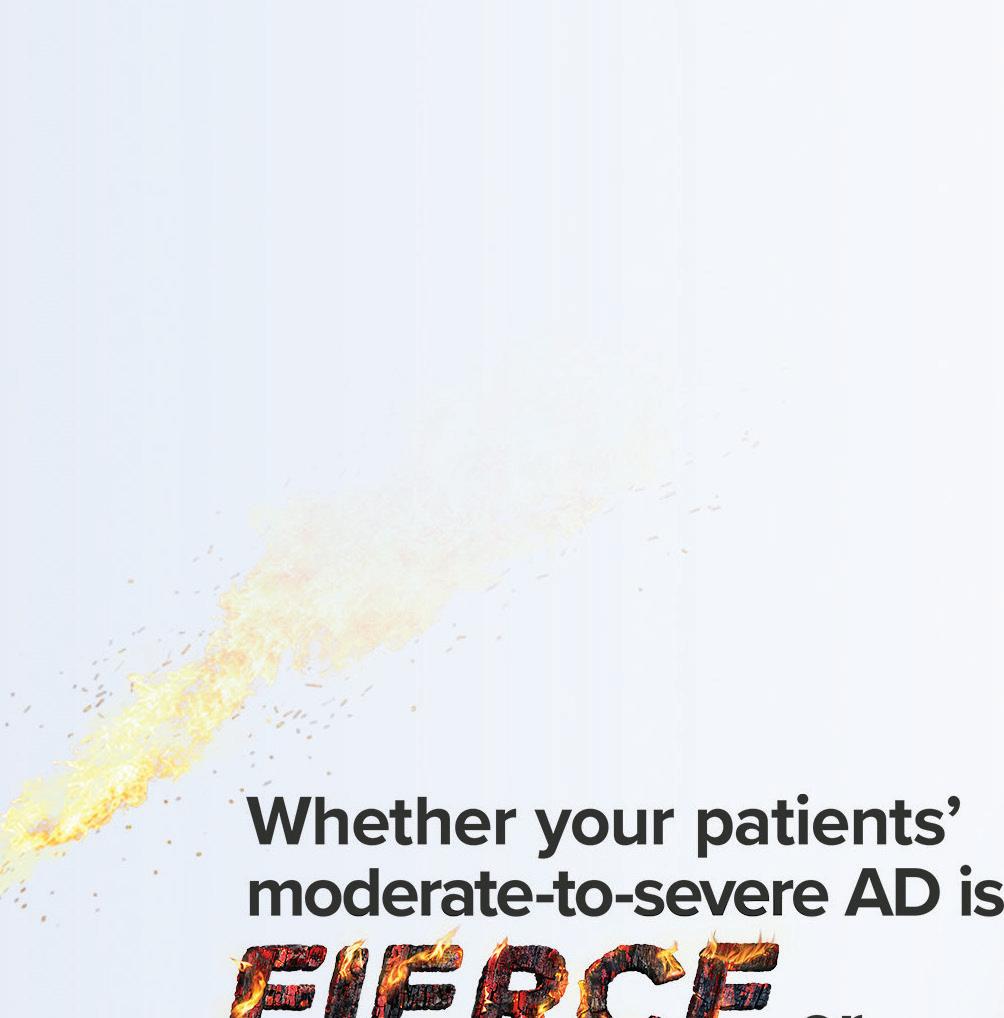





JAK=Janus kinase; AD=atopic dermatitis.
IMPORTANT SAFETY INFORMATION
WARNING: SERIOUS INFECTIONS, MORTALITY, MALIGNANCY, MAJOR ADVERSE CARDIOVASCULAR EVENTS, AND THROMBOSIS
SERIOUS INFECTIONS

Patients treated with CIBINQO may be at increased risk for developing serious infections that may lead to hospitalization or death. The most frequent serious infections reported with CIBINQO were herpes simplex, herpes zoster, and pneumonia.
If a serious or opportunistic infection develops, discontinue CIBINQO and control the infection.
Reported infections from Janus kinase (JAK) inhibitors used to treat inflammatory conditions:
• Active tuberculosis, which may present with pulmonary or extrapulmonary disease. Test for latent TB before and during therapy; treat latent TB prior to use. Monitor all patients for active TB during treatment, even patients with initial negative, latent TB test.
• Invasive fungal infections, including cryptococcosis and pneumocystosis. Patients with invasive fungal infections may present with disseminated, rather than localized, disease.
• Bacterial, viral (including herpes zoster), and other infections due to opportunistic pathogens.





Avoid use of CIBINQO in patients with an active, serious infection, including localized infections. The risks and benefits of treatment with CIBINQO should be carefully considered prior to initiating therapy in patients with chronic or recurrent infections or those who have resided or traveled in areas of endemic tuberculosis or endemic mycoses.
Patients should be closely monitored for the development of signs and symptoms of infection during and after treatment with CIBINQO, including the possible development of tuberculosis in patients who tested negative for latent tuberculosis infection prior to initiating therapy.
Consider yearly screening for patients in highly endemic areas for TB. CIBINQO is not recommended for use in patients with active TB. For patients with a new diagnosis of latent TB or prior untreated latent TB, or for patients with a negative test for latent TB but who are at high risk for TB infection, start preventive therapy for latent TB prior to initiation of CIBINQO.
Viral reactivation, including herpes virus reactivation (eg, herpes zoster, herpes simplex), was reported in clinical studies with CIBINQO. If a patient develops herpes zoster, consider interrupting CIBINQO until the episode resolves.
Hepatitis B virus reactivation has been reported in patients receiving JAK inhibitors. Perform viral hepatitis screening and monitoring for reactivation in accordance with clinical guidelines before starting therapy and during therapy with CIBINQO. CIBINQO is not recommended for use in patients with active hepatitis B or hepatitis C.
To learn more about CIBINQO efficacy, visit CIBINQOhcp.com or scan QR code.
Committed to Patient Support
Helping patients unlock access and reimbursement support for CIBINQO™ (abrocitinib)

pay as little as $ 0 per month*
*Eligibility required. No membership fees. This is not health insurance. The maximum benefit per patient is $15,000 per calendar year. Only for use with commercial insurance. If you are enrolled in a state or federally funded prescription insurance program, you may not use the copay card. See full terms and conditions below.
Copay Savings Card: TERMS AND CONDITIONS
By using the Pfizer Dermatology Patient AccessTM Copay Savings Card, you acknowledge that you currently meet the eligibility criteria and will comply with the terms and conditions described below:
• You are not eligible to use this card if you are enrolled in a state or federally funded prescription insurance program, including but not limited to Medicare, Medicaid, TRICARE, Veterans Affairs health care, a state prescription drug assistance program, or the Government Health Insurance Plan available in Puerto Rico (formerly known as “La Reforma de Salud”).
• You must have commercial insurance. Offer is not valid for cash-paying patients.
• By using this copay card at participating pharmacies, eligible patients with commercial prescription drug insurance coverage for CIBINQO™ (abrocitinib) may pay as little as $0 per month. Eligible patients with commercial prescription drug coverage may receive a maximum benefit of $15,000 per calendar year, which is defined by the date of enrollment through December 31st of the enrollment year. After a maximum of $15,000, you will be responsible for paying the remaining monthly out-of-pocket costs.
• By using this copay card at participating pharmacies, eligible patients with commercial prescription drug insurance coverage for EUCRISA® (crisaborole) may pay as little as $10 per tube. Eligible patients with commercial prescription drug insurance coverage that does not cover EUCRISA may pay as little as $100 per tube. Individual savings are limited to $970 per tube. Individual patient savings are limited to $3,880 in maximum total savings per calendar year.
• This copay card is not valid when the entire cost of your prescription drug is eligible to be reimbursed by your commercial insurance plan or any other health or pharmacy benefit program.
• You must deduct the value of this copay card from any reimbursement request submitted to your commercial insurance plan, either directly by you or on your behalf.
• You are responsible for reporting use of the copay card to any commercial insurer, health plan, or other third party that pays for or reimburses any part of the prescription filled using the copay card, as may be required. You should not use the copay card if your insurer or health plan prohibits use of manufacturer copay cards.
• This copay card is not valid where prohibited by law.
• Copay card cannot be combined with any other savings, free trial, or similar offer for the specified prescription.
• Copay card will be accepted only at participating pharmacies.
• If your pharmacy does not participate, you may be able to submit a request for a rebate in connection with this offer.
• This copay card is not health insurance.
• Offer good only in the United States and Puerto Rico
• Copay card is limited to 1 per person during this offering period and is not transferable.
• A copay card may not be redeemed more than once per 30 days per patient.
• No other purchase is necessary.
• Data related to your redemption of the copay card may be collected, analyzed, and shared with Pfizer, for market research and other purposes related to assessing Pfizer’s programs. Data shared with Pfizer will be aggregated and de-identified; it will be combined with data related to other copay card redemptions and will not identify you.
• Pfizer reserves the right to rescind, revoke, or amend this offer at any time without notice.
• Offer expires 12/31/2025.
For questions or additional support, call 1-833-956-3376, write to Pfizer Inc. at PO Box 29387, Mission, KS 66201, or visit the CIBINQO website at www.CIBINQO.com or the EUCRISA website at www.EUCRISA.com.
Please see additional Important Safety Information and Brief Summary of full Prescribing Information on the following pages. For full Prescribing Information, including BOXED WARNING and Medication Guide, visit CIBINQOhcp.com.
TM With the
eligible commercially insured patients may Visit PDPACopayCard.com
Copay Savings Card,
IMPORTANT
INDICATION
MORTALITY
In a large, randomized postmarketing safety study in rheumatoid arthritis (RA) patients 50 years of age and older with at least one cardiovascular risk factor comparing another JAK inhibitor to TNF blocker treatment, a higher rate of all-cause mortality (including sudden cardiovascular death) was observed with the JAK inhibitor. CIBINQO is not approved for use in RA patients.
MALIGNANCIES
Malignancies, including non-melanoma skin cancer (NMSC), were reported in patients treated with CIBINQO. Lymphoma and other malignancies have been observed in patients receiving JAK inhibitors used to treat inflammatory conditions. Perform periodic skin examination for patients who are at increased risk for skin cancer. Exposure to sunlight and UV light should be limited by wearing protective clothing and using broad-spectrum sunscreen.
In a large, randomized postmarketing safety study of another JAK inhibitor in RA patients, a higher rate of malignancies (excluding non-melanoma skin cancer [NMSC]) was observed in patients treated with the JAK inhibitor compared to those treated with TNF blockers. CIBINQO is not approved for use in RA patients. A higher rate of lymphomas was observed in patients treated with the JAK inhibitor compared to those treated with TNF blockers. A higher rate of lung cancers was observed in current or past smokers treated with the JAK inhibitor compared to those treated with TNF blockers. Patients who are current or past smokers are at additional increased risk.
Consider the benefits and risks for the individual patient prior to initiating or continuing therapy with CIBINQO, particularly in patients with a known malignancy (other than a successfully treated NMSC), patients who develop a malignancy when on treatment, and patients who are current or past smokers.
MAJOR ADVERSE CARDIOVASCULAR EVENTS (MACE)
Major adverse cardiovascular events were reported in patients treated with CIBINQO. In RA patients 50 years of age and older with at least one cardiovascular risk factor treated with another JAK inhibitor, a higher rate of major adverse cardiovascular events (MACE) (defined as cardiovascular death, myocardial infarction, and stroke), was observed when compared with TNF blockers. CIBINQO is not approved for use in RA patients. Patients who are current or past smokers are at additional increased risk. Discontinue CIBINQO in patients that have experienced a myocardial infarction or stroke.
Consider the benefits and risks for the individual patient prior to initiating or continuing therapy with CIBINQO, particularly in patients who are current or past smokers and patients with other cardiovascular risk factors. Patients should be informed about the symptoms of serious cardiovascular events and the steps to take if they occur.
THROMBOSIS
Deep vein thrombosis (DVT) and pulmonary embolism (PE) have been reported in patients treated with CIBINQO. Thrombosis, including PE, DVT, and arterial thrombosis have been reported in patients receiving JAK inhibitors used to treat inflammatory conditions. Many of these adverse reactions were serious and some resulted in death. In RA patients 50 years of age and older with at least one cardiovascular risk factor treated with another JAK inhibitor, a higher rate of overall thrombosis, DVT, and PE were observed when compared with TNF blockers. CIBINQO is not approved for use in RA patients.
Avoid CIBINQO in patients that may be at increased risk of thrombosis. If symptoms of thrombosis occur, discontinue CIBINQO and treat patients appropriately.
CONTRAINDICATION
CIBINQO is contraindicated in patients taking antiplatelet therapies, except for low-dose aspirin (≤ 81 mg daily), during the first 3 months of treatment.
LABORATORY ABNORMALITIES
Hematologic Abnormalities: Treatment with CIBINQO was associated with an increased incidence of thrombocytopenia and lymphopenia.
Prior to CIBINQO initiation, perform a complete blood count (CBC). CBC evaluations are recommended at 4 weeks after initiation and 4 weeks after dose increase of CIBINQO. Discontinuation of CIBINQO therapy is required for certain laboratory abnormalities.
Lipid Elevations: Dose-dependent increase in blood lipid parameters were reported in patients treated with CIBINQO. Lipid parameters should be assessed approximately 4 weeks following initiation of CIBINQO therapy, and thereafter patients should be managed according to clinical guidelines for hyperlipidemia. The effect of these lipid parameter elevations on cardiovascular morbidity and mortality has not been determined.
IMMUNIZATIONS
Prior to initiating CIBINQO, complete all age-appropriate vaccinations as recommended by current immunization guidelines, including prophylactic herpes zoster vaccinations. Avoid vaccination with live vaccines immediately prior to, during, and immediately after CIBINQO therapy.
RENAL IMPAIRMENT
Avoid use in patients with severe renal impairment or end stage renal disease, including those on renal replacement therapy.
HEPATIC IMPAIRMENT
Avoid use in patients with severe hepatic impairment.
ADVERSE REACTIONS
Most common adverse reactions (≥ 1%) in subjects receiving 100 mg and 200 mg include: nasopharyngitis, nausea, headache, herpes simplex, increased blood creatine phosphokinase, dizziness, urinary tract infection, fatigue, acne, vomiting, oropharyngeal pain, influenza, gastroenteritis. Most common adverse reactions (≥ 1%) in subjects receiving either 100 mg or 200 mg also include: impetigo, hypertension, contact dermatitis, upper abdominal pain, abdominal discomfort, herpes zoster, and thrombocytopenia.
Inform patients that retinal detachment has been reported in CIBINQO clinical trials. Advise patients to immediately inform their healthcare provider if they develop any sudden changes in vision.
DRUG INTERACTIONS
Monitor appropriately or dose titrate P-gp substrate where small concentration changes may lead to serious or life-threatening toxicities when coadministered with CIBINQO. See Prescribing Information for clinically relevant drug interactions.
USE IN PREGNANCY
Available data from pregnancies reported in clinical trials with CIBINQO are not sufficient to establish a drug-associated risk for major birth defects, miscarriage, or other adverse maternal or fetal outcomes. Advise females of reproductive potential that CIBINQO may impair fertility.
There is a pregnancy exposure registry that monitors pregnancy outcomes in women exposed to CIBINQO during pregnancy. Pregnant women exposed to CIBINQO and health care providers are encouraged to call 1-877-311-3770 or visit CIBINQOPregnancyRegistry.com.
LACTATION
Advise women not to breastfeed during treatment with CIBINQO and for one day after the last dose.
INDICATION
CIBINQO is indicated for the treatment of adults and pediatric patients 12 years of age and older with refractory, moderate-to-severe atopic dermatitis whose disease is not adequately controlled with other systemic drug products, including biologics, or when use of those therapies is inadvisable. Limitations of Use: CIBINQO is not recommended for use in combination with other JAK inhibitors, biologic immunomodulators, or with other immunosuppressants.
Please see full Important Safety Information throughout and full Prescribing Information, including BOXED WARNING, and Medication Guide.
SAFETY INFORMATION &
© 2023 Pfizer Inc. All rights reserved. May 2023. PP-CIB-USA-0665
WARNING: SERIOUS INFECTIONS, MORTALITY, MALIGNANCY, MAJOR ADVERSE CARDIOVASCULAR EVENTS, and THROMBOSIS
Serious Infections
Patients treated with CIBINQO may be at increased risk for developing serious infections that may lead to hospitalization or death; The most frequent serious infections reported with CIBINQO were herpes simplex, herpes zoster, and pneumonia. If a serious or opportunistic infection develops, discontinue CIBINQO and control the infection. Reported infections from Janus kinase (JAK) inhibitors used to treat inflammatory conditions:
• Active tuberculosis, which may present with pulmonary or extrapulmonary disease. Test for latent TB before and during therapy; treat latent TB prior to use. Monitor all patients for active TB during treatment, even patients with initial negative, latent TB test.
• Invasive fungal infections, including cryptococcosis and pneumocystosis. Patients with invasive fungal infections may present with disseminated, rather than localized, disease.
• Bacterial, viral, including herpes zoster, and other infections due to opportunistic pathogens. Avoid use of CIBINQO in patients with an active, serious infection including localized infections. The risks and benefits of treatment with CIBINQO should be carefully considered prior to initiating therapy in patients with chronic or recurrent infections.
Patients should be closely monitored for the development of signs and symptoms of infection during and after treatment with CIBINQO, including the possible development of tuberculosis in patients who tested negative for latent tuberculosis infection prior to initiating therapy.
Mortality
In a large, randomized, postmarketing safety study in rheumatoid arthritis (RA) patients 50 years of age and older with at least one cardiovascular risk factor comparing another JAK inhibitor to TNF blocker treatment, a higher rate of all-cause mortality, including sudden cardiovascular death, was observed with the JAK inhibitor. CIBINQO is not approved for use in RA patients.
Malignancies
Malignancies were reported in patients treated with CIBINQO. Lymphoma and other malignancies have been observed in patients receiving JAK inhibitors used to treat inflammatory conditions. In RA patients treated with another JAK inhibitor, a higher rate of malignancies (excluding non-melanoma skin cancer (NMSC)) was observed when compared with TNF blockers. Patients who are current or past smokers are at additional increased risk.
Major Adverse Cardiovascular Events
Major adverse cardiovascular events were reported in patients treated with CIBINQO. In RA patients 50 years of age and older with at least one cardiovascular risk factor treated with another JAK inhibitor, a higher rate of major adverse cardiovascular events (MACE) (defined as cardiovascular death, myocardial infarction, and stroke), was observed when compared with TNF blockers. Patients who are current or past smokers are at additional increased risk. Discontinue CIBINQO in patients that have experienced a myocardial infarction or stroke.
Thrombosis
Deep venous thrombosis (DVT) and pulmonary embolism (PE) have been reported in patients treated with CIBINQO. Thrombosis, including PE, DVT, and arterial thrombosis have been reported in patients receiving JAK inhibitors used to treat inflammatory conditions. Many of these adverse reactions were serious and some resulted in death. In RA patients 50 years of age and older with at least one cardiovascular risk factor treated with another JAK inhibitor, a higher rate of thrombosis was observed when compared with TNF blockers. Avoid CIBINQO in patients at risk. If symptoms of thrombosis occur, discontinue CIBINQO and treat appropriately.
INDICATIONS AND USAGE
CIBINQO is indicated for the treatment of adults and pediatric patients 12 years of age and older with refractory, moderate-to-severe atopic dermatitis whose disease is not adequately controlled with other systemic drug products, including biologics, or when use of those therapies is inadvisable.
Limitations of Use CIBINQO is not recommended for use in combination with other JAK inhibitors, biologic immunomodulators, or with other immunosuppressants.
DOSAGE AND ADMINISTRATION
Recommended Testing, Evaluations, and Procedures Prior to Treatment Initiation
Perform the following tests and evaluations prior to CIBINQO initiation:
• Tuberculosis (TB) infection evaluation – CIBINQO initiation is not recommended in patients with active TB. For patients with latent TB or those with a negative latent TB test who are at high risk for TB, start preventive therapy for latent TB prior to initiation of CIBINQO
• Viral hepatitis screening in accordance with clinical guidelines – CIBINQO initiation is not recommended in patients with active hepatitis B or hepatitis C
• A complete blood count (CBC) – CIBINQO initiation is not recommended in patients with a platelet count <150,000/mm3, an absolute lymphocyte count <500/mm3, an absolute neutrophil count <1,000/mm3, or a hemoglobin value <8 g/dL
Complete any necessary immunizations, including herpes zoster vaccinations, in agreement with current immunization guidelines prior to CIBINQO initiation.
Recommended Dosage
The recommended dosage of CIBINQO is 100 mg orally once daily. If an adequate response is not achieved with CIBINQO 100 mg orally daily after 12 weeks, consider increasing dosage to 200 mg orally once daily. Discontinue therapy if inadequate response is seen after dosage increase to 200 mg once daily. CIBINQO can be used with or without topical corticosteroids. If a dose is missed, administer the dose as soon as possible unless it is less than 12 hours before the next dose, in which case skip the missed dose. Thereafter, resume dosing at the regular scheduled time.
Recommended Dosage in Patients with Renal Impairment
Renal Impairment
CIBINQO dosage recommendation in patients with mild renal impairment (60-89 mL/minute) is 100 mg once daily. For patients with moderate renal impairment (30-59 mL/ minute), the recommended dosage is 50 mg once daily.
CIBINQO is not recommended for patients with severe or End-Stage Renal Disease (ESRD). Severe renal impairment and End-Stage Renal Disease include patients on renal replacement therapy.
In subjects with mild and moderate renal impairment, if an adequate response is not achieved after 12 weeks, dose of CIBINQO can be doubled.
CIBINQO is not recommended for patients with severe renal impairment or ESRD.
Recommended Dosage in CYP2C19 Poor Metabolizers
In patients who are known or suspected to be CYP2C19 poor metabolizers, the recommended dosage of CIBINQO is 50 mg once daily. If an adequate response is not achieved with CIBINQO 50 mg orally daily after 12 weeks, consider increasing dosage to 100 mg orally once daily. Discontinue therapy if inadequate response is seen after dosage increase to 100 mg once daily.
Dosage Modifications due to Strong Inhibitors
In patients taking strong inhibitors of cytochrome P450 (CYP) 2C19 reduce the dosage to 50 mg once daily. If an adequate response is not achieved with CIBINQO 50 mg orally daily after 12 weeks, consider increasing dosage to 100 mg orally once daily. Discontinue therapy if inadequate response is seen after dosage increase to 100 mg once daily.
Treatment Discontinuation due to Serious Infections or Hematologic Adverse Reactions
Serious or Opportunistic Infections
If a patient develops a serious or opportunistic infection, discontinue CIBINQO and control the infection. The risks and benefits of treatment with CIBINQO should be carefully considered prior to reinitiating therapy with CIBINQO.
Hematologic Abnormalities
• Discontinue CIBINQO if platelet count <50,000/mm3 and
follow with CBC until >100,000/mm3
• Treatment should be temporarily discontinued if ALC is less than 500 cells/mm3 and may be restarted once ALC return above this value
• Treatment should be temporarily discontinued if ANC is less than 1,000 cells/mm3 and may be restarted once ANC return above this value
• Treatment should be temporarily discontinued if Hb is less than 8 g/dL and may be restarted once Hb return above this value
CBC evaluations are recommended at baseline, 4 weeks after treatment initiation and 4 weeks after dosing increase of CIBINQO. Laboratory evaluations may be extended for patients on chronic CIBINQO therapy who develop hematologic abnormalities.
DOSAGE FORMS AND STRENGTHS
• 50 mg: Pink, oval, film-coated tablet debossed with “PFE” on one side and “ABR 50” on the other.
• 100 mg: Pink, round, film-coated tablet debossed with “PFE” on one side and “ABR 100” on the other.
• 200 mg: Pink, oval, film-coated tablet debossed with “PFE” on one side and “ABR 200” on the other.
CONTRAINDICATIONS
CIBINQO is contraindicated in patients taking antiplatelet therapies, except for low-dose aspirin (≤81 mg daily), during the first 3 months of treatment.
WARNINGS AND PRECAUTIONS
Serious Infections The most frequent serious infections reported in clinical studies with CIBINQO for atopic dermatitis were herpes simplex, herpes zoster, and pneumonia. Serious infections leading to hospitalization or death, including tuberculosis and bacterial, invasive fungal, viral, and other opportunistic infections, have occurred in patients receiving JAK inhibitors used to treat inflammatory conditions.
Avoid use of CIBINQO in patients with active, serious infection including localized infections.
Consider the risks and benefits of treatment prior to initiating CIBINQO in patients:
• with chronic or recurrent infection
• who have been exposed to tuberculosis
• with a history of a serious or an opportunistic infection
• who have resided or traveled in areas of endemic tuberculosis or endemic mycoses
• with underlying conditions that may predispose them to infection
Closely monitor patients for the development of signs and symptoms of infection during and after treatment with CIBINQO. If a patient develops a serious or opportunistic infection, discontinue CIBINQO. Initiate complete diagnostic testing and appropriate antimicrobial therapy. The risks and benefits of treatment with CIBINQO should be carefully considered prior to reinitiating therapy with CIBINQO.
Tuberculosis Evaluate and test patients for TB before starting CIBINQO therapy and consider yearly screening for patients in highly endemic areas for TB. CIBINQO is not recommended for use in patients with active TB. For patients with a new diagnosis of latent TB or prior untreated latent TB, or for patients with a negative test for latent TB but who are at high risk for TB infection, start preventive therapy for latent TB prior to initiation of CIBINQO. Monitor patients for the development of signs and symptoms of TB, including patients who were tested negative for latent TB infection prior to initiating therapy. Viral Reactivation Viral reactivation, including herpes virus reactivation (e.g., herpes zoster, herpes simplex), was reported in clinical studies with CIBINQO. If a patient develops herpes zoster, consider interrupting CIBINQO until the episode resolves.
Hepatitis B virus (HBV) reactivation has been reported in patients receiving JAK inhibitors. Perform viral hepatitis screening and monitoring for reactivation in accordance with clinical guidelines before starting therapy and during therapy with CIBINQO. CIBINQO is not recommended for use in patients with active hepatitis B or hepatitis C. Monitor patients with inactive HBV for expression of HBV DNA during therapy with CIBINQO. If HBV DNA is detected during therapy with CIBINQO, consult a liver specialist.
Mortality
In a large, randomized, postmarketing safety study of another JAK inhibitor in rheumatoid arthritis (RA) patients 50 years of age and older with at least one cardiovascular risk factor, a higher rate of all-cause mortality, including sudden cardiovascular death, was observed in patients
CIBINQO™ (abrocitinib) tablets, for oral use SEE PACKAGE INSERT FOR FULL PRESCRIBING INFORMATION Brief Summary of full Prescribing Information; Initial Approval: January 2022
Mortality (continued)
treated with the JAK inhibitor compared with TNF blockers. CIBINQO is not approved for use in RA.
Consider the benefits and risks for the individual patient prior to initiating or continuing therapy with CIBINQO.
Malignancy and Lymphoproliferative Disorders
Malignancies, including non-melanoma skin cancer (NMSC), were observed in clinical studies with CIBINQO for atopic dermatitis.
Perform periodic skin examination for patients who are at increased risk for skin cancer. Exposure to sunlight and UV light should be limited by wearing protective clothing and using broad-spectrum sunscreen.
Malignancies, including lymphomas, have occurred in patients receiving JAK inhibitors used to treat inflammatory conditions. In a large, randomized, postmarketing safety study of another JAK inhibitor in RA patients, a higher rate of malignancies (excluding non-melanoma skin cancer (NMSC)) was observed in patients treated with the JAK inhibitor compared to those treated with TNF blockers. CIBINQO is not approved for use in RA. A higher rate of lymphomas was observed in patients treated with the JAK inhibitor compared to those treated with TNF blockers. A higher rate of lung cancers was observed in current or past smokers treated with the JAK inhibitor compared to those treated with TNF blockers. In this study, current or past smokers had an additional increased risk of overall malignancies.
Consider the benefits and risks for the individual patient prior to initiating or continuing therapy with CIBINQO, particularly in patients with a known malignancy (other than a successfully treated NMSC), patients who develop a malignancy when on treatment, and patients who are current or past smokers.
Major Adverse Cardiovascular Events
Major adverse cardiovascular events were reported in clinical studies of CIBINQO for atopic dermatitis.
In a large, randomized, postmarketing safety study of another JAK inhibitor in RA patients 50 years of age and older with at least one cardiovascular risk factor, a higher rate of major adverse cardiovascular events (MACE) defined as cardiovascular death, non-fatal myocardial infarction (MI), and non-fatal stroke was observed with the JAK inhibitor compared to those treated with TNF blockers. CIBINQO is not approved for use in RA. Patients who are current or past smokers are at additional increased risk.
Consider the benefits and risks for the individual patient prior to initiating or continuing therapy with CIBINQO, particularly in patients who are current or past smokers and patients with other cardiovascular risk factors. Patients should be informed about the symptoms of serious cardiovascular events and the steps to take if they occur. Discontinue CIBINQO in patients that have experienced a myocardial infarction or stroke.
Thrombosis
Deep venous thrombosis (DVT) and pulmonary embolism (PE) were observed in patients receiving CIBINQO in the clinical studies for atopic dermatitis.
Thrombosis, including DVT, PE, and arterial thrombosis have been reported in patients receiving JAK inhibitors used to treat inflammatory conditions. Many of these adverse reactions were serious and some resulted in death.
In a large, randomized, postmarketing safety study of another JAK inhibitor in RA patients 50 years of age and older with at least one cardiovascular risk factor, higher rates of overall thrombosis, DVT, and PE were observed compared to those treated with TNF blockers. CIBINQO is not approved for use in RA.
Avoid CIBINQO in patients that may be at increased risk of thrombosis. If symptoms of thrombosis occur, discontinue CIBINQO and evaluate and treat patients appropriately.
Laboratory Abnormalities
Hematologic Abnormalities Treatment with CIBINQO was associated with an increased incidence of thrombocytopenia and lymphopenia. Prior to CIBINQO initiation, perform a CBC. CBC evaluations are recommended at 4 weeks after initiation and 4 weeks after dose increase of CIBINQO.
Discontinuation of CIBINQO therapy is required for certain laboratory abnormalities.
Lipid Elevations Dose-dependent increase in blood lipid parameters were reported in patients treated with CIBINQO. Lipid parameters should be assessed approximately 4 weeks following initiation of CIBINQO therapy and thereafter patients should be managed according to clinical guidelines for hyperlipidemia. The effect of these lipid parameter
elevations on cardiovascular morbidity and mortality has not been determined.
Immunizations
Prior to initiating CIBINQO, complete all age-appropriate vaccinations as recommended by current immunization guidelines including prophylactic herpes zoster vaccinations. Avoid vaccination with live vaccines immediately prior to, during, and immediately after CIBINQO therapy.
ADVERSE REACTIONS
The following clinically significant adverse reactions are described elsewhere in the labeling:
• Serious Infections
• Mortality
• Malignancy and Lymphoproliferative Disorders
Clinical Trials Experience
• Major Adverse Cardiovascular Events
• Thrombosis
• Laboratory Abnormalities
Because clinical trials are conducted under widely varying conditions, adverse reaction rates observed in the clinical trials of a drug cannot be directly compared to rates in the clinical trials of another drug and may not reflect the rates observed in practice.
The safety of CIBINQO was evaluated in four randomized, placebo-controlled clinical trials (2 monotherapy, 1 combination therapy with topical corticosteroid, and 1 dose-ranging) and one long-term extension trial in subjects with moderate to severe atopic dermatitis (AD). A total of 1623 subjects with moderate to severe atopic dermatitis were treated with CIBINQO in these clinical trials representing 1428 patient-years of exposure. There were 634 subjects with at least 1 year of exposure to CIBINQO.
In the placebo-controlled clinical trials, a total of 1198 subjects were exposed to CIBINQO with 608 subjects receiving CIBINQO 100 mg once daily and 590 subjects receiving CIBINQO 200 mg once daily for up to 16 weeks. The median age of subjects was 33.0 years, 124 subjects (8.1%) were 12 to less than 18 years old and 94 subjects (6.1%) were 65 years of age or older. The majority of subjects were White (68.7%) and male (53.9%).
Adverse reactions occurring at ≥1% in any of the treated groups and at a higher rate than in the placebo group are presented in the table below. A total of 61 (5.1%) subjects treated with CIBINQO were discontinued from the trials due to adverse reactions. The safety profile of CIBINQO in the monotherapy and the combination trial(s) were similar.
Adverse Reactions from Placebo-Controlled Trials
Reported in ≥1% of CIBINQO Treated Subjects with Moderate to Severe Atopic Dermatitis and at Higher Rate than Placebo for up to 16 Weeks
CIBINQO 200 mg N=590 n (%a)
Weeks 0-16
CIBINQO
Nasopharyngitis 51 (8.7)75 (12.4)27 (7.9)
Nausea 86 (14.5)37 (6.0)7 (2.1)
Headache 46 (7.8)36 (6.0)12 (3.5)
Herpes simplexb 25 (4.2)20 (3.3)6 (1.8)
Increased blood creatine phosphokinase 17 (2.9)14 (2.3)5 (1.5)
Dizziness 17 (2.9)11 (1.8)3 (0.9)
Urinary tract infection 13 (2.2)10 (1.7)4 (1.2)
Fatigue 8 (1.3)10 (1.6)2 (0.5)
Acne 28 (4.7)10 (1.6)0 (0.0)
Vomiting 19 (3.2)9 (1.5)3 (0.9)
Impetigo 3 (0.5)9 (1.5)1 (0.3)
Oropharyngeal pain 6 (1.0)8 (1.4)2 (0.6)
Hypertension 5 (0.8)7 (1.2)2 (0.7)
Influenza 6 (1.1)7 (1.2)0 (0.0)
Gastroenteritis 8 (1.3)7 (1.1)2 (0.6)
Dermatitis contact 3 (0.5)6 (1.1)1 (0.3)
Abdominal pain upper 11 (1.9)4 (0.6)0 (0.0)
Abdominal discomfort 7 (1.2)3 (0.5)1 (0.3)
Herpes zoster 7 (1.2)2 (0.3)0 (0.0)
Thrombocytopenia 9 (1.5)0 (0.0)0 (0.0)
a Study size adjusted percentages b Herpes simplex also includes oral herpes, ophthalmic herpes, herpes dermatitis, genital herpes.
Specific Adverse Reactions
Exposure adjusted incidence rates were adjusted by trial size for all the adverse reactions reported in this section.
Overall Infections In the placebo-controlled trials, for up to 16 weeks, overall infections were reported in 90 subjects (126.8 per 100 patient-years) treated with placebo, 211 subjects (168.8 per 100 patient-years) treated with CIBINQO 100 mg and 204 subjects (159.5 per 100 patient-years) treated with CIBINQO 200 mg. In all 5 clinical trials, including the long-term extension trial, overall infections were reported in 427 subjects (91.8 per 100 patient-years) treated with CIBINQO 100 mg and 394 subjects (103.2 per 100 patient-years) treated with CIBINQO 200 mg.
Serious Infections In the placebo-controlled trials, for up to 16 weeks, serious infections were reported in 2 subjects (2.6 per 100 patient-years) treated with placebo, 6 subjects (3.9 per 100 patient-years) treated with CIBINQO 100 mg, and 2 subjects (1.3 per 100 patient-years) treated with CIBINQO 200 mg. In all 5 clinical trials, including the long-term extension trial, serious infections were reported in 18 subjects (2.3 per 100 patient-years) treated with CIBINQO 100 mg and 16 subjects (2.3 per 100 patient-years) treated with CIBINQO 200 mg. The most commonly reported serious infections were herpes simplex, herpes zoster, and pneumonia.
Herpes Zoster In the placebo-controlled trials, for up to 16 weeks, opportunistic infections were generally cases of multidermatomal cutaneous herpes zoster. Herpes zoster was reported in 0 subjects treated with placebo, 3 subjects (1.9 per 100 patient-years) treated with CIBINQO 100 mg and 8 subjects (5.1 per 100 patient-years) treated with CIBINQO 200 mg. In all 5 clinical trials, including the long-term extension trial, herpes zoster was reported in 16 subjects (2.0 per 100 patient-years) treated with CIBINQO 100 mg and 35 subjects (5.2 per 100 patient-years) treated with CIBINQO 200 mg.
Malignancy In the placebo-controlled trials, for up to 16 weeks, no malignancy was reported in subjects treated with placebo or CIBINQO 100 mg and in 1 patient (0.65 per 100 patient-years) treated with CIBINQO 200 mg. In all 5 clinical trials, including the long-term extension trial, malignancy was reported in 4 subjects (0.5 per 100 patient-years) treated with CIBINQO 100 mg and 2 subjects (0.3 per 100 patient-years) treated with CIBINQO 200 mg.
Thrombosis In all clinical trials, including the long-term extension trial, pulmonary embolism was reported in 3 subjects (0.4 per 100 patient-years), who were treated with CIBINQO 200 mg. Deep vein thrombosis was reported in 2 subjects (0.3 per 100 patient-years) who were treated with CIBINQO 200 mg. No thrombosis occurred in subjects treated with CIBINQO 100 mg.
Major Adverse Cardiovascular Events In the placebocontrolled trials, for up to 16 weeks, major adverse cardiovascular event (MACE) was reported in 1 subject (0.6 per 100 patient-years) treated with CIBINQO 100 mg. In all 5 clinical trials, including the long-term extension trial, MACE was reported in 1 patient (0.1 per 100 patient-years) treated with CIBINQO 100 mg and 2 subjects (0.3 per 100 patient-years) treated with CIBINQO 200 mg.
Thrombocytopenia In the placebo-controlled trials, for up to 16 weeks, treatment with CIBINQO was associated with a dose-related decrease in platelet count. Maximum effects on platelets were observed within 4 weeks, after which the platelet count returned towards baseline despite continued therapy. In all 5 clinical trials, including the long-term extension trial 6 subjects (0.9 per 100 patient-years) treated with CIBINQO 200 mg had adverse reactions of thrombocytopenia, no subjects treated with CIBINQO 100 mg had an adverse reaction of thrombocytopenia.
Lymphopenia In the placebo-controlled trials, for up to 16 weeks, confirmed ALC <500/mm3 occurred in 2 subjects (1.2 per 100 patient-years) treated with CIBINQO 200 mg and 0 subjects treated with CIBINQO 100 mg or placebo. Both cases occurred in the first 4 weeks of exposure.
Lipid Elevations In the placebo-controlled trials, for up to 16 weeks, there was a dose-related percent increase in low-density lipoprotein cholesterol (LDL-c), total cholesterol, and high-density lipoprotein cholesterol (HDL-c) relative to placebo at Week 4 which remained elevated through the final visit in the treatment period. Adverse reactions related to hyperlipidemia occurred in 1 subject (0.6 per 100 patient-years) exposed to CIBINQO 100 mg, 3 subjects (2.0 per 100 patient-years) exposed to CIBINQO 200 mg.
Retinal Detachment In the placebo-controlled trials, for up to 16 weeks, retinal detachment occurred in 1 subject (0.6 per 100 patient-years) treated with CIBINQO 100 mg. In all 5 clinical trials, including the long-term extension trial, retinal detachment occurred in 2 subjects (0.3 per 100 patient-years) treated with CIBINQO 100 mg.
(abrocitinib) tablets, for oral use SEE PACKAGE INSERT FOR FULL PRESCRIBING INFORMATION
CIBINQO™
100 mg N=608 n (%a) PLACEBO N=342 n (%a)
USE IN SPECIFIC POPULATIONS
Specific Adverse Reactions (continued)
Creatine Phosphokinase Elevations (CPK) In the placebocontrolled trials, for up to 16 weeks, events of blood CPK increased were reported in 6 subjects (7.5 per 100 patient-years) treated with placebo, 11 subjects (6.9 per 100 patient-years) treated with 100 mg of CIBINQO and 19 subjects (12.3 per 100 patient-years) treated with 200 mg of CIBINQO. Most elevations were transient, there were no reported adverse reactions of rhabdomyolysis.
Adolescent Subjects (12 to less than 18 years of age) The safety of CIBINQO was assessed in a trial of 284 subjects 12 to less than 18 years of age with moderate-to-severe atopic dermatitis (Trial-AD-4). The safety profile of CIBINQO in these subjects, assessed through the initial treatment period of 12 weeks and the long-term period (213 with at least 52 weeks of abrocitinib exposure), was similar to the safety profile from trials in adults with atopic dermatitis.
DRUG INTERACTIONS
Effects of Other Drugs on CIBINQO
The table below includes drugs with clinically significant drug interactions affecting CIBINQO.
Clinically Significant Drug Interactions Affecting CIBINQO
Strong CYP2C19 Inhibitors
Clinical Impact Coadministration of CIBINQO with strong CYP2C19 inhibitors increases the combined exposure of abrocitinib and its two active metabolites, M1 and M2 which may increase the adverse reactions of CIBINQO.
Intervention Dosage reduction of CIBINQO is recommended when coadministered with strong CYP2C19 inhibitors.
Moderate to Strong Inhibitors of both CYP2C19 and CYP2C9
Clinical Impact Coadministration of CIBINQO with drugs that are moderate to strong inhibitors of both CYP2C19 and CYP2C9 increases the exposure of abrocitinib and its two active metabolites, M1 and M2 which may increase the adverse reactions of CIBINQO.
Intervention Avoid concomitant use of CIBINQO with drugs that are moderate to strong inhibitors of both CYP2C19 and CYP2C9.
Strong CYP2C19 or CYP2C9 Inducers
Clinical Impact
Coadministration of CIBINQO with strong CYP2C19 or CYP2C9 inducers decreases the combined exposure of abrocitinib and its two active metabolites, M1 and M2, which may result in loss of or reduced clinical response.
Intervention Avoid concomitant use of CIBINQO with strong CYP2C19 or CYP2C9 inducers.
Effects of CIBINQO on Other Drugs
The table below includes clinically significant drug interactions affecting other drugs.
Clinically Significant Interactions Affecting Other Drugs
P-gp Substrate Where Small Concentration Changes May Lead to Serious or Life-threatening Toxicities
Clinical Impact Coadministration of CIBINQO with P-gp substrate increases plasma concentrations of P-gp substrates and may result in potential adverse reactions of the P-gp substrate where small concentration changes may lead to serious or life-threatening toxicities (e.g., digoxin).
Pregnancy
Pregnancy Exposure Registry There is a pregnancy exposure registry that monitors pregnancy outcomes in women exposed to CIBINQO during pregnancy. Pregnant women exposed to CIBINQO and health care providers are encouraged to call 1-877-311-3770 or visit CIBINQOPregnancyRegistry.com.
Risk Summary Available data from pregnancies reported in clinical trials with CIBINQO are not sufficient to establish a drug-associated risk for major birth defects, miscarriage, or other adverse maternal or fetal outcomes. In animal reproduction studies, oral administration of abrocitinib to pregnant rats and rabbits during organogenesis at exposure 11 or 4 times the maximum recommended human dose (MRHD) based on AUC comparison, respectively, resulted in maternal dystocia and skeletal variations in rats and no adverse effects in rabbits (see Animal Data).
The background risks of major birth defects and miscarriage for the indicated population are unknown. All pregnancies carry some risk of birth defects, loss, or other adverse outcomes. The background risks in the U.S. general population of major birth defects and miscarriages are 2-4% and 15-20% of clinically recognized pregnancies, respectively.
Animal Data In an embryofetal development study, abrocitinib was administered orally to pregnant rats at doses of 10, 30, or 60 mg/kg/day during the period of organogenesis. No fetal malformations were observed. Abrocitinib increased the incidence of skeletal variations of short 13th ribs at 30 mg/kg/ day (11 times the MRHD based on AUC comparison). Increased embryofetal lethality and additional skeletal variations (cervical arches with reduced ventral processes, thickened ribs, and unossified metatarsals) were noted at 60 mg/kg/day (17 times the MRHD based on AUC comparison).
In an embryofetal development study, abrocitinib was administered orally to pregnant rabbits at doses of 10, 30, or 75 mg/kg/day during the period of organogenesis. No abrocitinib-related maternal or developmental toxicity was noted at doses up to 75 mg/kg/day (4 times the MRHD based on AUC comparison).
In a prenatal and postnatal development study, abrocitinib was administered orally to pregnant rats at doses of 10, 30, and 60 mg/kg/day beginning on gestation day 6 and continuing through lactation day 20. Dystocia with prolonged parturition and reduced offspring body weights were noted at 30 mg/kg/ day (11 times the MRHD based on AUC comparison). Postnatal survival was markedly decreased at 60 mg/kg/day (17 times the MRHD based on AUC comparison). No maternal toxicity was observed at 10 mg/kg/day (2.4 times the MRHD based on AUC comparison). No abrocitinib-related effects on postnatal developmental, neurobehavioral, or reproductive performance of offspring was noted at doses up to 30 mg/kg/ day (11 times the MRHD based on AUC comparison).
Lactation
Risk Summary There are no data on the presence of abrocitinib in human milk, the effects on the breast-fed infant, or the effects on milk production. Abrocitinib was secreted in milk of lactating rats (see Animal Data). When a drug is present in animal milk, it is likely that the drug will be present in human milk. Because of the serious adverse findings in adults, including risks of serious infections, malignancy, and thrombosis, advise women not to breastfeed during treatment with CIBINQO and for one day after the last dose (approximately 5-6 elimination half-lives).
Animal Data Lactating female rats were orally administered a single dose of 10 mg/kg abrocitinib on lactation day 12. Abrocitinib AUC was approximately 5 times greater in milk than in plasma.
Females and Males of Reproductive Potential Infertility Females Based on the findings in rats, oral administration of CIBINQO may impair female fertility. Impaired fertility in female rats was reversible 1 month after cessation of abrocitinib oral administration.
Pediatric Use
Intervention Monitor appropriately or dose titrate P-gp substrate where small concentration changes may lead to serious or life-threatening toxicities when coadministered with CIBINQO.
Antiplatelet Therapy Drugs
Clinical Impact
Coadministration of CIBINQO with antiplatelet therapy drugs may increase the risk of bleeding with thrombocytopenia.
Intervention Antiplatelet drugs, except for low-dose aspirin (≤81 mg daily), during the first 3 months of treatment are contraindicated with CIBINQO.
The safety and effectiveness of CIBINQO in pediatric patients 12 years of age and older weighing 25 kg or more with atopic dermatitis has been established. In trials Trial-AD-1 and Trial-AD-2, 124 adolescent subjects 12 to less than 18 years old with moderate-to-severe atopic dermatitis were enrolled and randomized to receive either CIBINQO 100 mg (N=51), 200 mg (N=48), or matching placebo (N=25) in monotherapy. Additional 284 adolescent subjects 12 to less than 18 years of age with moderate-to-severe atopic dermatitis, were enrolled and randomized to receive either CIBINQO 100 mg (N=95) or 200 mg (N=94) or matching placebo (N=95) in combination with topical corticosteroids in Trial-AD-4. Efficacy and adverse reaction profile were consistent between the pediatric patients and adults.
The safety and effectiveness of CIBINQO have not been established in pediatric patients below 12 years of age.
Juvenile Animal Toxicity Data In a juvenile animal toxicity study, abrocitinib was administered orally to juvenile rats at doses of 5, 25, and 75 mg/kg/day beginning on postnatal day 10 (approximately equivalent to a human infant) and continuing through postnatal day 63 (approximately equivalent to an adolescent). Abrocitinib caused a reversible, dose-related decrease in the primary spongiosa in the metaphysis of the proximal tibia and distal femur. Abrocitinib produced adverse effects on bone development at all dose levels. Abrocitinib caused irreversible dose-related small or misshapen femoral heads at doses ≥5 mg/kg/day (0.8 times the MRHD based on AUC comparison).
Abrocitinib also irreversibly decreased femur size and caused paw malrotation and limb impairment at doses ≥25 mg/kg/day (7.2 times the MRHD based on AUC comparison). At 75 mg/kg/ day (27 times the MRHD based on AUC comparison), paw fractures generally corresponded to limb impairment, a fractured tibia was noted in a single female. Irreversible bone findings have not been observed in older animals.
Geriatric Use
A total of 145 (4.6%) patients 65 years of age and older, while 25 (0.8%) were 75 years of age and older, were enrolled in CIBINQO clinical trials. Clinical trials of CIBINQO did not include sufficient numbers of patients 65 years of age and older to determine whether they respond differently from younger adult patients.
A higher proportion of patients 65 years of age and older discontinued from clinical trials compared to younger patients. Among all patients exposed to CIBINQO, including the long-term extension trial, confirmed ALC <500/mm3 occurred only in patients 65 years of age and older. A higher proportion of patients 65 years of age and older had platelet counts <75,000/ mm3. The incidence rate of herpes zoster in patients 65 years of age and older treated with CIBINQO (7.40 per 100 patient-years) was higher than that of patients 18 to less than 65 years of age (3.44 per 100 patient-years).
Renal Impairment
In patients with severe (eGFR <30 mL/min) and moderate (eGFR 30-59 mL/min) renal impairment, the combined exposure (AUCinf,u) of abrocitinib and its two active metabolites, M1 and M2, is increased compared to patients with normal renal function (eGFR ≥90 mL/min). This may increase the risk of adverse reactions such as infections.
CIBINQO is not recommended for use in patients with severe renal impairment and ESRD including those on renal replacement therapy. A dosage reduction in patient with moderate renal impairment is recommended. No dosage adjustment is required in patients with mild renal impairment (eGFR 60-89 mL/min).
CIBINQO has not been studied in patients on renal replacement therapy. In Phase 3 clinical trials, CIBINQO was not evaluated in patients with atopic dermatitis with baseline creatinine clearance values less than 40 mL/min.
Hepatic Impairment
Avoid use of CIBINQO in patients with severe (Child Pugh C) hepatic impairment.
Dosage adjustment is not required in patients with mild (Child Pugh A) or moderate (Child Pugh B) hepatic impairment based on similar combined exposure (AUCinf,u) of abrocitinib and its two active metabolites, M1 and M2 compared to patients with normal hepatic function. In clinical trials, CIBINQO was not evaluated in patients with severe (Child Pugh C) hepatic impairment.
CYP2C19 Poor Metabolizers
In patients who are CYP2C19 poor metabolizers, the AUC of abrocitinib is increased compared to CYP2C19 normal metabolizers due to reduced metabolic clearance. Dosage reduction of CIBINQO is recommended in patients who are known or suspected to be CYP2C19 poor metabolizers based on genotype or previous history/experience with other CYP2C19 substrates.
OVERDOSAGE
There is no experience regarding human overdosage with CIBINQO. There is no specific antidote for overdose with CIBINQO. In case of an overdose, call Poison Control Center at 1-800-222-1222 for latest recommendations.
Rx only
This brief summary is based on CIBINQO™ (abrocitinib) Prescribing Information LAB-1424-2.0.
Issued: February 2023.
The product’s label may have been updated. For full Prescribing Information, visit CIBINQOPI.com.
See CIBINQO full Prescribing Information at CIBINQOPI.com.
© 2023
Pfizer Inc. All rights reserved. February 2023. PP-CIB-USA-0485 CIBINQO™ (abrocitinib) tablets, for oral use SEE PACKAGE INSERT FOR FULL PRESCRIBING INFORMATION
© 2023 Pfizer Inc. All rights reserved. May 2023. PP-CIB-USA-0485
FEATURES
12 Best Practices EMRs and other helpful technology
20 Unlocking Access
Overcoming patient barriers to provider-administered biologic therapies
48 Expert Advice What BCs can learn from field reimbursement managers
52 Navigating the Future Patient access trends and solutions
COMMUNITY
9 Founder's Letter Removing access barriers
38 BC Spotlight Recognizing outstanding patient service
30 Skin Smarts The Do's and Don'ts of social media skincare trends for teens 40 Cold Therapy The hot healthcare trend 56 Riveting Reads Must-read new releases
ACCESS DERMATOLOGY / ISSUE 9 / 2024 6 contents ACCESS DERMATOLOGY ISSUE 9
LIFESTYLE













12









TOP TIPS FROM FMRS


2 1 3


bcofdermatology.com 7 20 30
48
MISSION STATEMENT:
Access Dermatology aims to educate and empower the biologic coordinator by keeping them informed of the complex and everchanging drug and patient access landscape. Readers are engaged with editorial and lifestyle content equally suitable for dermatologic patients, so they too may gain a better sense of therapies and the patient services programs that can assist in their therapeutic journey.
ACCESS DERMATOLOGY
ISSUE 9 | 2024
EXECUTIVE DIRECTOR
Craig Schuette
EDITOR
Elizabeth Hole
CREATIVE DIRECTOR
Venera Alexandrova
ASSISTANT ART DIRECTOR
Lisa Servidio
PRODUCTION DIRECTOR
Tim Carr
CORRESPONDENCE:
Communications regarding original articles as well as editorial suggestions for future issues should be addressed to Craig Schuette at cs@bcofdermatology.com. Any content forwarded to the publisher assumes no liability for the safety or return of unsolicited art, photographs, or manuscripts.
DISPLAY ADVERTISING:
Contact Craig Schuette at cs@bcofdermatology.com.
PRESIDENT Jonathan W. Moffly
VICE PRESIDENT/BUSINESS Elena V. Moffly
MOFFLY CUSTOM MEDIA
205 Main Street, Westport, CT 06880 telephone: 203-222-0600 email: mail@MofflyCustomMedia.com
Follow the Biologic Coordinators of Dermatology
FACEBOOK LINKEDIN
© 2024 Access Dermatology and Biologic Coordinators of Dermatology. ALL RIGHTS RESERVED. The material in this publication is published by Moffly Custom Media and may not be reproduced or transmitted in any manner, in whole or in part, without the express written permission of Access Dermatology and Moffly Custom Media. NOTICE: The information contained within articles of this magazine represent the views and opinions of the original authors and do not necessarily represent the views and opinions of Access Dermatology or its affiliates. The mere appearance of content in the magazine does not constitute an endorsement by Access Dermatology or its affiliates. The content has been made available for informational and educational purposes only. Editorial advice is not specific, and readers are advised to seek medical, professional, or reimbursement help for individual circumstances. Access Dermatology hereby disclaims all liability to any party for any direct, indirect, implied, punitive, special, incidental, or other consequential damages arising directly or indirectly from any use of the content. CIRCULATION: To be added to the circulation, visit www.bcofdermatolgy.com/ magazine. REPRINTS: For educational, commercial, or promotional reprints, including author off-prints, please email contact@bcofdermatology.com.
ACCESS DERMATOLOGY / ISSUE 9 / 2024 8 A magazine dedicated to supporting patient access with practical information and lifestyle content

letter from the founder Craig
Schuette
Removing Access Barriers
Welcome to the summer edition of Access Dermatology from the BCoD community.
Summer symbolizes life's abundance, a season of vitality and rejuvenation. Yet, amid its splendor, many patients face barriers hindering their journey toward wellness.
In this issue, we spotlight the importance of nurturing industry relationships and harnessing technology to enhance patient access. Together, let's explore pathways that break down barriers and extend the healing reach of healthcare.
As part of our ongoing commitment to our membership Academy, we're excited to announce that the BCoD certificate program is now accessible to all members. Additionally, this year, we introduce a unique workshop, exclusively available at our October conference. This workshop aims to guide attendees in optimizing office structures for improved efficiency in biologic patient care and collaboration among peers. While such training typically costs more than $1,000 for a
dermatologist's practice, our BC experts are offering it at no charge. Moreover, conference registration fees are waived, further exemplifying our dedication to removing access barriers, even to our conference.
Our national conference—taking place in Orlando from October 27 to 29—serves as a platform for hundreds of biologic coordinators and office access staff to engage in crucial discussions, paving the way for enhanced drug access.
For more information, visit our website at bcofdermatology.com. We eagerly anticipate your presence in Orlando, where patient dedication intersects professional growth and community.
CRAIG SCHUETTE

bcofdermatology.com 9



DOWN TO AGE 9
Effectively control seborrheic dermatitis and simplify treatment with a steroid-free foam.1

One foam. Once a day. Anywhere.1
SebDone.

DRAMATIC 77% IGA SUCCESS AT WEEK 81,2



Trial 203 and STRATUM studies evaluated ZORYVE (n=458) vs vehicle (n=225) once daily for 8 weeks in patients with seborrheic dermatitis. The primary endpoint was IGA Success at Week 8, defined as a score of Clear (0) or Almost Clear (1) and a ≥2-grade improvement from baseline.
ZORYVE is for topical use only and not for ophthalmic, oral, or intravaginal use.1
IGA = Investigator Global Assessment

A 2023 Arcutis survey of 93 adults diagnosed with seborrheic dermatitis found that an average of 15 products (including over-the-counter, alternative, and prescription treatments) were reportedly used on a yearly basis. 2 INDICATION
ZORYVE foam, 0.3%, is indicated for the treatment of seborrheic dermatitis in adult and pediatric patients 9 years of age and older.
IMPORTANT SAFETY INFORMATION
ZORYVE is contraindicated in patients with moderate to severe liver impairment (Child-Pugh B or C).
Flammability: The propellants in ZORYVE are flammable. Avoid fire, flame, and smoking during and immediately following application.
The most common adverse reactions (≥1%) include nasopharyngitis (1.5%), nausea (1.3%), and headache (1.1%).
Please see brief summary of full Prescribing Information for ZORYVE foam on the following page.
References: 1. ZORYVE® foam. Prescribing information. Arcutis Biotherapeutics, Inc; 2023. 2. Data on File. Arcutis Biotherapeutics, Inc.
© 2024 Arcutis Biotherapeutics, Inc. All rights reserved. US-COM-154-00125 01/24
See the results at zoryvehcp.com/foam
NOW AVAILABLE! ®
Actor portrayal



Brief Summary of Prescribing Information for ZORYVE® (roflumilast) foam, 0.3%, for topical use. See package insert for full Prescribing Information.
INDICATIONS AND USAGE
ZORYVE foam, 0.3%, is indicated for the treatment of seborrheic dermatitis in adult and pediatric patients 9 years of age and older.
DOSAGE AND ADMINISTRATION
Shake can prior to each use. Apply a thin layer of ZORYVE foam, 0.3%, once daily to affected areas on skin and/or scalp when they are not wet. Rub in completely.
Wash hands after application.
Avoid fire, flame, and smoking during and immediately following application. ZORYVE foam, 0.3%, is for topical use only and not for ophthalmic, oral, or intravaginal use.
CONTRAINDICATIONS
ZORYVE foam, 0.3%, is contraindicated in patients with moderate to severe liver impairment (Child-Pugh B or C).
WARNINGS AND PRECAUTIONS
Flammability
The propellants in ZORYVE foam, 0.3%, are flammable. Avoid fire, flame, and smoking during and immediately following application.
ADVERSE REACTIONS
Clinical Trials Experience
Because clinical trials are conducted under widely varying conditions, adverse reaction rates observed in the clinical trials of a drug cannot be directly compared to rates in the clinical trials of another drug and may not reflect the rates observed in practice.
In two multicenter, randomized, double-blind, vehicle-controlled trials (Trial 203 and STRATUM), 683 adult and pediatric subjects 9 years of age or older with seborrheic dermatitis were treated with ZORYVE foam, 0.3%, or vehicle foam once daily for 8 weeks. The combined trial population was 79% White, 11% Black, and 5% Asian; for ethnicity, 79% identified as non-Hispanic/Latino and 21% identified as Hispanic/Latino. Fifty percent (50%) were male and 50% were female. The median age was 41 years (range 9 to 87 years). The median body surface area (BSA) affected was 2.5%.
Table 1 presents adverse reactions that occurred in at least 1% of subjects treated with ZORYVE foam, 0.3%.
Table 1: Adverse Reactions Reported in ≥1% of Subjects with Seborrheic Dermatitis Treated with ZORYVE Foam, 0.3%, for 8 Weeks in Trial 203 and Trial STRATUM
Adverse Reaction ZORYVE foam, 0.3% (N=458) n (%) Vehicle foam (N=225)
(0)
The following additional adverse reactions were reported in fewer than 1% of subjects treated with ZORYVE foam, 0.3%: diarrhea and insomnia.
In 408 subjects who continued treatment with ZORYVE foam, 0.3%, for up to 24 to 52 weeks in an open-label, long-term trial, the adverse reaction profile was consistent with that observed in vehicle-controlled trials.
USE IN SPECIFIC POPULATIONS
Pregnancy
Risk Summary
There are insufficient data available on the use of ZORYVE foam, 0.3%, in pregnant women to inform a drug-associated risk of major birth defects, miscarriage, or other adverse maternal or fetal outcomes. In animal reproduction studies, roflumilast administered orally to pregnant rats and rabbits during the period of organogenesis produced no fetal structural abnormalities at doses up to 30 and 26 times the maximum recommended human dose (MRHD), respectively. Roflumilast induced post-implantation loss in rats at oral doses greater than or equal to 10 times the MRHD. Roflumilast induced stillbirth and decreased pup viability in mice at oral doses 16 and 49 times the MRHD, respectively. Roflumilast has been shown to adversely affect pup post-natal development when dams were treated with an oral dose 49 times the MRHD during pregnancy and lactation periods in mice.
The background risk of major birth defects and miscarriage for the indicated population is unknown. In the U.S. general population, the estimated background risk of major birth defects and miscarriage in clinically recognized pregnancies is 2% to 4% and 15% to 20%, respectively.
Clinical Considerations
Labor and delivery
Avoid using ZORYVE foam, 0.3%, during labor and delivery. There are no human studies that have investigated effects of ZORYVE foam, 0.3%, on preterm labor or labor at term; however, animal studies showed that oral roflumilast disrupted the labor and delivery process in mice.
Data
Animal data
In an embryo-fetal development study, pregnant rats were dosed orally during the period of organogenesis with up to 1.8 mg/kg/day roflumilast (30 times the MRHD on a mg/m2 basis). No evidence of structural abnormalities or effects on survival rates were observed. Roflumilast did not affect embryo-fetal development at a maternal oral dose of 0.2 mg/kg/day (3 times the MRHD on a mg/m2 basis).
In a fertility and embryo-fetal development study, male rats were dosed orally with up to 1.8 mg/kg/day roflumilast for 10 weeks and females for 2 weeks prior to pairing and throughout the organogenesis period. Roflumilast induced pre- and post-implantation loss at maternal oral doses greater than or equal to 0.6 mg/kg/day (10 times the MRHD on a mg/m2 basis). Roflumilast did not cause fetal structural abnormalities at maternal oral doses up to 1.8 mg/kg/day (29 times the MRHD on a mg/m2 basis).
In an embryo-fetal development study in rabbits, pregnant does were dosed orally with 0.8 mg/kg/day roflumilast during the period of organogenesis. Roflumilast did not cause fetal structural abnormalities at the maternal oral doses of 0.8 mg/kg/day (26 times the MRHD on a mg/m2 basis).
In pre- and post-natal developmental studies in mice, dams were dosed orally with up to 12 mg/kg/day roflumilast during the period of organogenesis and lactation. Roflumilast induced stillbirth and decreased pup viability at maternal oral doses greater than 2 mg/kg/day and 6 mg/kg/day, respectively (16 and 49 times the MRHD on a mg/m2 basis, respectively). Roflumilast induced delivery retardation in pregnant mice at maternal oral doses greater than 2 mg/kg/day (16 times the MRHD on a mg/m2 basis). Roflumilast decreased pup rearing frequencies at a maternal oral dose of 6 mg/kg/day during pregnancy and lactation (49 times the MRHD on a mg/m2 basis). Roflumilast also decreased survival and forelimb grip reflex and delayed pinna detachment in mouse pups at a maternal oral dose of 12 mg/kg/day (97 times the MRHD on a mg/m2 basis).
Lactation
Risk Summary
There are no data on the presence of roflumilast or its metabolite in human milk, the effects on the breastfed infant, or the effects on milk production.
Roflumilast and/or its metabolites are excreted into the milk of lactating rats. When a drug is present in animal milk, it is likely that the drug will be present in human milk. The developmental and health benefits of breastfeeding should be considered along with the mother’s clinical need for ZORYVE foam, 0.3%, and any potential adverse effects on the breastfed infant from ZORYVE foam, 0.3%, or from the underlying maternal condition.
Clinical Considerations
To minimize potential exposure to the breastfed infant via breast milk, use ZORYVE foam, 0.3%, on the smallest area of skin and for the shortest duration possible while breastfeeding. To avoid direct infant exposure, advise breastfeeding women not to apply ZORYVE foam, 0.3%, directly to the nipple or areola. If applied to the patient’s chest, avoid exposure via direct contact with the infant’s skin.
Data
Animal data
Roflumilast and/or its metabolite concentrations measured 8 hours after an oral dose of 1 mg/kg given to lactating rats were 0.32 and 0.02 mcg/g in the milk and pup liver, respectively.
Pediatric Use
The safety and effectiveness of ZORYVE foam, 0.3%, for the treatment of seborrheic dermatitis have been established in pediatric patients 9 years of age and older. Use of ZORYVE foam, 0.3%, in this age group is supported by data from two 8-week, vehiclecontrolled trials which included 32 pediatric subjects 9 to 17 years of age, of whom 17 received ZORYVE foam, 0.3%, and from open-label trials of up to 52 weeks which included 23 pediatric subjects treated with ZORYVE foam, 0.3%. The adverse reaction profile was consistent with that observed in adults.
The safety and effectiveness of ZORYVE foam, 0.3%, in pediatric patients below the age of 9 years have not been established.
Geriatric Use
Of the 683 subjects with seborrheic dermatitis exposed to ZORYVE foam, 0.3%, or vehicle for up to 8 weeks in the controlled clinical trials, 98 (14%) were 65 years of age or older, and 33 (5%) were 75 years of age or older. No overall differences in safety or effectiveness were observed between these subjects and younger subjects, and other reported clinical experience has not identified differences in responses between the elderly and younger patients, but greater sensitivity of some older individuals cannot be ruled out.
Hepatic Impairment
Oral roflumilast 250 mcg once daily for 14 days was studied in subjects with hepatic impairment. The systemic exposure of roflumilast and roflumilast N-oxide were increased in subjects with moderate (Child-Pugh B) hepatic impairment. ZORYVE foam, 0.3%, is contraindicated in patients with moderate to severe liver impairment (ChildPugh B or C). No dosage adjustment is needed in patients with mild (Child-Pugh A) hepatic impairment.
PATIENT COUNSELING INFORMATION
Advise the patient or caregiver to read the FDA-approved patient labeling (Patient Information).
Flammability
Because the propellants in ZORYVE foam, 0.3%, are flammable, instruct the patient to avoid fire, flame, and smoking during and immediately following application.
Lactation
Advise patients to use ZORYVE foam, 0.3%, on the smallest area of skin and for the shortest duration possible while breastfeeding. Instruct patients who are breastfeeding not to apply ZORYVE foam, 0.3%, directly to the nipple or areola to avoid direct infant exposure. Instruct patients to avoid inadvertent contact of treated areas with infant skin.
7
0
0
n (%) Nasopharyngitis
(1.5) 1 (0.4) Nausea 6 (1.3)
(0) Headache 5 (1.1)
© 2024 Arcutis Biotherapeutics, Inc. All rights reserved.
“Neo” Cuellar CCMS, PACS, FRONTIER DERMATOLOGY

RAWF8STOCK.ADOBE.COM
Neomia

Best Practices
EMRS AND OTHER HELPFUL TECHNOLOGY
For most practices, working with an Electronic Medical Record (EMR) or A.K.A. Electronic Health Record (EHR) are a daily part of our lives. There are many options to choose from, and they all have different but similar features. The goal of most EMRs is to keep a patient chart organized, secure and easy to update. Regardless of what you utilize, there are best practices to keep in mind when it comes to technology.
To use an EMR effectively as a biologic coordinator (BC), there are important elements to determine how your EMR can align and be successful for your needs.
bcofdermatology.com 13
One of the biggest burdens for a biologic coordinator, even some of the most senior BCs, is not getting what they need to fight the insurance company in the note. Maybe it’s because the provider prematurely finalized the visit note before they were able to finish. Alternatively, it could be a more prevalent reason—the staff is new or doesn’t know what needs to go into a specialty drug note. With so much office turnover and high burnout rates, the note may not have all the key points to fight for PA approvals. Some best practices to help staff, both new and senior, get important tips or prompts into a note so they are not forgotten is to use the EMR’s features to assist. I use EMA by Modernizing Medicine. EMA’s features that help with this is “Protocols.” Whether I am consulting for practices and setting up their system or managing my own, Protocols helps both intra-office flow for an MA or scribe in the
room and getting the information a BC needs to fight an insurance company. Where it can take a scribe/MA over 10 minutes to complete a specialty drug note, Protocols can complete it after four to five clicks.
To put it in perspective, every specialty drug has its own protocol that over 90% of the staff can use. I know from experience this can be done to facilitate any provider/office load, because I’ve set up practices who have had only a couple providers all the way up to one of the largest groups with more than 100 providers. Even with multiple providers, it’s all in how the protocol is set up. First of all, keep in mind the “the basics.” What details does everyone use in the practice for every patient? Then, what can we set up to be easy for a scribe/MA to personalize?
In most groups, we all use the Plan of Counseling, and in EMA every specialty drug (biologics, PDE, JAK, etc.) has its own

“Some best practices to help staff, both new and senior, get important tips or prompts into a note so they are not forgotten is to use the EMR’s features

KEY FACTORS WHEN USING AN EMR 1 Get staff to use and easily get tips and important topics into the patient chart 2 Tracking system 3 Communication with office staff 4 Easy resource accessibility (Manufacturer Enrollment Forms) 5 ePA
WHEN SETTING UP A PROTOCOL, ENSURE IT HAS THE FOLLOWING:
An impression of whatever the diagnosis is (Ex: Psoriasis)
Plan of counseling
Plan of the medication initiation
(Ex: Skyrizi Initiation)
Within this plan, I use the first screen, “Indications,” to add the PA tips that an MA or scribe can simply select on or off, then remember and type from scratch in every note. This is what cuts down on time spent doing a note and gets the information I need as a BC.
A plan of order tests with the bare minimum that everyone uses
(Ex: QuantiFERON).
I include “Order Tests” because the newer MAs will not forget the patient needs a labs req. Help them remember the basics for your office, as it's always easier to add to something already in the note than to start it from scratch. If the provider wants more labs, simply select “Resume Plan” and add the additional labs per that provider.

When a protocol is in place, as soon as the provider says the drug name, all the MA/scribe has to do (on the iPad) is select the “More” tab at the top right, select “Protocols,” choose the medication protocol they need and select “Save.” Then with literally five clicks, MOST of the note is complete. After that step, they need to add a BSA, Severity and make sure they include tried and failed drugs, or anything personalized to that patient.
While in the room and doing the note, remember to get the medication enrollment form signed. This is sometimes forgotten, or signatures are missed. Each form may or may not have one or more areas a patient has to sign. In addition, we must capture the provider’s signature. Then, at some point during the day, completely fill out each section.
When we have a busy schedule, this is time consuming because the forms aren’t usually kept in the rooms. We have to leave to grab the form and get “wet” signatures. I know myself and coworkers, in the past,
after we’ve completed our duties of closing rooms down for the day and cleaning up, we can’t just go home. We then have to gather the enrollment forms from the day and finish filling them out and faxing them.
To help intraoffice flow of this enrollment form juggling, some EMRs have a way to integrate forms into the system and collect signatures on the iPads. In addition to not having to leave the room, some also fill out the forms for the staff, allowing us to capture data, get signatures and eFax, all without leaving the visit. In EMA, this feature is found in the “PDF Manager” area of the “More” tab on the iPad.
Employees are happy they can just go home at the end of the day, leading to less burnout. The forms do need to be prepared with “SMART Data” and uploaded by an administrative staff member to complete these steps. If you are unsure how to do this, you are lucky to be a BCoD member, because we can help. Just reach out!
Another pitfall could be forgetting to start the PA, since there was not a way to send communication to yourself or others that it is needed. Some staff keep the signed paper enrollment forms, but from personal experience, there are times these get misplaced or lost and we don’t go through with PA because there was not a reminder. When a provider makes a decision for a specialty drug, we need to find a way to remember it needs to be done. In some EMRs they have a feature to prevent these types of issues.
bcofdermatology.com 15 STOCK PIXSTOCK.ADOBE.COM

One way to send myself a reminder that a PA is needed, or for staff to let me know without having to physically find me in the office, is to “Create Task” in the EMA system. Other EMRs may have a feature like this, where the staff member opens it up and puts the details of what is needed to be done and it is sent to me or whoever is responsible for the PA. If this isn’t an option, before “Tasks” were available as a feature, I would send myself an intra-mail.
A tracking system is a must, and I know many who still keep a paper log or use Excel. I always think, “What if the paper log gets misplaced or destroyed?” If your EMR system has a tracking platform, find out if it can be used so others can see updates and progress about the PA journey to translate information to patients or help out when needed. In my EMA system, we use the “Task” area for this. You can use “Chart Notes,” but I adore “Tasks” because there is
accountability, and everything is in one place. There is no clicking in and out to find out what happened, and nothing can be changed or misdated without a time stamp and history of change that was made.
One enhancement that many systems have available now is the ability to actually do a prior authorization in their EMR. Most are known as an “ePA.” This can prompt the user that a PA is needed for the medication and has its own designated area in the EMR to access the scripts needing PAs. The benefit of being able to do a PA from inside the system is that it already has all the information at the tips of the staff’s fingertips: insurance, note, demographics and more. Once a decision is made, you can easily integrate into the patient chart.
Some systems may be more limiting than others; however, they have really evolved over the last decade. I understand you all don’t have EMA as I do, but if you read about
a feature that you and the staff can benefit from, call your EMR rep. There may be a feature already in your system, and you don’t even know about it yet. If not, whomever you use may be able to take the feature idea and develop it for you and other users across the country in a future update.
Many of us who have been in our position for over a decade have a difficult time adapting our system to an electronic PA process. No one said you have to change everything, but knowing how an EMR can work for you and your PAs could allow a better flow, faster decision turnaround, and improved drug to patient timing, so they have a chance to get better sooner.
The only constant in life is change. Start with baby steps in each area if you need and remember: BCoD is here for you. We have resources and programs in place to help you enhance, elevate, and understand any part of the PA journey.
ACCESS DERMATOLOGY / ISSUE 9 / 2024 16 PANDPSTOCK001STOCK.ADOBE.COM
Submitting PHARMACY Accessible Download Address Submitting Prescriptions PHARMACY ADDRESS Accessible in Most Download our referral ahrx.co/AH-referrals ePrescribe Dial 800.511.5144 speak directly Fax Send


>
>

>

As a national comprehensive specialty pharmacy, we are transforming lives with compassionate care by serving patients living with complex medical conditions. We put patients first and improve health outcomes.
Provider Services


> Referrals via phone, fax, and e-prescription
> Prior authorization completion
> Single point of contact to guide your team
> Support for your patients, including copay assistance
> Appeals support and guidance



patients served each month of patients report high satisfaction based on proprietary patient data collection
















































patients engaged with our digital solutions, including text, psychographics, etc. of those patients achieve optimal therapy adherence based on proprietary patient data collection

We
© 2024 AcariaHealth. All rights reserved.
Are AcariaHealth
45K+ 98% 35K+ 90%+
AcariaHealth Family of Pharmacies Submitting Prescriptions PHARMACY ADDRESS Accessible in Most EMR Systems
our referral forms:Download our drug list: ahrx.co/AH-referrals ahrx.co/AH-drug-list ePrescribe
Download
Find
your electronic medical record
system
Call
AcariaHealth in
(EMR)
Phone
Dial 800.511.5144 Ext 608.0033
directly to our pharmacists
Send completed referral form via fax to 877.541.1503 Send Us a Fax 877.541.1503 Address ahrx.com/AH-referrals Download our referral forms: Prescriptions ADDRESS Most EMR Systems referral forms:Download our drug list: ahrx.co/AH-referrals ahrx.co/AH-drug-list ePrescribe
to speak
Fax >
your electronic medical record
800.511.5144 Ext 608.0033
directly to our pharmacists
> Find AcariaHealth in
(EMR) system
to
Fax
Send completed referral
via fax to 877.541.1503 Send Us a Fax 877.541.1503 ahrx.com/AH-drug-list Download our drug list: Contact us today to learn more about our DERMATOLOGY services sales@acariahealth.com | Phone: 800.511.5144 | Fax: 877.541.1503 or visit us at AcariaHealth.com
form
CONFERENCE
NOW OPEN
REGISTER TODAY FOR THE CONFERENCE FOR BIOLOGIC COORDINATORS
OCTOBER 27-29, ORLANDO, FL | JW MARRIOTT BONNET CREEK
Join us at the BCoD 2024 Conference for an unmatched opportunity to grow your career in dermatology patient access. This event is perfect for biologic coordinators, medical assistants, and healthcare workers looking to enhance patient access in dermatology. With innovative workshops, learning opportunities, and the chance to network with experts, this conference is your key to unlocking new professional heights. Take advantage of this chance to connect with peers and boost your skills.
BENEFITS YOU CAN EXPECT
NEW LEARNING PATHS
Customized sessions for every career phase
HANDS-ON WORKSHOPS
Interact with experts to improve your skills
EXCLUSIVE EARLY BIRD SPECIAL:
CAREER GROWTH
Elevate your career with cutting-edge knowledge
NETWORKING
Connect with peers and industry leaders in an engaging environment
Be one of the first 100 members to register and book your hotel room to receive exclusive BCoD or FIGS gear. Don’t miss the chance to enhance your conference experience with these special perks!


REGISTRATION
Learn More and Register Today! BCOFDERMATOLOGY.COM




Unlocking Access

OVERCOMING PATIENT BARRIERS TO PROVIDER-ADMINISTERED BIOLOGIC THERAPIES
ACCESS DERMATOLOGY / ISSUE 9 / 2024 20
TOMBAKYSTOCK.ADOBE.COM
By Jason Zemcik VICE PRESIDENT, HEAD OF PRODUCT, POLICY REPORTER

Amidst the ever-changing healthcare landscape, patient access to provideradministered biologic drugs remains a constant challenge. These groundbreaking therapies offer tremendous promise in treating complex diseases, ranging from autoimmune disorders to cancer. However, their high cost, coupled with administrative hurdles, often creates barriers to patient access that leave patients grappling with their health and financial well-being. Three significant challenges in this area also present opportunities for providers’ staff. Through innovative strategies, both in conjunction with pharmaceutical manufacturers and technology providers, providers can reimagine access solutions to better serve patients.
NARISSAWANSTOCK.ADOBE.COM
OVERCOMING INCREASING DENIALS DUE TO CHANGING PAYER REQUIREMENTS
Healthcare executives cite payer reimbursements across all lines of business as a top challenge their organizations are facing.
A recent study by the American College of Healthcare Executives revealed that 66% of hospital CEOs see managed care and other commercial payments as a top financial concern. Medicaid (51%) and Medicare (51%) followed closely behind.
Revenue Cycle Management as a whole (52%) also made the list of CEOs top financial concerns.
Compounding matters, workforce challenges ranked as the top overall area of concern among survey respondents. The additional personnel hours required to address payer reimbursement complexities in the form of appeals, resubmissions, and ensuring proper documentation contributes heavily to this.
Claim denials contribute prominently to challenges in both areas. According to a recent national survey conducted by Premier, Inc., 15% of medical claims submitted to private payers for reimbursement are initially denied.
Additionally, 3.2% of all claims denied included those that were pre-approved via the prior authorization process. On average, providers incur nearly $44 of staff administrative time costs per denial in the form of resolution and resubmission work necessary to pursue a paid claim.
The 2022 Experian Healthcare State of Claims report indicated that 67% of surveyed providers consider claims management more important now than prior to the COVID-19 pandemic due to payer policy changes occurring more frequently.
Providers are actively seeking solutions to aid their efforts in this area. At the 2023 Healthcare Financial Management Association Annual Conference, a roundtable of revenue cycle leaders discussed how their organizations are addressing the impact of payer changes and denials. A common theme was having proactive solutions that educate staff on how to avoid claim issues.
Policy Reporter is assisting provider organizations in this way through our Payer Compliance Dashboard. This tool provides a curated view of key payer requirements, from payers of interest and filterable by geography to line of business and other characteristics. The interface gives staff a streamlined way to remain up to date

on constantly changing requirements, as opposed to scouring the internet and combing through documents for claim submission criteria and documentation requirements.
EVOLVING FINANCIAL SUPPORT PROGRAMS AND MITIGATING THE IMPACT OF DISRUPTION TACTICS
Specialty drugs, specifically biologics, can come with hefty price tags. This places immense financial strain on patients. Despite advancements in insurance coverage, out-of-pocket costs remain exorbitant for many individuals, leaving them with daunting decisions regarding their treatment. High deductibles, copayments, and coinsurance requirements further exacerbate this issue.
According to the Kaiser Family Foundation 2023 Employer Health Benefits Survey, over the last five years, the percentage of covered workers with a general annual deductible of $2,000 or more for single coverage has grown from 26% to 31%. Such coverage situations force patients to navigate a maze of financial barriers before receiving essential care. For patients, the financial burden of biologic therapies extends beyond dollars, to impact every aspect of their lives. Many face the gut-wrenching dilemma of choosing between purchasing life-saving medications or meeting other basic needs, such as housing and food. This financial
“According to a recent national survey conducted by Premier, Inc., 15% of medical claims submitted to private payers for reimbursement are initially denied."
G_STOCKERTHAILANDSTOCK.ADOBE.COM
ACCESS DERMATOLOGY / ISSUE 9 / 2024 22
“Through innovative strategies, both in conjunction with pharmaceutical manufacturers and technology providers, providers can reimagine access solutions to better serve patients."
strain not only jeopardizes their physical health but also takes a toll on their mental and emotional well-being, leading to heightened stress and anxiety.
To alleviate the financial burden on patients, providers' office staff play a pivotal role in exploring avenues for financial assistance. They can proactively engage with patients to assess their insurance coverage, identify available patient assistance programs such as manufacturer-sponsored copay assistance, Patient Assistance Programs (PAP) or free goods, or charitable foundation assistance, and guide them through the process of applying for and utilizing these resources.
Manufacturer programs are becoming increasingly more generous. A recent study by Mercalis, Policy Reporter’s parent company, which designs and operates patient support services programs on behalf of pharmaceutical manufacturers, found that 56% of manufacturer PAPs reviewed had eligibility criteria at or above 500% of the Federal Poverty Level (FPL). These programs are not without their challenges, though. Copay accumulators and maximizers are widely known among providers’ staff as being a thorn in the side of patient access and affordability. However, Alternate Funding Programs, also known as Specialty Carve Outs, are also permeating the space and disrupting patients’ ability to begin therapy in a timely manner and remain adherent.

There are several solutions to these problems, in the form of alternate patient payment methods and direct reimbursements, as well as letters of eligibility verification to avoid AFP issues. These are most commonly put in place by the manufacturer sponsoring the program.
A key element of success lies in the providers’ staff maintaining proactive and frequent communication with the pharmaceutical manufacturers’ field teams.
“I text my FRM (field reimbursement manager) multiple times a day. If I ever have an issue, I have them on speed dial,” said one practice financial coordinator. By maintaining this open communication, staff can work to address each unique patient situation and implement alternate financial solutions before the patient’s treatment schedule is disrupted.
IDENTIFYING CREATIVE WAYS TO OVERCOME LOGISTICAL BARRIERS TO TREATMENT
Beyond financial and insurance-related challenges, logistical barriers are significant hurdles for patients seeking treatment from provider-administered biologic drugs. These therapies often require specialized handling, such as refrigeration or intravenous infusion, necessitating concise coordination with healthcare facilities and home healthcare services. Transportation constraints, particularly for patients residing in rural or underserved areas, further complicate access to treatment. Limitations in physically accessing sites of care inhibit patients’ ability to be adherent to a prescribed treatment regimen.
Logistical barriers impede patients' access by disrupting their treatment schedules and compromising therapeutic outcomes. Missed appointments due to transportation challenges or logistical constraints such as caretaker availability can lead to treatment interruptions, exacerbating disease progression and diminishing efficacy. Moreover, the added stress of navigating logistical hurdles contributes to patients' overall burden, eroding their confidence in the healthcare system and negatively impacting treatment adherence.
Providers' staff can play a pivotal role in overcoming logistical barriers by implementing proactive strategies to enhance patient accessibility. This
bcofdermatology.com 23
VIDI STUDIOSTOCK.ADOBE.COM
may involve coordinating transportation services for patients in need, facilitating home healthcare arrangements for those requiring infusion therapies, and optimizing scheduling processes to minimize wait times and logistical challenges.
Manufacturers are more commonly including these services as part of their patient support programs. Once considered largely a financial assistance mechanism, patient services have evolved to include nurse educator support, transportation and lodging assistance, and other ancillary services that contribute to achieving new patient starts and strong adherence to therapy regimens.
Leveraging telehealth technologies can
“Providers' staff can play a pivotal role in overcoming logistical barriers by implementing proactive strategies to enhance patient accessibility."
expand access to care for patients in remote or underserved areas, enabling them to receive timely consultations and monitoring without the need for extensive travel.
While biologic therapies offer a world of possibilities, they also come with a hefty dose of patient access challenges. By remaining informed on current trends impacting patient access, as well as solutions available, providers’ staff can stay one step ahead of these problems to best ensure patients are able to start and remain adherent to their prescribed therapeutic regimen for the best possible outcomes.







ACCESS DERMATOLOGY / ISSUE 9 / 2024 24
ALEKSANDR BESPALYSTOCK.ADOBE.COM




















































































Thank you for supporting individuals living with vitiligo and addressing the challenges they experience each day.



Incyte
are registered
© 2024, Incyte. MAT-DRM-01231 05/24
and the Incyte logo
trademarks of Incyte.

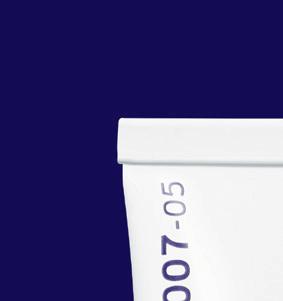




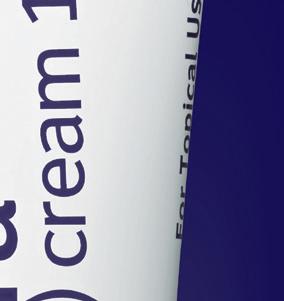
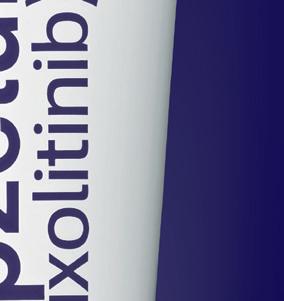





* For eligible patients. Enhanced Services Specialty Pharmacy Network Commercial Bridge Program* Prior Authorization Guidance Patient Support Resources DESTINATION: ACCESS Scan the QR code or visit opzeluraontrachcp.com. Please see Important Safety Information on the next page and Brief Summary of Full Prescribing Information, including Boxed Warning, on the following pages. A NEW PATIENT SUPPORT PROGRAM Opzelura On Trac™ provides you with resources to help patients get, start, and stay on track with treatment. Program Features:



INDICATIONS
OPZELURA is indicated for the topical short-term and non-continuous chronic treatment of mild to moderate atopic dermatitis in non-immunocompromised adult and pediatric patients 12 years of age and older whose disease is not adequately controlled with topical prescription therapies or when those therapies are not advisable.
OPZELURA is indicated for the topical treatment of nonsegmental vitiligo in adult and pediatric patients 12 years of age and older.
Limitations of Use: Use of OPZELURA in combination with therapeutic biologics, other JAK inhibitors, or potent immunosuppressants such as azathioprine or cyclosporine is not recommended.
IMPORTANT SAFETY INFORMATION
SERIOUS INFECTIONS
Patients treated with oral Janus kinase inhibitors for inflammatory conditions are at risk for developing serious infections that may lead to hospitalization or death. Reported infections include:
• Active tuberculosis, which may present with pulmonary or extrapulmonary disease.
• Invasive fungal infections, including cryptococcosis and pneumocystosis.
• Bacterial, viral, including herpes zoster, and other infections due to opportunistic pathogens.
Avoid use of OPZELURA in patients with an active, serious infection, including localized infections. If a serious infection develops, interrupt OPZELURA until the infection is controlled. Carefully consider the benefits and risks of treatment prior to initiating OPZELURA in patients with chronic or recurrent infection. Closely monitor patients for the development of signs and symptoms of infection during and after treatment with OPZELURA.
Serious lower respiratory tract infections were reported in the clinical development program with topical ruxolitinib.
No cases of active tuberculosis (TB) were reported in clinical trials with OPZELURA. Cases of active TB were reported in clinical trials of oral Janus kinase inhibitors used to treat inflammatory conditions. Consider evaluating patients for latent and active TB infection prior to administration of OPZELURA. During OPZELURA use, monitor patients for the development of signs and symptoms of TB.
Viral reactivation, including cases of herpes virus reactivation (e.g., herpes zoster), were reported in clinical trials with Janus kinase inhibitors used to treat inflammatory conditions including OPZELURA. If a patient develops herpes zoster, consider interrupting OPZELURA treatment until the episode resolves.
Hepatitis B viral load (HBV-DNA titer) increases, with or without associated elevations in alanine aminotransferase and aspartate aminotransferase, have been reported in patients with chronic HBV infections taking oral ruxolitinib. OPZELURA initiation is not recommended in patients with active hepatitis B or hepatitis C. MORTALITY
In a large, randomized, postmarketing safety study in rheumatoid arthritis (RA) patients 50 years of age and older with at least one cardiovascular risk factor comparing an oral JAK inhibitor to tumor necrosis factor (TNF) blocker treatment, a higher rate of all-cause mortality, including sudden cardiovascular death, was observed with the JAK inhibitor. Consider the benefits and risks for the individual patient prior to initiating or continuing therapy with OPZELURA.
MALIGNANCIES
Malignancies were reported in patients treated with OPZELURA. Lymphoma and other malignancies have been observed in patients receiving JAK inhibitors used to treat inflammatory conditions. In RA patients treated with an oral JAK inhibitor, a higher rate of malignancies (excluding non-melanoma skin cancer (NMSC)) was observed when compared with TNF blockers. Patients who are current or past smokers are at additional increased risk.
Consider the benefits and risks for the individual patient prior to initiating or continuing therapy with OPZELURA, particularly in patients with a known malignancy (other than successfully treated non-melanoma skin cancers), patients who develop a malignancy when on treatment, and patients who are current or past smokers. Non-melanoma skin cancers, including basal cell and squamous cell carcinoma, have occurred in patients treated with OPZELURA. Perform periodic skin examinations during OPZELURA treatment and following treatment as appropriate. Exposure to
sunlight and UV light should be limited by wearing protective clothing and using broad-spectrum sunscreen.
MAJOR ADVERSE CARDIOVASCULAR EVENTS (MACE)
In RA patients 50 years of age and older with at least one cardiovascular risk factor treated with an oral JAK inhibitor, a higher rate of major adverse cardiovascular events (MACE) (defined as cardiovascular death, myocardial infarction, and stroke), was observed when compared with TNF blockers. Patients who are current or past smokers are at additional increased risk. Discontinue OPZELURA in patients who have experienced a myocardial infarction or stroke.
Consider the benefits and risks for the individual patient prior to initiating or continuing therapy with OPZELURA, particularly in patients who are current or past smokers and patients with other cardiovascular risk factors. Patients should be informed about the symptoms of serious cardiovascular events and the steps to take if they occur. Discontinue OPZELURA in patients that have experienced a myocardial infarction or stroke.
THROMBOSIS
Thromboembolic events were observed in trials with OPZELURA. Thrombosis, including pulmonary embolism (PE), deep venous thrombosis (DVT), and arterial thrombosis have been reported in patients receiving JAK inhibitors used to treat inflammatory conditions. Many of these adverse reactions were serious and some resulted in death. In RA patients 50 years of age and older with at least one cardiovascular risk factor treated with an oral JAK inhibitor, a higher rate of thrombosis was observed when compared with TNF blockers. Avoid OPZELURA in patients at risk. If symptoms of thrombosis occur, discontinue OPZELURA and treat appropriately.
Thrombocytopenia, Anemia, and Neutropenia
Thrombocytopenia, anemia, and neutropenia were reported in the clinical trials with OPZELURA. Consider the benefits and risks for individual patients who have a known history of these events prior to initiating therapy with OPZELURA. Perform CBC monitoring as clinically indicated. If signs and/or symptoms of clinically significant thrombocytopenia, anemia, and neutropenia occur, patients should discontinue OPZELURA.
Lipid Elevations
Treatment with oral ruxolitinib has been associated with increases in lipid parameters including total cholesterol, low-density lipoprotein (LDL) cholesterol, and triglycerides.
Adverse Reactions
In atopic dermatitis, the most common adverse reactions (≥1%) are nasopharyngitis (3%), diarrhea (1%), bronchitis (1%), ear infection (1%), eosinophil count increased (1%), urticaria (1%), folliculitis (1%), tonsillitis (1%), and rhinorrhea (1%).
In nonsegmental vitiligo, the most common adverse reactions (incidence ≥1%) are application site acne (6%), application site pruritus (5%), nasopharyngitis (4%), headache (4%), urinary tract infection (2%), application site erythema (2%), and pyrexia (1%).
Pregnancy
There is a pregnancy registry that monitors pregnancy outcomes in pregnant persons exposed to OPZELURA during pregnancy. Pregnant persons exposed to OPZELURA and healthcare providers should report OPZELURA exposure by calling 1-855-4633463.
Lactation
Advise women not to breastfeed during treatment with OPZELURA and for approximately four weeks after the last dose (approximately 5-6 elimination halflives).
Please see Brief Summary of Full Prescribing Information, including Boxed Warning, on the following pages.
OPZELURA, the OPZELURA logo, Incyte, and the Incyte logo are registered trademarks of Incyte. © 2024, Incyte. 05/24 MAT-OPZ-02225
OPZELURA® (ruxolitinib) cream, for topical use
Brief Summary of FULL PRESCRIBING INFORMATION
INDICATIONS AND USAGE: OPZELURA is indicated for the topical short-term and non-continuous chronic treatment of mild to moderate atopic dermatitis in non-immunocompromised adult and pediatric patients 12 years of age and older whose disease is not adequately controlled with topical prescription therapies or when those therapies are not advisable and for the topical treatment of nonsegmental vitiligo in adult and pediatric patients 12 years of age and older.
Limitations of Use: Use of OPZELURA in combination with therapeutic biologics, other JAK inhibitors, or potent immunosuppressants such as azathioprine or cyclosporine is not recommended.
WARNING: SERIOUS INFECTIONS, MORTALITY, MALIGNANCY, MAJOR
ADVERSE CARDIOVASCULAR EVENTS, AND THROMBOSIS
SERIOUS INFECTIONS
Patients treated with oral Janus kinase inhibitors for inflammatory conditions are at risk for developing serious infections that may lead to hospitalization or death [see Warnings and Precautions and Adverse Reactions].
Reported infections include:
• Active tuberculosis, which may present with pulmonary or extrapulmonary disease.
• Invasive fungal infections, including cryptococcosis, and pneumocystosis.
• Bacterial, viral, including herpes zoster, and other infections due to opportunistic pathogens.
Avoid use of OPZELURA in patients with an active, serious infection, including localized infections. If a serious infection develops, interrupt OPZELURA until the infection is controlled.
The risks and benefits of treatment with OPZELURA should be carefully considered prior to initiating therapy in patients with chronic or recurrent infection.
Patients should be closely monitored for the development of signs and symptoms of infection during and after treatment with OPZELURA [see Warnings and Precautions]. MORTALITY
In a large, randomized, postmarketing safety study in rheumatoid arthritis (RA) patients 50 years of age and older with at least one cardiovascular risk factor comparing an oral JAK inhibitor to tumor necrosis factor (TNF) blocker treatment, a higher rate of all-cause mortality, including sudden cardiovascular death, was observed with the JAK inhibitor [see Warnings and Precautions]. MALIGNANCIES
Malignancies were reported in patients treated with OPZELURA. Lymphoma and other malignancies have been observed in patients receiving JAK inhibitors used to treat inflammatory conditions. In RA patients treated with an oral JAK inhibitor, a higher rate of malignancies (excluding non-melanoma skin cancer (NMSC)) was observed when compared with TNF blockers. Patients who are current or past smokers are at additional increased risk [see Warnings and Precautions].
MAJOR ADVERSE CARDIOVASCULAR EVENTS (MACE)
In RA patients 50 years of age and older with at least one cardiovascular risk factor treated with an oral JAK inhibitor, a higher rate of major adverse cardiovascular events (MACE) (defined as cardiovascular death, myocardial infarction, and stroke), was observed when compared with TNF blockers. Patients who are current or past smokers are at additional increased risk. Discontinue OPZELURA in patients who have experienced a myocardial infarction or stroke [see Warnings and Precautions].
THROMBOSIS
Thromboembolic events were observed in trials with OPZELURA. Thrombosis, including pulmonary embolism (PE), deep venous thrombosis (DVT), and arterial thrombosis have been reported in patients receiving JAK inhibitors used to treat inflammatory conditions. Many of these adverse reactions were serious and some resulted in death. In RA patients 50 years of age and older with at least one cardiovascular risk factor treated with an oral JAK inhibitor, a higher rate of thrombosis was observed when compared with TNF blockers. Avoid OPZELURA in patients at risk. If symptoms of thrombosis occur, discontinue OPZELURA and treat appropriately [see Warnings and Precautions]
have resided or traveled in areas of endemic tuberculosis or endemic mycoses; or with underlying conditions that may predispose them to infection. Closely monitor patients for the development of signs and symptoms of infection during and after treatment with OPZELURA. Interrupt OPZELURA if a patient develops a serious infection, an opportunistic infection, or sepsis. Do not resume OPZELURA until the infection is controlled.
Tuberculosis: No cases of active tuberculosis (TB) were reported in clinical trials with OPZELURA. Cases of active TB were reported in clinical trials of oral Janus kinase inhibitors used to treat inflammatory conditions. Consider evaluating patients for latent and active TB infection prior to administration of OPZELURA. During OPZELURA use, monitor patients for the development of signs and symptoms of TB.
WARNINGS AND PRECAUTIONS
Serious Infections: Serious and sometimes fatal infections due to bacterial, mycobacterial, invasive fungal, viral, or other opportunistic pathogens have been reported in patients receiving oral Janus kinase inhibitors. Serious lower respiratory tract infections were reported in the clinical development program with topical ruxolitinib. Avoid use of OPZELURA in patients with an active, serious infection, including localized infections. Consider the risks and benefits of treatment prior to initiating OPZELURA in patients: with chronic or recurrent infection; with a history of a serious or an opportunistic infection; who have been exposed to tuberculosis; who
of endemic tuberculosis or endemic mycoses; underlying conditions that may predispose them to infection. Closely monitor patients the development of signs and symptoms of infection during and after treatment OPZELURA. Interrupt OPZELURA if a patient develops a serious infection, an opportunistic infection, or sepsis. Do not resume OPZELURA until the infection is controlled. : No cases of active tuberculosis (TB) were reported in clinical trials C ases of active TB were reported in clinical trials of oral Janus inhibitors used to treat inflammatory conditions. Consider evaluating patients administration of OPZELURA. During OPZELURA
Viral Reactivation: Viral reactivation, including cases of herpes virus reactivation (e.g., herpes zoster), were reported in clinical trials with Janus kinase inhibitors used to treat inflammatory conditions including OPZELURA. If a patient develops herpes zoster, consider interrupting OPZELURA treatment until the episode resolves.
Hepatitis B and C: The impact of Janus kinase inhibitors used to treat inflammatory conditions including OPZELURA on chronic viral hepatitis reactivation is unknown. Patients with a history of hepatitis B or C infection were excluded from clinical trials. Hepatitis B viral load (HBV-DNA titer) increases, with or without associated elevations in alanine aminotransferase and aspartate aminotransferase, have been reported in patients with chronic HBV infections taking oral ruxolitinib. OPZELURA initiation is not recommended in patients with active hepatitis B or hepatitis C.
(TRuE-AD1 atopic group, and 4% and at OPZELURA adverse 4 (1%)
Urticaria 3 (1%)
: Viral reactivation, including cases of herpes virus reactivation herpes zoster), were reported in clinical trials with Janus kinase inhibitors used treat inflammatory conditions including OPZELURA. If a patient develops zoster, consider interrupting OPZELURA treatment until the episode resolves. Hepatitis B and C: The impact of Janus kinase inhibitors used to treat inflammatory conditions including OPZELURA on chronic viral hepatitis reactivation is unknown. Patients with a history of hepatitis B or C infection were excluded from clinical Hepatitis B viral load (HBV-DNA titer) increases, with or without associated elevations in alanine aminotransferase and aspartate aminotransferase, have been reported O PZELURA initiation
Mortality: In a large, randomized, postmarketing safety study of an oral JAK inhibitor in rheumatoid arthritis (RA) patients 50 years of age and older with at least one cardiovascular risk factor, a higher rate of all-cause mortality, including sudden cardiovascular death, was observed in patients treated with the JAK inhibitor compared with TNF blockers. Consider the benefits and risks for the individual patient prior to initiating or continuing therapy with OPZELURA.
Adverse OPZELURA pyrexia, acneiform
Nonsegmental TRuE-V2), vitiligo of subjects Asian. ≥ 1% and period any treatment 26 (6%) 5 (2%), site erythema
In a large, randomized, postmarketing safety study of an oral JAK inhibitor in rheumatoid arthritis (RA) patients 50 years of age and older with at least cardiovascular risk factor, a higher rate of all-cause mortality, including sudden cardiovascular death, was observed in patients treated with the JAK inhibitor
Consider the benefits and risks for the individual
Malignancy and Lymphoproliferative Disorders: Malignancies, including lymphomas, were observed in clinical trials of oral JAK inhibitors used to treat inflammatory conditions. Patients who are current or past smokers are at additional increased risk. Malignancies, including lymphomas, have occurred in patients receiving JAK inhibitors used to treat inflammatory conditions. In a large, randomized, postmarketing safety study of an oral JAK inhibitor in RA patients, a higher rate of malignancies (excluding non-melanoma skin cancer) was observed in patients treated with the JAK inhibitor compared to those treated with TNF blockers. A higher rate of lymphomas was observed in patients treated with the JAK inhibitor compared to those treated with TNF blockers. A higher rate of lung cancers was observed in current or past smokers treated with the JAK inhibitor compared to those treated with TNF blockers. In this study, current or past smokers had an additional increased risk of overall malignancies. Consider the benefits and risks for the individual patient prior to initiating or continuing therapy with OPZELURA, particularly in patients with a known malignancy (other than successfully treated non-melanoma skin cancers), patients who develop a malignancy when on treatment, and patients who are current or past smokers.
Adverse the OPZELURA hypertension, dermatitis influenza-like DRUG Drug known may increase decrease
Strong inhibitors ruxolitinib
USE IN Pregnancy
Malignancies, including lymphomas, inhibitors used to treat inflammatory conditions. Patients who current or past smokers are at additional increased risk. Malignancies, lymphomas, have occurred in patients receiving JAK inhibitors used to inflammatory conditions. In a large, randomized, postmarketing safety study of JAK inhibitor in RA patients, a higher rate of malignancies (excluding non-melanoma cancer) was observed in patients treated with the JAK inhibitor compared to those with TNF blockers. A higher rate of lymphomas was observed in patients treated with A higher rate of lung cancers JAK inhibitor compared to treated with TNF blockers. In this study, current or past smokers had an additional increased risk of overall malignancies. Consider the benefits and risks for the individual patient prior to initiating or continuing therapy with OPZELURA, particularly in patients with a known malignancy (other than successfully treated non-melanoma skin cancers), and patients who are current
Non-melanoma Skin Cancers: Non-melanoma skin cancers including basal cell and squamous cell carcinoma have occurred in patients treated with OPZELURA. Perform periodic skin examinations during OPZELURA treatment and following treatment as appropriate. Exposure to sunlight and UV light should be limited by wearing protective clothing and using broad-spectrum sunscreen.
Pregnancy outcomes persons exposure
Non-melanoma Skin Cancers: Non-melanoma skin cancers including basal cell squamous cell carcinoma have occurred in patients treated with OPZELURA. Perform periodic skin examinations during OPZELURA treatment and following treatment appropriate. Exposure to sunlight and UV light should be limited by wearing protective
Major Adverse Cardiovascular Events (MACE): In a large, randomized, postmarketing safety study of an oral JAK inhibitor in RA patients 50 years of age and older with at least one cardiovascular risk factor, a higher rate of major adverse cardiovascular events (MACE) defined as cardiovascular death, non-fatal myocardial infarction (MI), and non-fatal stroke was observed with the JAK inhibitor compared to those treated with TNF blockers. Patients who are current or past smokers are at additional increased risk. Consider the benefits and risks for the individual patient prior to initiating or continuing therapy with OPZELURA, particularly in patients who are current or past smokers and patients with other cardiovascular risk factors. Patients should be informed about the symptoms of serious cardiovascular events and the steps to take if they occur. Discontinue OPZELURA in patients that have experienced a myocardial infarction or stroke.
Risk Summary are not other adverse of ruxolitinib adverse
The background populations other birth defects Data
In a large, randomized, postmarketing safety study of an oral JAK inhibitor in RA patients 50 years of age and older with at least cardiovascular risk factor, a higher rate of major adverse cardiovascular events (MACE) defined as cardiovascular death, non-fatal myocardial infarction (MI), and non-fatal was observed with the JAK inhibitor compared to those treated with TNF blockers. Patients Consider the benefits risks for the individual patient prior to initiating or continuing therapy with OPZELURA particularly in patients who are current or past smokers and patients with cardiovascular risk factors. Patients should be informed about the symptoms of cardiovascular events and the steps to take if they occur. Discontinue OPZELURA in patients
Thrombosis: Thromboembolic events were observed in clinical trials with OPZELURA. Thrombosis, including deep vein thrombosis (DVT), pulmonary embolism (PE), and arterial thrombosis have been reported in patients receiving JAK inhibitors used to treat inflammatory conditions. Many of these adverse reactions were serious and some resulted in death. In a large, randomized, postmarketing safety study of an oral JAK inhibitor in RA patients 50 years of age and older with at least one cardiovascular risk factor, higher rates of overall thrombosis, DVT, and PE were observed compared to those treated with TNF blockers. Avoid OPZELURA in patients who may be at increased risk of thrombosis. If symptoms of thrombosis occur, discontinue OPZELURA and evaluate and treat patients appropriately.
Thrombocytopenia, Anemia, and Neutropenia: Thrombocytopenia, anemia , and neutropenia were reported in the clinical trials with OPZELURA. Consider the benefits and risks for individual patients who have a known history of these events prior to initiating therapy with OPZELURA. Perform CBC monitoring as clinically indicated. If signs and/or symptoms of clinically significant thrombocytopenia, anemia, and neutropenia occur, patients should discontinue OPZELURA.
ADVERSE REACTIONS
Thromboembolic events were observed in clinical trials with OPZELURA. Thrombosis, including deep vein thrombosis (DVT), pulmonary embolism (PE), arterial thrombosis have been reported in patients receiving JAK inhibitors used treat inflammatory conditions. Many of these adverse reactions were serious some resulted in death. In a large, randomized, postmarketing safety study of JAK inhibitor in RA patients 50 years of age and older with at least one cardiovascular risk factor, higher rates of overall thrombosis, DVT, and PE were observed compared those treated with TNF blockers. Avoid OPZELURA in patients who may be at increased risk of thrombosis. If symptoms of thrombosis occur, discontinue OPZELURA
Animal of organogenesis, rabbits. weight 60 mg/kg/day. systemic exposure affected lower highest approximately study lactation embryofetal function
Lactation
T hrombocytopenia, anemia neutropenia were reported in the clinical trials with OPZELURA. Consider the benefits and risks for individual patients who have a known history of these events prior initiating therapy with OPZELURA. Perform CBC monitoring as clinically indicated. signs and/or symptoms of clinically significant thrombocytopenia, anemia,
Lipid Elevations: Treatment with oral ruxolitinib has been associated with increases in lipid parameters including total cholesterol, low-density lipoprotein (LDL) cholesterol, and triglycerides.
Treatment with oral ruxolitinib has been associated with increases in lipid parameters including total cholesterol, low-density lipoprotein
Clinical Trials Experience: Because clinical trials are conducted under widely varying conditions, adverse reaction rates observed in the clinical trials of a drug cannot be directly compared to rates in the clinical trials of another drug and may not reflect the rates observed in practice. Atopic Dermatitis: In two double-blind, vehicle-controlled clinical trials
Risk Summary on the of lactating present serious breastfeed last dose
Data: (30 mg/kg) for up the maternal several
Because clinical trials are conducted under widely varying conditions, adverse reaction rates observed in the clinical trials of a drug cannot be directly compared to rates in the clinical trials of another drug and may not reflect the Atopic Dermatitis: In two double-blind, vehicle-controlled clinical
(TRuE-AD1 and TRuE-AD2), 499 adult and pediatric subjects 12 years of age and older with dermatitis were treated with OPZELURA twice daily for 8 weeks. In the OPZELURA 62% of subjects were females, and 71% of subjects were White, 23% were Black, 4% were Asian. The adverse reactions reported by ≥ 1% of OPZELURA treated subjects a greater incidence than in the vehicle arm through week 8 are as follows for OPZELURA (N=499) vs Vehicle (N=250), respectively: Subjects with any treatment emergent adverse event (TEAE) 132 (27%) vs 83 (33%), Nasopharyngitis 13 (3%) vs 2 (1%), Bronchitis vs 0 (0%), Ear infection 4 (1%) vs 0 (0%), Eosinophil count increased 4 (1%) vs 0 (0%), Urticaria 4 (1%) vs 0 (0%), Diarrhea 3 (1%) vs 1 (<1%), Folliculitis 3 (1%) vs 0 (0%), Tonsillitis vs 0 (0%), and Rhinorrhea 3 (1%) vs 1 (<1%).
(TRuE-AD1 and TRuE-AD2), 499 adult and pediatric subjects 12 years of age and older with atopic dermatitis were treated with OPZELURA twice daily for 8 weeks. In the OPZELURA group, 62% of subjects were females, and 71% of subjects were White, 23% were Black, and 4% were Asian. The adverse reactions reported by ≥ 1% of OPZELURA treated subjects and at a greater incidence than in the vehicle arm through week 8 are as follows for OPZELURA (N=499) vs Vehicle (N=250), respectively: Subjects with any treatment emergent adverse event (TEAE) 132 (27%) vs 83 (33%), Nasopharyngitis 13 (3%) vs 2 (1%), Bronchitis 4 (1%) vs 0 (0%), Ear infection 4 (1%) vs 0 (0%), Eosinophil count increased 4 (1%) vs 0 (0%), Urticaria 4 (1%) vs 0 (0%), Diarrhea 3 (1%) vs 1 (<1%), Folliculitis 3 (1%) vs 0 (0%), Tonsillitis 3 (1%) vs 0 (0%), and Rhinorrhea 3 (1%) vs 1 (<1%).
Adverse reactions that occurred in TRuE-AD1 and TRuE-AD2 in < 1% of subjects in the OPZELURA group and none in the vehicle group were: neutropenia, allergic conjunctivitis, pyrexia, seasonal allergy, herpes zoster, otitis externa, Staphylococcal infection, and acneiform dermatitis.
Adverse reactions that occurred in TRuE-AD1 and TRuE-AD2 in < 1% of subjects in the OPZELURA group and none in the vehicle group were: neutropenia, allergic conjunctivitis, pyrexia, seasonal allergy, herpes zoster, otitis externa, Staphylococcal infection, and acneiform dermatitis.
Nonsegmental Vitiligo TRuE-V2), 449 adult and pediatric subjects 12 years of age and older with nonsegmental were treated with OPZELURA twice daily for 24 weeks. In the OPZELURA group, 55% subjects were females, and 81% of subjects were White, 5% were Black, and 4% were The adverse reactions reported by OPZELURA and at least 1% greater incidence than in the vehicle arm in the 24-week double-blind are as follows for OPZELURA (N=449) vs Vehicle (N=224), respectively: Subjects with treatment emergent adverse event (TEAE) 214 (48%) vs 79 (35%), Application site acne (6%) vs 2 (1%), Application site pruritus 23 (5%) vs 6 (3%), Nasopharyngitis 19 (4%) vs (2%), Headache 17 (4%) vs 6 (3%), Urinary tract infection 7 (2%) vs 1 (<1%), Application erythema 7 (2%) vs 1 (<1%), and Pyrexia 6 (1%) vs 0 (0%)
Nonsegmental Vitiligo: In two double-blind, vehicle-controlled clinical trials (TRuE-V1 and TRuE-V2), 449 adult and pediatric subjects 12 years of age and older with nonsegmental vitiligo were treated with OPZELURA twice daily for 24 weeks. In the OPZELURA group, 55% of subjects were females, and 81% of subjects were White, 5% were Black, and 4% were Asian. The adverse reactions reported by OPZELURA treated subjects with an incidence of ≥ 1% and at least 1% greater incidence than in the vehicle arm in the 24-week double-blind period are as follows for OPZELURA (N=449) vs Vehicle (N=224), respectively: Subjects with any treatment emergent adverse event (TEAE) 214 (48%) vs 79 (35%), Application site acne 26 (6%) vs 2 (1%), Application site pruritus 23 (5%) vs 6 (3%), Nasopharyngitis 19 (4%) vs 5 (2%), Headache 17 (4%) vs 6 (3%), Urinary tract infection 7 (2%) vs 1 (<1%), Application site erythema 7 (2%) vs 1 (<1%), and Pyrexia 6 (1%) vs 0 (0%)
Adverse reactions that occurred in TRuE-V1 and TRuE-V2 in ≥ 0.5% to < 1% of subjects in OPZELURA group and none in the vehicle group were: application site dermatitis, hypertension, anxiety, application site discoloration, application site folliculitis, contusion, dermatitis contact, diarrhea, ear infection, gastritis, gastroenteritis, hordeolum, influenza-like illness, insomnia, nasal congestion, and vomiting.
INTERACTIONS
DRUG INTERACTIONS
interaction studies with known to be a substrate for cytochrome P450 3A4 increase ruxolitinib systemic concentrations whereas inducers of decrease ruxolitinib systemic concentrations.
Adverse reactions that occurred in TRuE-V1 and TRuE-V2 in ≥ 0.5% to < 1% of subjects in the OPZELURA group and none in the vehicle group were: application site dermatitis, hypertension, anxiety, application site discoloration, application site folliculitis, contusion, dermatitis contact, diarrhea, ear infection, gastritis, gastroenteritis, hordeolum, influenza-like illness, insomnia, nasal congestion, and vomiting.
Drug interaction studies with OPZELURA have not been conducted. Ruxolitinib is known to be a substrate for cytochrome P450 3A4 (CYP3A4). Inhibitors of CYP3A4 may increase ruxolitinib systemic concentrations whereas inducers of CYP3A4 may decrease ruxolitinib systemic concentrations.
Strong Inhibitors of CYP3A4: Avoid concomitant use of OPZELURA with strong inhibitors of CYP3A4 as there is a potential to increase the systemic exposure of ruxolitinib and could increase the risk of OPZELURA adverse reactions.
Strong Inhibitors of CYP3A4: Avoid concomitant use of OPZELURA with strong inhibitors of CYP3A4 as there is a potential to increase the systemic exposure of ruxolitinib and could increase the risk of OPZELURA adverse reactions.
IN SPECIFIC POPULATIONS
USE IN SPECIFIC POPULATIONS
Pregnancy Pregnancy Exposure Registry
Pregnancy
utcomes in pregnant persons exposed to OPZELURA during pregnancy. Pregnant persons exposed to OPZELURA and healthcare providers should report OPZELURA exposure by calling 1-855-463-3463.
Pregnancy Exposure Registry: There is a pregnancy registry that monitors pregnancy outcomes in pregnant persons exposed to OPZELURA during pregnancy. Pregnant persons exposed to OPZELURA and healthcare providers should report OPZELURA exposure by calling 1-855-463-3463.
Summary not sufficient to evaluate a drug-associated risk for major birth defects, miscarriage, or adverse maternal or fetal outcomes. In animal reproduction studies, oral administration ruxolitinib to pregnant rats and rabbits during the period of organogenesis resulted in adverse developmental outcomes at doses associated with maternal toxicity. background risks of major birth defects and miscarriage for the indicated populations are unknown. All pregnancies carry some risk of birth defects, loss, or adverse outcomes. The background risk in the U.S. general population of major defects and miscarriage is 2-4% and 15-20%, respectively.
Patients benefits and OPZELURA, other serious patients
Risk Summary: Available data from pregnancies reported in clinical trials with OPZELURA are not sufficient to evaluate a drug-associated risk for major birth defects, miscarriage, or other adverse maternal or fetal outcomes. In animal reproduction studies, oral administration of ruxolitinib to pregnant rats and rabbits during the period of organogenesis resulted in adverse developmental outcomes at doses associated with maternal toxicity. The background risks of major birth defects and miscarriage for the indicated populations are unknown. All pregnancies carry some risk of birth defects, loss, or other adverse outcomes. The background risk in the U.S. general population of major birth defects and miscarriage is 2-4% and 15-20%, respectively.
Data
Data: Ruxolitinib was administered orally to pregnant rats or rabbits during the period organogenesis, at doses of 15, 30 rabbits. There were no treatment-related malformations at any dose. A decrease in fetal of approximately 9% was noted in rats at the highest and maternally toxic dose of mg/kg/day. This dose resulted in systemic exposure approximately 22 times the clinical systemic exposure at the maximum recommended human dose (MRHD; the clinical systemic exposure from ruxolitinib cream, 1.5% applied twice daily to 25-40% atopic dermatitisaffected body surface area is used fetal weights of approximately 8% and increased late resorptions were noted at the highest and maternally toxic dose of approximately 70% the MRHD clinical systemic exposure. In a pre-and post-natal development in rats, pregnant animals were dosed with ruxolitinib from implantation through lactation at doses up to 30 mg/kg/day. There were no drug-related adverse effects on embryofetal survival, postnatal growth, development parameters or offspring reproductive function at the highest dose evaluated (3.1 times the MRHD clinical systemic exposure). Lactation
Pediatric Use: Atopic Dermatitis: The safety and effectiveness of OPZELURA for the topical treatment of mild-to-moderate atopic dermatitis have been established in pediatric patients aged 12 to 17 years of age. Use of OPZELURA in this age group is supported by evidence from TRuE-AD1 and TRuE-AD2, which included 92 pediatric subjects aged 12 to 17 years with mild-to-moderate atopic dermatitis. No clinically meaningful differences in safety or effectiveness were observed between adult and pediatric subjects. The safety and effectiveness of OPZELURA in pediatric patients younger than 12 years of age with atopic dermatitis have not been established. Nonsegmental Vitiligo: The safety and effectiveness of OPZELURA for the topical treatment of nonsegmental vitiligo have been established in pediatric patients aged 12 to 17 years of age. Use of OPZELURA in this age group is supported by evidence from TRuE-V1 and TRuE-V2, which included 55 pediatric subjects aged 12 to 17 years with nonsegmental vitiligo. No clinically meaningful differences in safety or effectiveness were observed between adult and pediatric subjects. The safety and effectiveness of OPZELURA in pediatric patients younger than 12 years of age with nonsegmental vitiligo have not been established. Juvenile Animal Toxicity Data: Oral administration of ruxolitinib to juvenile rats resulted in effects on growth and bone measures. When administered starting at postnatal day 7 (the equivalent of a human newborn) at doses of 1.5 to 75 mg/kg/day, evidence of fractures occurred at doses ≥ 30 mg/kg/day, and effects on body weight and other bone measures [e.g., bone mineral content, peripheral quantitative computed tomography, and x-ray analysis] occurred at doses ≥ 5 mg/kg/day. When administered starting at postnatal day 21 (the equivalent of a human 2-3 years of age) at doses of 5 to 60 mg/kg/day, effects on body weight and bone occurred at doses ≥ 15 mg/kg/day, which were considered adverse at 60 mg/kg/day. Males were more severely affected than females in all age groups, and effects were generally more severe when administration was initiated earlier in the postnatal period. These findings were observed at systemic exposures that are at least 40% the MRHD clinical systemic exposure.
Geriatric Use: Of the 1249 total subjects with atopic dermatitis in clinical trials with OPZELURA, 115 (9%) were 65 years of age and older. No clinically meaningful differences in safety or effectiveness were observed between subjects less than 65 years and subjects 65 years and older.
Of the 831 total subjects enrolled with nonsegmental vitiligo in clinical trials with OPZELURA, 65 (8%) were 65 years of age and older. Clinical trials of OPZELURA in subjects with nonsegmental vitiligo did not include sufficient numbers of subjects 65 years of age and older to determine whether they respond differently from younger adult subjects.
PATIENT COUNSELING INFORMATION
Advise the patient or caregivers to read the FDA-approved patient labeling (Medication Guide). Infections: Inform patients that they may be at increased risk for developing infections, including serious infections, when taking Janus kinase inhibitors. Instruct patients to tell their healthcare provider if they develop any signs or symptoms of an infection. Advise patients that Janus kinase inhibitors increase the risk of herpes zoster, and some cases can be serious [see Warnings and Precautions]
Malignancies and Lymphoproliferative Disorders: Inform patients that Janus kinase inhibitors may increase the risk for developing lymphomas and other malignancies including skin cancer. Instruct patients to inform their health care provider if they have ever had any type of cancer. Inform patients that periodic skin examinations should be performed while using OPZELURA. Advise patients that exposure to sunlight, and UV light should be limited by wearing protective clothing and using a broad-spectrum sunscreen [see Warnings and Precautions]
Lactating rats were administered a single dose of [14C]-labeled ruxolitinib mg/kg) on postnatal Day 10, after which plasma and milk samples were collected to 24 hours. The AUC for total radioactivity in milk was approximately 13 times maternal plasma AUC. Additional analysis showed the presence of ruxolitinib and several of its metabolites in milk, all at levels higher than those in maternal plasma. or with patients for treatment with opportunistic trials with kinase patients for OPZELURA reactivation (e.g., used to herpes inflammatory unknown. trials. elevations reported in initiation is not inhibitor least one sudden inhibitor patient lymphomas, conditions. Malignancies, to treat an oral non-melanoma skin treated with the cancers to those additional individual patients cancers), current or cell and Perform treatment as protective postmarketing least one (MACE) stroke
OPZELURA. (PE), and used to serious and an oral cardiovascular compared to increased OPZELURA and anemia, and benefits prior to indicated. If anemia, and increases (LDL) varying directly the rates clinical trials
Animal Data: Ruxolitinib was administered orally to pregnant rats or rabbits during the period of organogenesis, at doses of 15, 30, or 60 mg/kg/day in rats and 10, 30, or 60 mg/kg/day in rabbits. There were no treatment-related malformations at any dose. A decrease in fetal weight of approximately 9% was noted in rats at the highest and maternally toxic dose of 60 mg/kg/day. This dose resulted in systemic exposure approximately 22 times the clinical systemic exposure at the maximum recommended human dose (MRHD; the clinical systemic exposure from ruxolitinib cream, 1.5% applied twice daily to 25-40% atopic dermatitisaffected body surface area is used for calculation of multiples of human exposure). In rabbits, lower fetal weights of approximately 8% and increased late resorptions were noted at the highest and maternally toxic dose of 60 mg/kg/day. This dose resulted in systemic exposure approximately 70% the MRHD clinical systemic exposure. In a pre-and post-natal development study in rats, pregnant animals were dosed with ruxolitinib from implantation through lactation at doses up to 30 mg/kg/day. There were no drug-related adverse effects on embryofetal survival, postnatal growth, development parameters or offspring reproductive function at the highest dose evaluated (3.1 times the MRHD clinical systemic exposure).
Lactation
Summary breastfed child, or the effects on milk production. Ruxolitinib was present in the milk lactating rats. When a drug is present in animal milk, it is likely that the drug will be present in human milk. Because of the serious adverse findings in adults, including risks of serious infections, thrombocytopenia, anemia, and neutropenia, advise women not to breastfeed during treatment with OPZELURA dose (approximately
Risk Summary: There are no data on the presence of ruxolitinib in human milk, the effects on the breastfed child, or the effects on milk production. Ruxolitinib was present in the milk of lactating rats. When a drug is present in animal milk, it is likely that the drug will be present in human milk. Because of the serious adverse findings in adults, including risks of serious infections, thrombocytopenia, anemia, and neutropenia, advise women not to breastfeed during treatment with OPZELURA and for approximately four weeks after the last dose (approximately 5-6 elimination half-lives).
Data: Lactating rats were administered a single dose of [14C]-labeled ruxolitinib (30 mg/kg) on postnatal Day 10, after which plasma and milk samples were collected for up to 24 hours. The AUC for total radioactivity in milk was approximately 13 times the maternal plasma AUC. Additional analysis showed the presence of ruxolitinib and several of its metabolites in milk, all at levels higher than those in maternal plasma.
Major Adverse Cardiovascular Events: Advise patients that events of major adverse cardiovascular events (MACE) including non-fatal myocardial infarction, non-fatal stroke, and cardiovascular death, have been reported in clinical studies with Janus kinase inhibitors used to treat inflammatory conditions. Instruct all patients, especially current or past smokers or patients with other cardiovascular risk factors, to be alert for the development of signs and symptoms of cardiovascular events [see Warnings and Precautions].
Thrombosis: Advise patients that events of DVT and PE have been reported in clinical studies with Janus kinase inhibitors used to treat inflammatory conditions. Instruct patients to tell their healthcare provider if they develop any signs or symptoms of a DVT or PE [see Warnings and Precautions]
Thrombocytopenia, Anemia , and Neutropenia: Advise patients of the risk of thrombocytopenia, anemia, and neutropenia with OPZELURA. Instruct patients to tell their healthcare provider if they develop any signs or symptoms of thrombocytopenia, anemia , or neutropenia [see Warnings and Precautions]
Administration Instructions: Advise patients or caregivers that OPZELURA is for topical use only [see Dosage and Administration]
Advise patients to limit treatment to one 60 gram tube per week or one 100 gram tube per 2 weeks [see Dosage and Administration]
Pregnancy: Inform patients to report their pregnancy to Incyte Corporation at 1-855-463-3463 [see Use in Specific Populations]
Lactation: Advise a patient not to breastfeed during treatment with OPZELURA and for about four weeks after the last dose [see Use in Specific Populations]
Manufactured for: Incyte Corporation 1801 Augustine Cut-off Wilmington, DE 19803
OPZELURA is a registered trademark of Incyte. All rights reserved. U.S. Patent Nos. 7598257; 8415362; 8722693; 8822481; 9079912; 9974790; 10639310; 10610530; 10758543; 10869870; 11219624 © 2022-2023 Incyte Corporation. All rights reserved. Issued: July 2022 PLR-OPZ-00022-JUN23
Skin Smarts
EXPERT ADVICE ON THE DO'S AND DON'TS OF SOCIAL MEDIA SKINCARE TRENDS FOR TEENS










ACCESS DERMATOLOGY / ISSUE 9 / 2024 30 KHORZHEVSKASTOCK.ADOBE.COM




Skincare trends on social media have seemingly taken over the internet and it’s become virtually impossible to scroll through TikTok, YouTube or Instagram without being bombarded with tutorials about elaborate routines promising to make your face glow and radiate youth. And, while wanting to be in the know about the latest and greatest in cosmetics is nothing new, there has been a huge shift in the audience purchasing these products. Stores like Sephora and Ulta Beauty, who once saw middle-aged women as their biggest buyers, now have aisles filled with teens and tweens in search of high-end skincare products. The influence from these social media platforms is very real and children as young as nine or ten are putting things like $60 eye creams and skincare refrigerators on their wish lists.


Aside from the exorbitant cost, product safety is another major factor for parents to consider when deciding whether or not to allow their teens to indulge in this fad.
With a lot of misinformation floating around out there, it can be difficult for even the most discerning of us to understand every ingredient and ensure that buying these products isn’t coming at a cost higher than just our pockets. We sat down with Erin Myers-Albaridi, clinical director, PA-C at New Beauty Wellness (NBW) in New Canaan, CT. Myers-Albaridi helped give us a better understanding of what we should be focused on for optimal skin health by age.
bcofdermatology.com 31
Liz
By
Barron
MELECISSTOCK.ADOBE.COM
WHAT ARE YOUR THOUGHTS ABOUT THIS SKINCARE CRAZE THAT SO MANY TEENAGERS ARE ATTRACTED TO?
I am seeing more and more children (and adults for that matter) come into the office with skin conditions, rashes and acne outbreaks made worse by over-the-counter products and cosmeceutical lines. Marketing is very powerful, and the consumer gets sucked into the trends without really understanding what they are using.
It’s important to stress, though, that it's an overall positive that children have a desire to take care of their skin. Skin cancer is the most common cancer in the U.S. Presently about one in five Americans will develop skin cancer in their lifetime and, although skin cancers form later in life, dermatologists know that most of these are caused from excessive sun exposure between the ages of three to 20 years of age.
WHAT PRODUCTS ARE THE MOST CONCERNING TO YOU THAT ARE BEING MISUSED? WHAT NEGATIVE IMPACTS COULD THEY HAVE ON THESE YOUNG TEENS?
I would have parents look for and avoid ingredients like vitamin E (tocopherol) as they frequently stimulate acne and can make existing acne worse.
WHAT PRODUCTS, IF ANY, ARE TRULY APPROPRIATE FOR THOSE UNDER 15?
Cleanser, sunscreen and moisturizer. For oily skin, I like Neutrogena Hydro Boost Gel Cleanser. For dry skin, cream- or lotionbased products like CeraVe Hydrating Facial Cleanser work well. And for sensitive skin, Cetaphil Gentle Skin Cleanser is soap free and works well. For acne-prone skin,
I’d recommend trying a cleanser with an ingredient like salicylic acid, glycolic acid or benzoyl peroxide. If your tween has sensitive skin and is acne-prone, avoid these until consulting a dermatologist or dermatological PA/NP as they may be too harsh. Our tweens are listening to the importance of sun protection and many are using it regularly and far earlier than previous generations. Look for ingredients like titanium and zinc in SPF lotion; these completely block the UV rays. Increase the percentage to a 50 if outside and reapply every three hours if in the sun directly.
WHAT HAPPENS WHEN TOO MANY PRODUCTS ARE BEING USED AT ONCE OR OVERUSED?

Outbreaks of acne, rosacea, contact dermatitis, retinoid dermatitis (retinol overuse) and overly dehydrated sensitive skin are just a few of the conditions I see when products are used incorrectly.
Are there any brands that are just not designed for teens? Any product recommended for mature skin should be avoided by teens. Many AHA/BHA products (glycolic acid, salicylic acid) and retinols will increase the risk of sunburn and irritation. Make sure your teens are using a moisturizer and a sunscreen daily if using these products.
ARE THERE ANY BRANDS THAT HAVE PRODUCT LINES THAT TEND TO BE CLEANER/LIGHTER/ MORE APPROPRIATE?
Cetaphil, Neutrogena and Avène all have gentle products. For acne-prone skin, Differin (adapalene) makes a good overthe-counter product and you only need to use a pea-sized amount for the entire face. It can be drying and irritating, so start three times a week and use a moisturizer either before or after application if your teen is sensitive.

LASER ADVICE
“Recent research and development in regenerative skincare has been advancing by the year. Please make sure you go to someone who understands laser technology indepth. It is a mistake to follow TikTok trends, as many companies are paying consumers and offices to market their machines. It doesn’t mean their device is superior to the competition. Some of the best lasers on the market are those that came out decades ago. Understanding the science is most important and, unfortunately, we are seeing more and more medical spas push devices when they don’t even understand the physics behind the lasers they run. It’s the musician, not the instrument, that creates results. We have to keep skin type in mind as we run these powerful machines.”
—MYERS-ALBARIDI
ACCESS DERMATOLOGY / ISSUE 9 / 2024 32
TATYANAROWSTOCK.ADOBE.COM; WANGMANDOSTOCK.ADOBE.COM
ALPHARET EXFOLIATING PEEL PADS
Triple-acid formula with retinoid exfoliates skin, leaving it smooth and bright.
ISDIN
Repair cream for the eye area that helps target fine lines and wrinkles; stimulates the skin’s antioxidant defenses and provides a detox action for a revitalized look.
ALASTIN
Helps combat signs of aging, brightening the complexion and lifting the skin for a more youthful glow.
ENVIRON FOCUS CARE YOUTH+
Toner with a high concentration of glycolic acid; promotes the natural acid mantle of the skin and encourages exfoliation.
NBW SKINCARE PRODUCT PICKS BY AGE:
Critical thinking when deciding how to spend money is important when it comes to all things.
TWEEN/ TEEN
Recommended cleanser, moisturizer and SPF
ISDIN PHOTO
Ultralight tinted, fastabsorbing emulsion that helps fight signs of photoaging.
Also consider glycolic acid, salicylic acid, benzoyl peroxide wash or retinol for acne-prone skin (make sure to consult a dermatologic provider if the teen’s skin is sensitive or resistant to over-the-counter products).
20-30s
Recommended: cleanser, moisturizer, SPF, retinol and products that help reduce free radical damage to the skin (vitamin C, peptides, alastin, exosomes)
Also consider microneedling (with or without radiofrequency) to help with pore size and light resurfacing lasers such as Clear + Brilliant.
40-60s
Recommended cleanser, moisturizer, SPF, retinol, antioxidants, peptides
ALPHARET ($000) XXXXXXX
Cit adigendanti iur? Experistia cuptam et omnis dolupta doloria velitatio. Ga. Et moluptur aspicim quat quate doluptatis eos ullis ipiet iuntemp oreped milit, non reic tem et magnatur? Archili gnimillautem

Also consider Alastin’s Restorative Skin Complex (promotes collagen and elastin to thicken the skin and helps with elasticity), Skin Better’s AlphaRet Pads with a blend of patented retinol, lactic acid, glycolic acid and salicyclic acid. Consider adding deeper resurfacing lasers, deeper RF microneedling treatments, as well as ultrasound technology for tightening and resurfacing deeper wrinkles.
VENERA ALEXANDROVA
40-60S 40-60S 40-60S TEENS 20-30S
NEED ANOTHER REASON TO ATTEND THE BCOD NATIONAL CONFERENCE THIS YEAR?
Does your Dermatologist want greater office efficiency, drug approval percentages, and increased patient adherence?

BCoD is offering an immersive workshop designed to set up office s for maximum workflow efficiency.
BCOD MASTERY WORKSHOP: OPTIMIZING OFFICE WORKFLOW FOR BIOLOGIC
Participants are provided a BCoD Biologic Binder with the information and resources to guide you for optimal therapy approval and office efficiency.
• Contents include brand-specific approval documents
• Best practices for prior-approval by brand

• EMR setup instructions. We work closely with EMA and Epic and will demonstrate how to set up your office using these technologies.
Our resources are designed with years of experience and trial and error to minimize approval hurdles.
A 3-month study on implementing these BCoD practices and resources has demonstrated:
• a shortened window to drug vs. a control of offices not using them
• increased patient satisfaction
• increased office productivity

This program is commonly offered to Dermatology offices at a premium price. This workshop, its training, and its materials will be provided to you in this conference workshop at NO COST, and conference registration is free.
Join BCoD and attend our national conference for this workshop and many additional empowering workshops and presentations.































Join the Biologic Coordinators of Dermatology (BCoD) and discover a world of member benefits designed to elevate your professional journey and enhance patient care.
MEMBER BENEFITS

EDUCATIONAL TRAINING
Exclusive invites to educational trainings, webcasts, and meetings. RESOURCES
Office and patient resources for easier approvals and workflow management.


PROFESSIONAL DEVELOPMENT
Content designed for personal and professional growth. IMPROVE PATIENT OUTCOMES
Tools and insights that enhance patient outcomes.
COMMUNITY
A platform that connects you with peers nationwide.


UNLOCK YOUR POTENTIAL WITH BCOD
PATIENT ACCESS
TOGETHER WE ADVANCE
Learn more at BCOFDERMATOLOGY.COM
the vibrant community of BCoD, where each member plays a crucial role in advancing patient access.
Embrace
BC SPOTLIGHT

ARECOGNIZING OUTSTANDING PATIENT SERVICE
t BCoD, we celebrate our members and access managers across the country who ensure a positive patient experience. We applaud these professionals for their commitment to patients and their efforts to secure the types of therapy needed. This month, we spotlight an outstanding biologic coordinator for her remarkable efforts in advancing patient access.













LETTER of R ECOGNITION







































Katelyn Crane
BIOLOGIC COORDINATOR DERMATOLOGY ASSOCIATES, PSC
Louisville, KY
“I am writing to nominate Katelyn Crane for special recognition as a biologic coordinator at Dermatology Associates, PSC, in Louisville, KY. Katelyn's exceptional dedication, initiative, and expertise have greatly contributed to the efficiency of our practice and overall care of our patients.
Since joining our team, Katelyn has demonstrated an unparalleled commitment to mastering all aspects of biologics coordination. She swiftly familiarized herself with biologics, prior authorizations, pharmacy logistics, and insurance intricacies, showcasing a remarkable level of diligence and adaptability. One of her initial endeavors was the creation of a comprehensive 'Biologics 101' reference brochure for our clinical staff and physicians, which has proven invaluable in facilitating understanding and efficiency.
Katelyn's initiative shines through her creation of meticulously detailed step-by-step guides for submitting prior authorizations for each biologic medication we utilize. Notably, she crafted 14 distinct guides—each color-coded for clarity and ease of reference, showcasing her dedication to thoroughness and accessibility.
Additionally, Katelyn has developed user guides tailored to our clinical staff, providing crucial information on complex biologics and dosing protocols. Her proactive approach to knowledge dissemination ensures that our office remains wellinformed and capable of delivering optimal patient care.
Katelyn consistently seeks out ways she can help make positive changes, whether that be here in our office or in our government. She goes above and beyond her role, making phone calls or writing letters to hospitals, insurance companies, or lobbying to change laws that negatively impact patients from receiving the medication they need and deserve.
Her commitment to advocating for patients and improving healthcare accessibility sets her apart. She not only excels in her day-to-day responsibilities, but also actively seeks opportunities to make a meaningful difference in the lives of others. Katelyn's proactive approach and tireless dedication make her an invaluable asset to our team and the community we serve.
Katelyn's dedication to excellence serves as an inspiration to us all, and I am confident that she will continue to excel in anything she puts her mind to.”
— HANNAH GERBER, ASSISTANT PRACTICE MANAGER
bcofdermatology.com 39
BC OD
By Georgette Yacoub

































plunge take the



















MCOLD THERAPY: THE HOT HEALTHCARE TREND
aybe you know what it feels like to submerge your body into ice-cold water. The involuntary gasp. The initial shock. Your breath becomes labored and short, in sync with your now-racing heart. Your adrenaline pumps into overdrive as if you were at the first drop of a roller coaster you didn’t really want to ride, when you’re just in a barrel of water in your backyard on a regular Tuesday morning—all in the name of wellness.









ACCESS DERMATOLOGY / ISSUE 9 / 2024 40


If you aren’t familiar with the feeling, you’ve likely seen others doing it on your social media feeds or heard Joe Rogan talk about it. The question, though, is cold therapy just hot right now or is it worth the hype?
At a high level, scientific studies have shown cold therapy to increase energy, decrease chronic inflammation, reduce muscle soreness, improve sleep quality and strengthen immune function. When you first submerge yourself into cold water, your body goes into fight or flight mode.
Adrenaline jumps by 530% and dopamine (a “feel good” chemical) surges by 250%. Your veins constrict, pumping blood away from your extremities and to your organs. Then the magic happens.
Through the process of slowing and regulating your breath, you calm yourself back into your parasympathetic state—your “rest and digest” mode.
That’s where Joshua Church, co-founder of Edge Theory Labs, sees the most benefit. “Cold therapy builds a sense of resilience. What happens to the body and the mind once you get in allows you to start to practice the ability to respond to stress by learning to calm yourself down,” he says. “It widens your capacity for stress and builds the confidence that you can do hard things.”
Church played high-school football, and by the age of 19 he had four major surgeries and a body that functioned in chronic pain. After years of suffering, doctors recommended he take Ibuprofen and pick up a non-active sport.
He felt betrayed by his body before he got deep into alternative treatments. In 2019, he decided to go to Iceland for the Wim Hof Method Retreat, where he learned the power of cold-water immersion to regulate the nervous system.
His pain started to dissipate, and he built the capacity to do things he was told he never could—multiple triathlons, mountaineering summits and even a full Ironman. But that wasn’t the only thing that made him start Edge Theory Labs.
“Everyone gets that cold therapy helps you kick out inflammation,” Church says. “But what fascinated me was what it can teach you about the way you engage with fear and the deeper parts of your subconscious and stress.”
In other words, it’s about “how to take the ice out of the tub.”
Partially because of his desire to share what has changed his life—and partially because he was tired of buying ice— Church called up his cousin to help him build a DIY tub that they eventually made better and better until it was ready to go to market in April 2022.

COLD PLUNGE BEST PRACTICE
HOW LONG SHOULD I STAY IN?
Start at two minutes, but you really only need two to three minutes per day.
BEFORE OR AFTER MY WORK OUT?
If you’re focused on muscle growth, it’s best to wait a few hours after your workout before cold plunging (or just pop in for 30 to 60 seconds). Otherwise, do it before, which will lower your muscle temperature and help you have better output.
DOES COLD THERAPY HELP WITH WEIGHT LOSS?
Yes, in two ways—shivering and non-shivering thermogenesis. In other words, we burn calories when we’re cold and shiver, which our body does to warm itself back up. But non-shivering thermogenesis activates and builds brown adipose tissue (brown, healthy fat), which burns white fat (unhealthy, unwanted fat).
WHAT TEMPERATURE SHOULD IT BE?
Start at 57 degrees Fahrenheit (higher if you need to) and work your way down if you’d like.
WHAT TIME OF DAY?
That totally depends on you. Some people love to start their day with doing something hard, while others use cold therapy at night to unplug from the day. Most commonly, people do it post-workout to flush out soreness—which works especially well for long runs or endurance workouts.







More than75% of commercially insured patient lives have coverage for OPZELURA®1
Covered at any tier. PA and other restrictions may apply. Coverage is plan specific and subject to change.







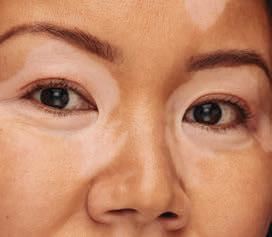





Not an OPZELURA® patient.



For












patients

12 years of age and older



CONSIDER OPZELURA




The First and Only FDA-Approved Treatment for Repigmentation in Nonsegmental Vitiligo 2*



Proven to Promote Skin Repigmentation in Phase III Clinical Trials2


F-VASI75 Results at Weeks 24 and 52
Data From Week 24 And an Open-Label Extension
Nearly patients 1 in 3

~51%



Nearly1 in 3 patients achieved F-VASI75† at 24 weeks (primary endpoint; 29.9% vs 7.5% [P<0.0001] and 29.9% vs 12.9% [P<0.01]).2,3

About half the patients remaining in the studies who applied OPZELURA® from day 1 achieved F-VASI75 at 52 weeks: 51% for OPZELURA® and 28% for vehicle-to-OPZELURA® (Week 24 to Week 52). Data were reported as observed. No conclusions of safety or efficacy should be made based on these results.2,4



Limitations of an open-label extension: In an open-label extension, there is a potential for enrichment of the long-term data in the remaining patient populations since patients who are unable to tolerate or do not respond to the drug often drop out.
OPZELURA® was studied in 2 double-blind, randomized, vehicle-controlled trials of identical design that enrolled 674 adult and adolescent patients with nonsegmental vitiligo ≥12 years of age. Patients had depigmented areas affecting ≥0.5% F-BSA, ≥3% nonfacial BSA, and total body vitiligo area (facial and nonfacial) of up to 10% BSA. Phototherapy was not permitted during the trials. In both trials, patients were randomized 2:1 to treatment with OPZELURA® or vehicle cream BID for 24 weeks followed by a 28-week open-label extension, wherein patients originally assigned to vehicle could switch to OPZELURA®. 2
*In patients 12 years of age and older.


BID, twice daily; BSA, body surface area; F-BSA, facial body surface area; FDA, Food and Drug Administration: F-VASI, Facial Vitiligo Scoring Index; F-VASI75, ≥75% improvement from baseline in Facial Vitiligo Area Scoring Index.
† F-VASI is a composite measurement of the overall area of facial vitiligo patches and degree of depigmentation within patches. As assessed, the face did not include surface area of the lips, scalp, eyelids, ears, or neck. 5





®2





Common Prior Authorization Requirements
Patient Age The patient must be 12 years of age or older.
Indication OPZELURA® is indicated for nonsegmental vitiligo
Tried and Failed Alternatives

Body Surface Area (BSA)



Combination Use

INDICATION

This may include a topical corticosteroid (TCS) and/or topical calcineurin inhibitor (TCI). Be sure to include your patient’s most recent chart notes!
Indicate the BSA that will be treated:
• Nonsegmental vitiligo is up to 10%
Confirm OPZELURA® will not be used with:
• Therapeutic biologics
• Other JAK inhibitors
• Potent immunosuppressants




OPZELURA® was studied as a monotherapy treatment. Many plans do not approve combination use.
Turn the page to see the results with OPZELURA® at 52 weeks
OPZELURA is indicated for the topical treatment of nonsegmental vitiligo in adult and pediatric patients 12 years of age and older.

Limitations of Use: Use of OPZELURA in combination with therapeutic biologics, other JAK inhibitors, or potent immunosuppressants such as azathioprine or cyclosporine is not recommended.
IMPORTANT SAFETY INFORMATION
SERIOUS INFECTIONS
Patients treated with oral Janus kinase inhibitors for inflammatory conditions are at risk for developing serious infections that may lead to hospitalization or death. Reported infections include:


• Active tuberculosis, which may present with pulmonary or extrapulmonary disease.
• Invasive fungal infections, including cryptococcosis and pneumocystosis.
• Bacterial, viral, including herpes zoster, and other infections due to opportunistic pathogens.


Avoid use of OPZELURA in patients with an active, serious infection, including localized infections. If a serious infection develops, interrupt OPZELURA until the infection is controlled. Carefully consider the benefits and risks of treatment prior to initiating OPZELURA

in patients with chronic or recurrent infection. Closely monitor patients for the development of signs and symptoms of infection during and after treatment with OPZELURA.


Serious lower respiratory tract infections were reported in the clinical development program with topical ruxolitinib.
No cases of active tuberculosis (TB) were reported in clinical trials with OPZELURA. Cases of active TB were reported in clinical trials of oral Janus kinase inhibitors used to treat inflammatory conditions. Consider evaluating patients for latent and active TB infection prior to administration of OPZELURA. During OPZELURA use, monitor patients for the development of signs and symptoms of TB.


Viral reactivation, including cases of herpes virus reactivation (e.g., herpes zoster), were reported in clinical trials with Janus kinase inhibitors used to treat inflammatory conditions including OPZELURA. If a patient develops herpes zoster, consider interrupting OPZELURA treatment until the episode resolves.
Hepatitis B viral load (HBV-DNA titer) increases, with or without associated elevations in alanine aminotransferase and aspartate aminotransferase, have been reported in patients with chronic HBV infections taking oral ruxolitinib. OPZELURA initiation is not recommended in patients with active hepatitis B or hepatitis C.



Please see Important Safety Information continued on next page and Brief Summary of Full Prescribing Information, including Boxed Warning, on the following pages.














52-Week Results for a Clinical Trial Participant Whose Repigmentation Met the Primary Endpoint of F-VASI75 at 24 Weeks6‡
PRIMARY ENDPOINT




eek 0

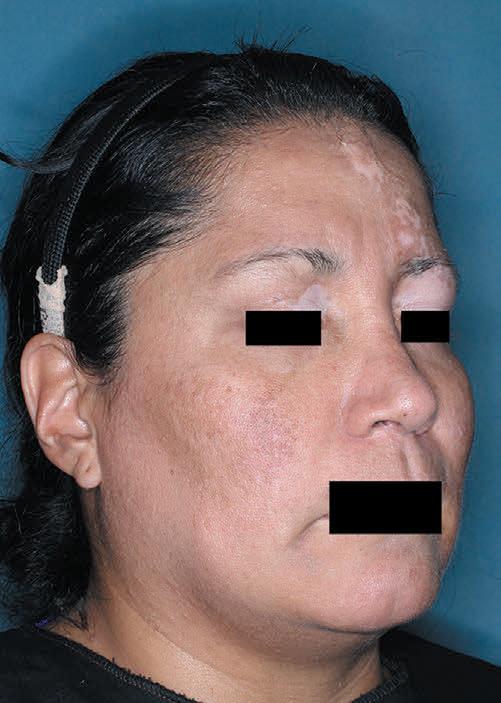


Improvement From Baseline




‡Results not typical. Actual patient treated with OPZELURA® in a clinical trial. Individual results may vary. Not for ophthalmic, oral, or intravaginal use.





See the Possibilities for Your Members With OPZELURA®
IMPORTANT SAFETY INFORMATION (continued)
MORTALITY


In a large, randomized, postmarketing safety study in rheumatoid arthritis (RA) patients
50 years of age and older with at least one cardiovascular risk factor comparing an oral JAK inhibitor to tumor necrosis factor (TNF) blocker treatment, a higher rate of all-cause mortality, including sudden cardiovascular death, was observed with the JAK inhibitor. Consider the benefits and risks for the individual patient prior to initiating or continuing therapy with OPZELURA.

MALIGNANCIES



Malignancies were reported in patients treated with OPZELURA. Lymphoma and other malignancies have been observed in patients receiving JAK inhibitors used to treat inflammatory conditions. In RA patients treated with an oral JAK inhibitor, a higher rate of malignancies (excluding non-melanoma skin

cancer (NMSC)) was observed when compared with TNF blockers. Patients who are current or past smokers are at additional increased risk. Consider the benefits and risks for the individual patient prior to initiating or continuing therapy with OPZELURA, particularly in patients with a known malignancy (other than successfully treated non-melanoma skin cancers), patients who develop a malignancy when on treatment, and patients who are current or past smokers. Non-melanoma skin cancers, including basal cell and squamous cell carcinoma, have occurred in patients treated with OPZELURA. Perform periodic skin examinations during OPZELURA treatment and following treatment as appropriate. Exposure to sunlight and UV light should be limited by wearing protective clothing and using broad-spectrum sunscreen.





W
F -VASI SCORE
W
F -VASI SCORE
80%
1.5
eek 24
0.3
W eek
F -VASI SCORE 0.3 80%
BASELINE WEEK 24 WEEK 52
52
Improvement From Baseline




IMPORTANT
MAJOR ADVERSE CARDIOVASCULAR EVENTS (MACE)



In RA patients 50 years of age and older with at least one cardiovascular risk factor treated with an oral JAK inhibitor, a higher rate of major adverse cardiovascular events (MACE) (defined as cardiovascular death, myocardial infarction, and stroke), was observed when compared with TNF blockers. Patients who are current or past smokers are at additional increased risk. Discontinue OPZELURA in patients who have experienced a myocardial infarction or stroke. Consider the benefits and risks for the individual patient prior to initiating or continuing therapy with OPZELURA, particularly in patients who are current or past smokers and patients with other cardiovascular risk factors. Patients should be informed about the symptoms of serious cardiovascular events and the steps to take if they occur. Discontinue OPZELURA in patients that have experienced a myocardial infarction or stroke.
THROMBOSIS



Thromboembolic events were observed in trials with OPZELURA. Thrombosis, including pulmonary embolism (PE), deep venous thrombosis (DVT), and arterial thrombosis have been reported in patients receiving JAK inhibitors used to treat inflammatory conditions. Many of these adverse reactions were serious and some resulted in death. In RA patients 50 years of age and older with at least one cardiovascular risk factor treated with an oral JAK inhibitor, a higher rate of thrombosis was observed when compared with TNF blockers. Avoid OPZELURA in patients at risk. If symptoms of thrombosis occur, discontinue OPZELURA and treat appropriately.



Thrombocytopenia, Anemia, and Neutropenia
Thrombocytopenia, anemia, and neutropenia were reported in the clinical trials with OPZELURA. Consider the benefits and risks for individual patients who have a known history of these events prior to initiating therapy with OPZELURA. Perform CBC monitoring as clinically indicated. If signs and/or symptoms of clinically significant thrombocytopenia, anemia, and neutropenia occur, patients should discontinue OPZELURA.
Lipid Elevations


Treatment with oral ruxolitinib has been associated with increases in lipid parameters including total cholesterol, low-density lipoprotein (LDL) cholesterol, and triglycerides.
Adverse Reactions
In nonsegmental vitiligo, the most common adverse reactions (incidence ≥1%) are application site acne (6%), application site pruritus (5%), nasopharyngitis (4%), headache (4%), urinary tract infection (2%), application site erythema (2%), and pyrexia (1%).


Pregnancy
There is a pregnancy registry that monitors pregnancy outcomes in pregnant persons exposed to OPZELURA during pregnancy. Pregnant persons exposed to OPZELURA and healthcare providers should report OPZELURA exposure by calling 1-855-463-3463.
Lactation


Advise women not to breastfeed during treatment with OPZELURA and for approximately four weeks after the last dose (approximately 5-6 elimination half-lives).
Please see Brief Summary of Full Prescribing Information, including Boxed Warning, on the following pages.

References: 1. VANTAGE Fingertip Formulary, April 2023. 2. OPZELURA® (ruxolitinib) cream. Prescribing Information. Incyte Corporation. 3. Rosmarin D, Pandya AG, Grimes P, et al. Efficacy and safety of ruxolitinib cream for the treatment of vitiligo: 24-week results from 2 randomized, double-blind phase 3 studies. Abstract presented at: 30th European Academy of Dermatology and Venereology (EADV) Congress; September 29-October 2, 2021; virtual. 4. Rosmarin D, Passeron T, Pandya AG, et al. Efficacy and safety of ruxolitinib cream monotherapy for the treatment of vitiligo: results from two 52-week phase 3 studies. Presented at: American Academy of Dermatology Annual Meeting; March 25-29, 2022; Oral Presentation. 5. Rosmarin D, Pandya AG, Lebwohl M, et al. Ruxolitinib cream for treatment of vitiligo: a randomised, controlled, phase 2 trial. Lancet 2020;396(suppl):1-121. 6. Data on File. Incyte Corporation.








OPZELURA, the OPZELURA logo, Incyte, and the Incyte logo are registered trademarks of Incyte. © 2023, Incyte Corporation. MAT-OPZ-01787 07/23










SAFETY
(continued)
INFORMATION
OPZELURA® (ruxolitinib) cream, for topical use
OPZELURA® (ruxolitinib) cream, for topical use
Brief Summary of FULL PRESCRIBING INFORMATION
Brief Summary of FULL PRESCRIBING INFORMATION
INDICATIONS AND USAGE: OPZELURA is indicated for the topical treatment of nonsegmental vitiligo in adult and pediatric patients 12 years of age and older.
initiating OPZELURA in patients: with chronic or recurrent infection; with a history of a serious or an opportunistic infection; who have been exposed to tuberculosis; who have resided or traveled in areas of endemic tuberculosis or endemic mycoses; or with underlying conditions that may predispose them to infection. Closely monitor patients for the development of signs and symptoms of infection during and after treatment with OPZELURA. Interrupt OPZELURA if a patient develops a serious infection, an opportunistic infection, or sepsis. Do not resume OPZELURA until the infection is controlled.
INDICATIONS AND USAGE: OPZELURA is indicated for the topical treatment of nonsegmental vitiligo in adult and pediatric patients 12 years of age and older.
Limitations of Use: Use of OPZELURA in combination with therapeutic biologics, other JAK inhibitors, or potent immunosuppressants such as azathioprine or cyclosporine is not recommended.
Limitations of Use: Use OPZELURA in combination with therapeutic biologics, other JAK inhibitors, or potent immunosuppressants such as azathioprine or cyclosporine is not recommended.
WARNING: SERIOUS INFECTIONS, MORTALITY, MALIGNANCY, MAJOR ADVERSE CARDIOVASCULAR EVENTS, AND THROMBOSIS
initiating OPZELURA in patients: with chronic or recurrent infection; with a history of a serious or an opportunistic infection; who have been exposed to tuberculosis; who have resided or traveled in areas of endemic tuberculosis or endemic mycoses; or with underlying conditions that may predispose them to infection. Closely monitor patients for the development of signs and symptoms of infection during and after treatment with OPZELURA. Interrupt OPZELURA if a patient develops a serious infection, an opportunistic infection, or sepsis. Do not resume OPZELURA until the infection is controlled.
Tuberculosis: No cases of active tuberculosis (TB) were reported in clinical trials with OPZELURA. Cases of active TB were reported in clinical trials of oral Janus kinase inhibitors used to treat inflammatory conditions. Consider evaluating patients for latent and active TB infection prior to administration of OPZELURA. During OPZELURA use, monitor patients for the development of signs and symptoms of TB.
WARNING: SERIOUS INFECTIONS, MORTALITY, MALIGNANCY, MAJOR ADVERSE CARDIOVASCULAR EVENTS, AND THROMBOSIS
SERIOUS INFECTIONS
SERIOUS INFECTIONS
Patients treated with oral Janus kinase inhibitors for inflammatory conditions are at risk for developing serious infections that may lead to hospitalization or death [see Warnings and Precautions and Adverse Reactions].
Tuberculosis: No cases of active tuberculosis (TB) were reported in clinical trials with OPZELURA. Cases of active TB were reported in clinical trials of oral Janus kinase inhibitors used to treat inflammatory conditions. Consider evaluating patients for latent and active TB infection prior to administration of OPZELURA. During OPZELURA use, monitor patients for the development of signs and symptoms of TB.
Viral Reactivation: Viral reactivation, including cases of herpes virus reactivation (e.g., herpes zoster), were reported in clinical trials with Janus kinase inhibitors used to treat inflammatory conditions including OPZELURA. If a patient develops herpes zoster, consider interrupting OPZELURA treatment until the episode resolves.
Patients treated with oral Janus kinase inhibitors for inflammatory conditions are at risk for developing serious infections that may lead to hospitalization or death [see Warnings and Precautions and Adverse Reactions].
Reported infections include:
Reported infections include:
• Active tuberculosis, which may present with pulmonary or extrapulmonary disease.
Viral Reactivation: Viral reactivation, including cases of herpes virus reactivation (e.g., herpes zoster), were reported in clinical trials with Janus kinase inhibitors used to treat inflammatory conditions including OPZELURA. If a patient develops herpes zoster, consider interrupting OPZELURA treatment until the episode resolves.
Hepatitis B and C: The impact of Janus kinase inhibitors used to treat inflammatory conditions including OPZELURA on chronic viral hepatitis reactivation is unknown. Patients with a history of hepatitis B or C infection were excluded from clinical trials.
• Active tuberculosis, which may present with pulmonary or extrapulmonary disease.
• Invasive fungal infections, including cryptococcosis, and pneumocystosis.
• Invasive fungal infections, including cryptococcosis, and pneumocystosis.
• Bacterial, viral, including herpes zoster, and other infections due to opportunistic pathogens.
Hepatitis B and C: The impact of Janus kinase inhibitors used to treat inflammatory conditions including OPZELURA on chronic viral hepatitis reactivation is unknown. Patients with a history of hepatitis B or C infection were excluded from clinical trials.
Hepatitis B viral load (HBV-DNA titer) increases, with or without associated elevations in alanine aminotransferase and aspartate aminotransferase, have been reported in patients with chronic HBV infections taking oral ruxolitinib. OPZELURA initiation is not recommended in patients with active hepatitis B or hepatitis C.
• Bacterial, viral, including herpes zoster, and other infections due to opportunistic pathogens.
Avoid use of OPZELURA in patients with an active, serious infection, including localized infections. If a serious infection develops, interrupt OPZELURA until the infection is controlled.
Avoid use of OPZELURA in patients with an active, serious infection, including localized infections. If a serious infection develops, interrupt OPZELURA until the infection is controlled.
The risks and benefits of treatment with OPZELURA should be carefully considered prior to initiating therapy in patients with chronic or recurrent infection.
Hepatitis B viral load (HBV-DNA titer) increases, with or without associated elevations in alanine aminotransferase and aspartate aminotransferase, have been reported in patients with chronic HBV infections taking oral ruxolitinib. OPZELURA initiation is not recommended in patients with active hepatitis B or hepatitis C.
Mortality: In a large, randomized, postmarketing safety study of an oral JAK inhibitor in rheumatoid arthritis (RA) patients 50 years of age and older with at least one cardiovascular risk factor, a higher rate of all-cause mortality, including sudden cardiovascular death, was observed in patients treated with the JAK inhibitor compared with TNF blockers. Consider the benefits and risks for the individual patient prior to initiating or continuing therapy with OPZELURA.
The risks and benefits of treatment with OPZELURA should be carefully considered prior to initiating therapy in patients with chronic or recurrent infection.
Patients should be closely monitored for the development of signs and symptoms of infection during and after treatment with OPZELURA [see Warnings and Precautions].
Patients should be closely monitored for the development of signs and symptoms of infection during and after treatment with OPZELURA [see Warnings and Precautions].
MORTALITY
MORTALITY
In a large, randomized, postmarketing safety study in rheumatoid arthritis (RA) patients 50 years of age and older with at least one cardiovascular risk factor comparing an oral JAK inhibitor to tumor necrosis factor (TNF) blocker treatment, a higher rate of all-cause mortality, including sudden cardiovascular death, was observed with the JAK inhibitor [see Warnings and Precautions].
In a large, randomized, postmarketing safety study in rheumatoid arthritis (RA) patients 50 years of age and older with at least one cardiovascular risk factor comparing an oral JAK inhibitor to tumor necrosis factor (TNF) blocker treatment, a higher rate of all-cause mortality, including sudden cardiovascular death, was observed with the JAK inhibitor [see Warnings and Precautions].
MALIGNANCIES
MALIGNANCIES
Malignancies were reported in patients treated with OPZELURA. Lymphoma and other malignancies have been observed in patients receiving JAK inhibitors used to treat inflammatory conditions. In RA patients treated with an oral JAK inhibitor, a higher rate of malignancies (excluding non-melanoma skin cancer (NMSC)) was observed when compared with TNF blockers. Patients who are current or past smokers are at additional increased risk [see Warnings and Precautions].
Malignancies were reported in patients treated with OPZELURA. Lymphoma and other malignancies have been observed in patients receiving JAK inhibitors used to treat inflammatory conditions. In RA patients treated with an oral JAK inhibitor, a higher rate of malignancies (excluding non-melanoma skin cancer (NMSC)) was observed when compared with TNF blockers. Patients who are current or past smokers are at additional increased risk [see Warnings and Precautions].
MAJOR ADVERSE CARDIOVASCULAR EVENTS (MACE)
MAJOR ADVERSE CARDIOVASCULAR EVENTS (MACE)
In RA patients 50 years of age and older with at least one cardiovascular risk factor treated with an oral JAK inhibitor, a higher rate of major adverse cardiovascular events (MACE) (defined as cardiovascular death, myocardial infarction, and stroke), was observed when compared with TNF blockers. Patients who are current or past smokers are at additional increased risk. Discontinue OPZELURA in patients who have experienced a myocardial infarction or stroke [see Warnings and Precautions].
THROMBOSIS
Mortality: In a large, randomized, postmarketing safety study of an oral JAK inhibitor in rheumatoid arthritis (RA) patients 50 years of age and older with at least one cardiovascular risk factor, a higher rate of all-cause mortality, including sudden cardiovascular death, was observed in patients treated with the JAK inhibitor compared with TNF blockers. Consider the benefits and risks for the individual patient prior to initiating or continuing therapy with OPZELURA.
Malignancy and Lymphoproliferative Disorders: Malignancies, including lymphomas, were observed in clinical trials of oral JAK inhibitors used to treat inflammatory conditions. Patients who are current or past smokers are at additional increased risk. Malignancies, including lymphomas, have occurred in patients receiving JAK inhibitors used to treat inflammatory conditions. In a large, randomized, postmarketing safety study of an oral JAK inhibitor in RA patients, a higher rate of malignancies (excluding non-melanoma skin cancer) was observed in patients treated with the JAK inhibitor compared to those treated with TNF blockers. A higher rate of lymphomas was observed in patients treated with the JAK inhibitor compared to those treated with TNF blockers. A higher rate of lung cancers was observed in current or past smokers treated with the JAK inhibitor compared to those treated with TNF blockers. In this study, current or past smokers had an additional increased risk of overall malignancies. Consider the benefits and risks for the individual patient prior to initiating or continuing therapy with OPZELURA, particularly in patients with a known malignancy (other than successfully treated non-melanoma skin cancers), patients who develop a malignancy when on treatment, and patients who are current or past smokers.
Non-melanoma Skin Cancers: Non-melanoma skin cancers including basal cell and squamous cell carcinoma have occurred in patients treated with OPZELURA. Perform periodic skin examinations during OPZELURA treatment and following treatment as appropriate. Exposure to sunlight and UV light should be limited by wearing protective clothing and using broad-spectrum sunscreen.
In RA patients 50 years of age and older with at least one cardiovascular risk factor treated with an oral JAK inhibitor, a higher rate of major adverse cardiovascular events (MACE) (defined as cardiovascular death, myocardial infarction, and stroke), was observed when compared with TNF blockers. Patients who are current or past smokers are at additional increased risk. Discontinue OPZELURA in patients who have experienced a myocardial infarction or stroke [see Warnings and Precautions].
THROMBOSIS
Thromboembolic events were observed in trials with OPZELURA. Thrombosis, including pulmonary embolism (PE), deep venous thrombosis (DVT), and arterial thrombosis have been reported in patients receiving JAK inhibitors used to treat inflammatory conditions. Many of these adverse reactions were serious and some resulted in death. In RA patients 50 years of age and older with at least one cardiovascular risk factor treated with an oral JAK inhibitor, a higher rate of thrombosis was observed when compared with TNF blockers. Avoid OPZELURA in patients at risk. If symptoms of thrombosis occur, discontinue OPZELURA and treat appropriately [see Warnings and Precautions].
Thromboembolic events were observed in trials with OPZELURA. Thrombosis, including pulmonary embolism (PE), deep venous thrombosis (DVT), and arterial thrombosis have been reported in patients receiving JAK inhibitors used to treat inflammatory conditions. Many of these adverse reactions were serious and some resulted in death. In RA patients 50 years of age and older with at least one cardiovascular risk factor treated with an oral JAK inhibitor, a higher rate of thrombosis was observed when compared with TNF blockers. Avoid OPZELURA in patients at risk. If symptoms of thrombosis occur, discontinue OPZELURA and treat appropriately [see Warnings and Precautions].
WARNINGS AND PRECAUTIONS
WARNINGS AND PRECAUTIONS
Serious Infections: Serious and sometimes fatal infections due to bacterial, mycobacterial, invasive fungal, viral, or other opportunistic pathogens have been reported in patients receiving oral Janus kinase inhibitors. Serious lower respiratory tract infections were reported in the clinical development program with topical ruxolitinib. Avoid use of OPZELURA in patients with an active, serious infection, including localized infections. Consider the risks and benefits of treatment prior to
Malignancy and Lymphoproliferative Disorders: Malignancies, including lymphomas, were observed in clinical trials of oral JAK inhibitors used to treat inflammatory conditions. Patients who are current or past smokers are at additional increased risk. Malignancies, including lymphomas, have occurred in patients receiving JAK inhibitors used to treat inflammatory conditions. In a large, randomized, postmarketing safety study of an oral JAK inhibitor in RA patients, a higher rate of malignancies (excluding non-melanoma cancer) was observed in patients treated with the JAK inhibitor compared to those treated with TNF blockers. A higher rate of lymphomas was observed in patients treated with the JAK inhibitor compared to those treated with TNF blockers. A higher rate of lung cancers was observed in current or past smokers treated with the JAK inhibitor compared to those treated with TNF blockers. In this study, current or past smokers had an additional increased risk of overall malignancies. Consider the benefits and risks for the individual patient prior to initiating or continuing therapy with OPZELURA, particularly in patients with a known malignancy (other than successfully treated non-melanoma skin cancers), patients who develop a malignancy when on treatment, and patients who are current or past smokers. Non-melanoma Skin Cancers: Non-melanoma skin cancers including basal cell and squamous cell carcinoma have occurred in patients treated with OPZELURA. Perform periodic skin examinations during OPZELURA treatment and following treatment as appropriate. Exposure to sunlight and UV light should be limited by wearing protective clothing and using broad-spectrum sunscreen.
Major Adverse Cardiovascular Events (MACE): In a large, randomized, postmarketing safety study of an oral JAK inhibitor in RA patients 50 years of age and older with at least one cardiovascular risk factor, a higher rate of major adverse cardiovascular events (MACE) defined as cardiovascular death, non-fatal myocardial infarction (MI), and non-fatal stroke was observed with the JAK inhibitor compared to those treated with TNF blockers. Patients who are current or past smokers are at additional increased risk. Consider the benefits and risks for the individual patient prior to initiating or continuing therapy with OPZELURA , particularly in patients who are current or past smokers and patients with other cardiovascular risk factors. Patients should be informed about the symptoms of serious cardiovascular events and the steps to take if they occur. Discontinue OPZELURA in patients that have experienced a myocardial infarction or stroke.
Major Adverse Cardiovascular Events (MACE): In a large, randomized, postmarketing safety study of an oral JAK inhibitor in RA patients 50 years of age and older with at least one cardiovascular risk factor, a higher rate of major adverse cardiovascular events (MACE) defined as cardiovascular death, non-fatal myocardial infarction (MI), and non-fatal stroke was observed with the JAK inhibitor compared to those treated with TNF blockers. Patients who are current or past smokers are at additional increased risk. Consider the benefits and risks for the individual patient prior to initiating or continuing therapy with OPZELURA , particularly in patients who are current or past smokers and patients with other cardiovascular risk factors. Patients should be informed about the symptoms of serious cardiovascular events and the steps to take if they occur. Discontinue OPZELURA in patients that have experienced a myocardial infarction or stroke.
Thrombosis: Thromboembolic events were observed in clinical trials with OPZELURA. Thrombosis, including deep vein thrombosis (DVT), pulmonary embolism (PE), and arterial thrombosis have been reported in patients receiving JAK inhibitors used to treat inflammatory conditions. Many of these adverse reactions were serious and some resulted in death. In a large, randomized, postmarketing safety study of an oral JAK inhibitor in RA patients 50 years of age and older with at least one cardiovascular risk factor, higher rates of overall thrombosis, DVT, and PE were observed compared to those treated with TNF blockers. Avoid OPZELURA in patients who may be at increased risk of thrombosis. If symptoms of thrombosis occur, discontinue OPZELURA and evaluate and treat patients appropriately.
Serious Infections: Serious and sometimes fatal infections due to bacterial, mycobacterial, invasive fungal, viral, or other opportunistic pathogens have been reported in patients receiving oral Janus kinase inhibitors. Serious lower respiratory tract infections were reported in the clinical development program with topical ruxolitinib. Avoid use of OPZELURA in patients with an active, serious infection, including localized infections. Consider the risks and benefits of treatment prior to
Thrombosis: Thromboembolic events were observed in clinical trials with OPZELURA. Thrombosis, including deep vein thrombosis (DVT), pulmonary embolism (PE), and arterial thrombosis have been reported in patients receiving JAK inhibitors used to treat inflammatory conditions. Many of these adverse reactions were serious and some resulted in death. In a large, randomized, postmarketing safety study of an oral JAK inhibitor in RA patients 50 years of age and older with at least one cardiovascular risk factor, higher rates of overall thrombosis, DVT, and PE were observed compared to those treated with TNF blockers. Avoid OPZELURA in patients who may be at increased risk of thrombosis. If symptoms of thrombosis occur, discontinue OPZELURA and evaluate and treat patients appropriately.
Thrombocytopenia, Anemia, and Neutropenia: Thrombocytopenia, anemia, and neutropenia were reported in the clinical trials with OPZELURA. Consider the benefits and risks for individual patients who have a known history of these events prior to initiating therapy with OPZELURA. Perform CBC monitoring as clinically indicated. If signs and/or symptoms of clinically significant thrombocytopenia, anemia, and neutropenia occur, patients should discontinue OPZELURA.
Thrombocytopenia, Anemia, and Neutropenia: Thrombocytopenia, anemia, and neutropenia were reported in the clinical trials with OPZELURA. Consider the benefits and risks for individual patients who have a known history of these events prior to initiating therapy with OPZELURA. Perform CBC monitoring as clinically indicated. If signs and/or symptoms of clinically significant thrombocytopenia, anemia, and neutropenia occur, patients should discontinue OPZELURA.
Lipid Elevations: Treatment with oral ruxolitinib has been associated with increases in lipid parameters including total cholesterol, low-density lipoprotein (LDL) cholesterol, and triglycerides.
Data: Lactating rats were administered a single dose of [14C]-labeled ruxolitinib (30 mg/kg) on postnatal Day 10, after which plasma and milk samples were collected for up to 24 hours. The AUC for total radioactivity in milk was approximately 13 times the maternal plasma AUC. Additional analysis showed the presence of ruxolitinib and several of its metabolites in milk, all at levels higher than those in maternal plasma.
Lipid Elevations: Treatment with oral ruxolitinib has been associated with increases in lipid parameters including total low-density lipoprotein (LDL) cholesterol, and triglycerides.
ADVERSE REACTIONS
ADVERSE REACTIONS
Clinical Trials Experience: Because clinical trials are conducted under widely varying conditions, adverse reaction rates observed in the clinical trials of a drug cannot be directly compared to rates in the clinical trials of another drug and may not reflect the rates observed in practice. In two double-blind, vehicle-controlled clinical trials (TRuE-V1 and TRuE-V2), 449 adult and pediatric subjects 12 years of age and older with nonsegmental vitiligo were treated with OPZELURA twice daily for 24 weeks. In the OPZELURA group, 55% of subjects were females, and 81% of subjects were White, 5% were Black, and 4% were Asian. The adverse reactions reported by OPZELURA treated subjects with an incidence of ≥ 1% and at least 1% greater incidence than in the vehicle arm in the 24-week double-blind period are as follows for OPZELURA (N=449) vs Vehicle (N=224), respectively: Subjects with any treatment emergent adverse event (TEAE) 214 (48%) vs 79 (35%), Application site acne 26 (6%) vs 2 (1%), Application site pruritus 23 (5%) vs 6 (3%), Nasopharyngitis 19 (4%) vs 5 (2%), Headache 17 (4%) vs 6 (3%), Urinary tract infection 7 (2%) vs 1 (<1%), Application site erythema 7 (2%) vs 1 (<1%), and Pyrexia 6 (1%) vs 0 (0%).
Clinical Trials Experience: Because clinical trials are conducted under widely varying conditions, adverse reaction rates observed in the clinical trials of a drug cannot be directly compared to rates in the clinical trials of another drug and may not reflect the rates observed in practice. In two double-blind, vehicle-controlled clinical trials (TRuE-V1 and TRuE-V2), 449 adult and pediatric subjects 12 years of age and older with nonsegmental vitiligo were treated with OPZELURA twice daily for 24 weeks. In the OPZELURA group, 55% of subjects were females, and 81% of subjects were White, 5% were Black, and 4% were Asian. The adverse reactions reported by OPZELURA treated subjects with an incidence of ≥ 1% and at least 1% greater incidence than in the vehicle arm in the 24-week double-blind period are as follows for OPZELURA (N=449) vs Vehicle (N=224), respectively: Subjects with any treatment emergent adverse event (TEAE) 214 (48%) vs 79 (35%), Application site acne 26 (6%) vs 2 (1%), Application site pruritus 23 (5%) vs 6 (3%), Nasopharyngitis 19 (4%) vs 5 (2%), Headache 17 (4%) vs 6 (3%), Urinary tract infection 7 (2%) vs 1 (<1%), Application site erythema 7 (2%) vs 1 (<1%), and Pyrexia 6 (1%) vs 0 (0%).
Adverse reactions that occurred in TRuE-V1 and TRuE-V2 in ≥ 0.5% to < 1% of subjects in the OPZELURA group and none in the vehicle group were: application site dermatitis, hypertension, anxiety, application site discoloration, application site folliculitis, contusion, dermatitis contact, diarrhea, ear infection, gastritis, gastroenteritis, hordeolum, influenza-like illness, insomnia, nasal congestion, and vomiting.
Data: Lactating rats were administered a single dose of [14C]-labeled ruxolitinib (30 mg/kg) on postnatal Day 10, after which plasma and milk samples were collected for up to 24 hours. The AUC for total radioactivity in milk was approximately 13 times the maternal plasma AUC. Additional analysis showed the presence of ruxolitinib and several of its metabolites in milk, all at levels higher than those in maternal plasma.
Pediatric Use: Nonsegmental Vitiligo: The safety and effectiveness of OPZELURA for the topical treatment of nonsegmental vitiligo have been established in pediatric patients aged 12 to 17 years of age. Use of OPZELURA in this age group is supported by evidence from TRuE-V1 and TRuE-V2, which included 55 pediatric subjects aged 12 to 17 years with nonsegmental vitiligo. No clinically meaningful differences in safety or effectiveness were observed between adult and pediatric subjects. The safety and effectiveness of OPZELURA in pediatric patients younger than 12 years of age with nonsegmental vitiligo have not been established.
Pediatric Use: Nonsegmental Vitiligo: The safety and effectiveness of OPZELURA for the topical treatment of nonsegmental vitiligo have been established in pediatric patients aged 12 to 17 years of age. Use of OPZELURA in this age group is supported by evidence from TRuE-V1 and TRuE-V2, which included 55 pediatric subjects aged 12 to 17 years with nonsegmental vitiligo. No clinically meaningful differences in safety or effectiveness were observed between adult and pediatric subjects. The safety and effectiveness of OPZELURA in pediatric patients younger than 12 years of age with nonsegmental vitiligo have not been established.
Juvenile Animal Toxicity Data: Oral administration of ruxolitinib to juvenile rats resulted in effects on growth and bone measures. When administered starting at postnatal day 7 (the equivalent of a human newborn) at doses of 1.5 to 75 mg/kg/day, evidence of fractures occurred at doses ≥ 30 mg/kg/day, and effects on body weight and other bone measures [e.g., bone mineral content, peripheral quantitative computed tomography, and x-ray analysis] occurred at doses ≥ 5 mg/kg/day. When administered starting at postnatal day 21 (the equivalent of a human 2-3 years of age) at doses of 5 to 60 mg/kg/day, effects on body weight and bone occurred at doses ≥ 15 mg/kg/day, which were considered adverse at 60 mg/kg/day. Males were more severely affected than females in all age groups, and effects were generally more severe when administration was initiated earlier in the postnatal period. These findings were observed at systemic exposures that are at least 40% the MRHD clinical systemic exposure.
Adverse reactions that occurred in TRuE-V1 and TRuE-V2 in ≥ 0.5% to < 1% of subjects in the OPZELURA group and none in the vehicle group were: application site dermatitis, hypertension, anxiety, application site discoloration, application site folliculitis, contusion, dermatitis contact, diarrhea, ear infection, gastritis, gastroenteritis, hordeolum, influenza-like illness, insomnia, nasal congestion, and vomiting.
DRUG INTERACTIONS
DRUG INTERACTIONS
Drug interaction studies with OPZELURA have not been conducted. Ruxolitinib is known to be a substrate for cytochrome P450 3A4 (CYP3A4) Inhibitors of CYP3A4 may increase ruxolitinib systemic concentrations whereas inducers of CYP3A4 may decrease ruxolitinib systemic concentrations.
Juvenile Animal Toxicity Data: Oral administration of ruxolitinib to juvenile rats resulted in effects on growth and bone measures. When administered starting at postnatal day 7 (the equivalent of a human newborn) at doses of 1.5 to 75 mg/kg/day, evidence of fractures occurred at doses ≥ 30 mg/kg/day, and effects on body weight and other bone measures [e.g., bone mineral content, peripheral quantitative computed tomography, and x-ray analysis] occurred at doses ≥ 5 mg/kg/day. When administered starting at postnatal day 21 (the equivalent of a human 2-3 years of age) at doses of 5 to 60 mg/kg/day, effects on body weight and bone occurred at doses ≥ 15 mg/kg/day, which were considered adverse at 60 mg/kg/day. Males were more severely affected than females in all age groups, and effects were generally more severe when administration was initiated earlier in the postnatal period. These findings were observed at systemic exposures that are at least 40% the MRHD clinical systemic exposure.
Geriatric Use: Of the 831 total subjects enrolled with nonsegmental vitiligo in clinical trials with OPZELURA, 65 (8%) were 65 years of age and older. Clinical trials of OPZELURA in subjects with nonsegmental vitiligo did not include sufficient numbers of subjects 65 years of age and older to determine whether they respond differently from younger adult subjects.
Geriatric Use: Of the 831 total subjects enrolled with nonsegmental vitiligo in clinical trials with OPZELURA, 65 (8%) were 65 years of age and older. Clinical trials of OPZELURA in subjects with nonsegmental vitiligo did not include sufficient numbers of subjects 65 years of age and older to determine whether they respond differently from younger adult subjects.
PATIENT COUNSELING INFORMATION
Drug interaction studies with OPZELURA have not been conducted. Ruxolitinib is known to be a substrate for cytochrome P450 3A4 (CYP3A4) Inhibitors of CYP3A4 may increase ruxolitinib systemic concentrations whereas inducers of CYP3A4 may decrease ruxolitinib systemic concentrations.
Strong Inhibitors of CYP3A4: Avoid concomitant use of OPZELURA with strong inhibitors of CYP3A4 as there is a potential to increase the systemic exposure of ruxolitinib and could increase the risk of OPZELURA adverse reactions.
PATIENT COUNSELING INFORMATION
Advise the patient or caregivers to read the FDA-approved patient labeling (Medication Guide).
Strong Inhibitors of CYP3A4: Avoid concomitant use of OPZELURA with strong inhibitors of CYP3A4 as there is a potential to increase the systemic exposure of ruxolitinib and could increase the risk of OPZELURA adverse reactions.
USE IN SPECIFIC POPULATIONS
Pregnancy
USE IN SPECIFIC POPULATIONS
Pregnancy
Pregnancy Exposure Registry: There is a pregnancy registry that monitors pregnancy outcomes in pregnant persons exposed to OPZELURA during pregnancy. Pregnant persons exposed to OPZELURA and healthcare providers should report OPZELURA exposure by calling 1-855-463-3463.
Advise the patient or caregivers to read the FDA-approved patient labeling (Medication Guide).
Infections: Inform patients that they may be at increased risk for developing infections, including serious infections, when taking Janus kinase inhibitors. Instruct patients to tell their healthcare provider if they develop any signs or symptoms of an infection. Advise patients that Janus kinase inhibitors increase the risk of herpes zoster, and some cases can be serious [see Warnings and Precautions]
Pregnancy Exposure Registry: There is a pregnancy registry that monitors pregnancy outcomes in pregnant persons exposed to OPZELURA during pregnancy. Pregnant persons exposed to OPZELURA and healthcare providers should report OPZELURA exposure by calling 1-855-463-3463.
Risk Summary: Available data from pregnancies reported in clinical trials with OPZELURA are not sufficient to evaluate a drug-associated risk for major birth defects, miscarriage, or other adverse maternal or fetal outcomes. In animal reproduction studies, oral administration of ruxolitinib to pregnant rats and rabbits during the period of organogenesis resulted in adverse developmental outcomes at doses associated with maternal toxicity. The background risks of major birth defects and miscarriage for the indicated populations are unknown. All pregnancies carry some risk of birth defects, loss, or other adverse outcomes. The background risk in the U.S. general population of major birth defects and miscarriage is 2-4% and 15-20%, respectively.
Data
Infections: Inform patients that they may be at increased risk for developing infections, including serious infections, when taking Janus kinase inhibitors. Instruct patients to tell their healthcare provider if they develop any signs or symptoms of an infection. Advise patients that Janus kinase inhibitors increase the risk of herpes zoster, and some cases can be serious [see Warnings and Precautions]
Malignancies and Lymphoproliferative Disorders: Inform patients that Janus kinase inhibitors may increase the risk for developing lymphomas and other malignancies including skin cancer. Instruct patients to inform their health care provider if they have ever had any type of cancer. Inform patients that periodic skin examinations should be performed while using OPZELURA. Advise patients that exposure to sunlight, and UV light should be limited by wearing protective clothing and using a broad-spectrum sunscreen [see Warnings and Precautions]
Risk Summary: Available data from pregnancies reported in clinical trials with OPZELURA are not sufficient to evaluate a drug-associated risk for major birth defects, miscarriage, or other adverse maternal or fetal outcomes. In animal reproduction studies, oral administration of ruxolitinib to pregnant rats and rabbits during the period of organogenesis resulted in adverse developmental outcomes at doses associated with maternal toxicity. The background risks of major birth defects and miscarriage for the indicated populations are unknown. All pregnancies carry some risk of birth defects, loss, or other adverse outcomes. The background risk in the U.S. general population of major birth defects and miscarriage is 2-4% and 15-20%, respectively.
Data
Animal Data: Ruxolitinib was administered orally to pregnant rats or rabbits during the period of organogenesis, at doses of 15, 30, or 60 mg/kg/day in rats and 10, 30, or 60 mg/kg/day in rabbits. There were no treatment-related malformations at any dose. A decrease in fetal weight of approximately 9% was noted in rats at the highest and maternally toxic dose of 60 mg/kg/day. This dose resulted in systemic exposure approximately 22 times the clinical systemic exposure at the maximum recommended human dose (MRHD; the clinical systemic exposure from ruxolitinib cream, 1.5% applied twice daily to 25-40% atopic dermatitisaffected body surface area is used for calculation of multiples of human exposure). In rabbits, lower fetal weights of approximately 8% and increased late resorptions were noted at the highest and maternally toxic dose of 60 mg/kg/day. This dose resulted in systemic exposure approximately 70% the MRHD clinical systemic exposure. In a pre-and post-natal development study in rats, pregnant animals were dosed with ruxolitinib from implantation through lactation at doses up to 30 mg/kg/day. There were no drug-related adverse effects on embryofetal survival, postnatal growth, development parameters or offspring reproductive function at the highest dose evaluated (3.1 times the MRHD clinical systemic exposure).
Lactation
Malignancies and Lymphoproliferative Disorders: Inform patients that Janus kinase inhibitors may increase the risk for developing lymphomas and other malignancies including skin cancer. Instruct patients to inform their health care provider if they have ever had any type of cancer. Inform patients that periodic skin examinations should be performed while using OPZELURA. Advise patients that exposure to sunlight, and UV light should be limited by wearing protective clothing and using a broad-spectrum sunscreen [see Warnings and Precautions]
Major Adverse Cardiovascular Events: Advise patients that events of major adverse cardiovascular events (MACE) including non-fatal myocardial infarction, non-fatal stroke, and cardiovascular death, have been reported in clinical studies with Janus kinase inhibitors used to treat inflammatory conditions. Instruct all patients, especially current or past smokers or patients with other cardiovascular risk factors, to be alert for the development of signs and symptoms of cardiovascular events [see Warnings and Precautions]
Major Adverse Cardiovascular Events: Advise patients that events of major adverse cardiovascular events (MACE) including non-fatal myocardial infarction, non-fatal stroke, and cardiovascular death, have been reported in clinical studies with Janus kinase inhibitors used to treat inflammatory conditions. Instruct all patients, especially current or past smokers or patients with other cardiovascular risk factors, to be alert for the development of signs and symptoms of cardiovascular events [see Warnings and Precautions]
Thrombosis: Advise patients that events of DVT and PE have been reported in clinical studies with Janus kinase inhibitors used to treat inflammatory conditions. Instruct patients to tell their healthcare provider if they develop any signs or symptoms of a DVT or PE [see Warnings and Precautions]
Animal Data: Ruxolitinib was administered orally to pregnant rats or rabbits during the period of organogenesis, at doses of 15, 30, or 60 mg/kg/day in rats and 10, 30, or 60 mg/kg/day in rabbits. There were no treatment-related malformations at any dose. A decrease in fetal weight of approximately 9% was noted in rats at the highest and maternally toxic dose of 60 mg/kg/day. This dose resulted in systemic exposure approximately 22 times the clinical systemic exposure at the maximum recommended human dose (MRHD; the clinical systemic exposure from ruxolitinib cream, 1.5% applied twice daily to 25-40% atopic dermatitisaffected body surface area is used for calculation of multiples of human exposure). In rabbits, lower fetal weights of approximately 8% and increased late resorptions were noted at the highest and maternally toxic dose of 60 mg/kg/day. This dose resulted in systemic exposure approximately 70% the MRHD clinical systemic exposure. In a pre-and post-natal development study in rats, pregnant animals were dosed with ruxolitinib from implantation through lactation at doses up to 30 mg/kg/day. There were no drug-related adverse effects on embryofetal survival, postnatal growth, development parameters or offspring reproductive function at the highest dose evaluated (3.1 times the MRHD clinical systemic exposure).
Lactation
Risk Summary: There are no data on the presence of ruxolitinib in human milk, the effects on the breastfed child, or the effects on milk production. Ruxolitinib was present in the milk of lactating rats. When a drug is present in animal milk, it is likely that the drug will be present in human milk. Because of the serious adverse findings in adults, including risks of serious infections, thrombocytopenia, anemia, and neutropenia, advise women not to breastfeed during treatment with OPZELURA and for approximately four weeks after the last dose (approximately 5-6 elimination half-lives).
Thrombosis: Advise patients that events of DVT and PE have been reported in clinical studies with Janus kinase inhibitors used to treat inflammatory conditions. Instruct patients to tell their healthcare provider if they develop any signs or symptoms of a DVT or PE [see Warnings and Precautions]
Thrombocytopenia, Anemia , and Neutropenia: Advise patients of the risk of thrombocytopenia, anemia, and neutropenia with OPZELURA. Instruct patients to tell their healthcare provider if they develop any signs or symptoms of thrombocytopenia, anemia , or neutropenia [see Warnings and Precautions]
Thrombocytopenia, Anemia , and Neutropenia: Advise patients of the risk of thrombocytopenia, anemia, and neutropenia with OPZELURA. Instruct patients to tell their healthcare provider if they develop any signs or symptoms of thrombocytopenia, anemia , or neutropenia [see Warnings and Precautions]
Administration Instructions: Advise patients or caregivers that OPZELURA is for topical use only [see Dosage and Administration]
Administration Instructions: Advise patients or caregivers that OPZELURA is for topical use only [see Dosage and Administration]
Advise patients to limit treatment to one 60 gram tube per week or one 100 gram tube per 2 weeks [see Dosage and Administration]
Advise patients to limit treatment to one 60 gram tube per week or one 100 gram tube per 2 weeks [see Dosage and Administration]
Pregnancy: Inform patients to report their pregnancy to Incyte Corporation at 1-855-463-3463 [see Use in Specific Populations]
Pregnancy: Inform patients to report their pregnancy to Incyte Corporation at 1-855-463-3463 [see Use in Specific Populations]
Lactation: Advise a patient not to breastfeed during treatment with OPZELURA and for about four weeks after the last dose [see Use in Specific Populations].
Lactation: Advise a patient not to breastfeed during treatment with OPZELURA and for about four weeks after the last dose [see Use in Specific Populations].
Manufactured for: Incyte Corporation 1801 Augustine Cut-off Wilmington, DE 19803
Risk Summary: There are no data on the presence of ruxolitinib in human milk, the effects on the breastfed child, or the effects on milk production. Ruxolitinib was present in the milk of lactating rats. When a drug is present in animal milk, it is likely that the drug will be present in human milk. Because of the serious adverse findings in adults, including risks of serious infections, thrombocytopenia, anemia, and neutropenia, advise women not to breastfeed during treatment with OPZELURA and for approximately four weeks after the last dose (approximately 5-6 elimination half-lives).
Manufactured for: Incyte Corporation 1801 Augustine Cut-off Wilmington, DE 19803
OPZELURA is a registered trademark of Incyte. All rights reserved. U.S. Patent Nos. 7598257; 8415362; 8722693; 8822481; 9079912; 9974790; 10639310; 10610530; 10758543; 10869870; 11219624 © 2022-2023 Incyte Corporation. All rights reserved.
Issued: July 2022 PLR-OPZ-00018-JUN23
OPZELURA is a registered trademark of Incyte. All rights reserved. U.S. Patent Nos. 7598257; 8415362; 8722693; 8822481; 9079912; 9974790; 10639310; 10610530; 10758543; 10869870; 11219624 © 2022-2023 Incyte Corporation. All rights reserved. Issued: July 2022 PLR-OPZ-00018-JUN23

ACCESS DERMATOLOGY / ISSUE 9 / 2024 48 F8 \ SUPORT UKRAINESTOCK.ADOBE.COM
 By Heather Sawrey
COORDINATOR
By Heather Sawrey
COORDINATOR
ADVICE EXPERT
WHAT BCS CAN LEARN FROM FIELD REIMBURSEMENT MANAGERS
Biologic coordinators have a specific skill set and extensive knowledge on biologics and oral medications for a dermatology diagnosis. We learn the necessary information to facilitate approvals for patients, we know what to do if the drugs get denied, how to move forward with patient assistance, and any other need that our patients or providers have in regard to the respective drugs. And there are some days that we just don’t know the answers to those questions or how to move forward with the specific process for a certain biologic. When that happens, what do we do and who should we call?
My first call is always to my field reimbursement manager (FRM). Every company has a different name for this amazing, wonderful, smart, connected, efficient individual who is a guiding light in our daily grind. When I started thinking about what I ask FRMs when I call them, it occurred to me that it would be helpful for others to know this too. If FRMs could choose one thing they would say to every BC they come in contact with, what would it be?
This drove me to reach out to several FRM acquaintances, and I asked them this very question. I’m not surprised by their responses; however, it did bring a few things to light I have not thought about in almost 17 years of dermatology.
PRIOR CERTIFICATION
GW MEDICAL FACULTY ASSOCIATES,
OF
DEPARTMENT
DERMATOLOGY
bcofdermatology.com 49
TOP TIPS FROM FMRS

TRUST US. CALL US.
Besides calling the support center (or hub), FRMs are the only ones who are HIPAA certified and can talk to us about specific patients. We can trust them to tell us the correct information and to troubleshoot when we might not know where to start with an issue. Call your FRM. Let them be your “wingman” and trust them to help you.
1
2
3
BCS NEED TO OBTAIN SOME TYPE OF SYSTEM TO KEEP UP WITH THEIR BIOLOGICS.
I know a lot of biologic coordinators send the paperwork to the hub or the specialty pharmacy. Once that is sent, they will send back a benefits verification, and then there is no follow-up after that step. This leaves patients on the other end waiting on medications with their disease quite possibly getting worse and worse. The FRM can still see the patient in their system, and they can see that the movement with the patient gets stopped at a certain point. Then the FRM will be making calls to see if there is a PA status update.
BE OPEN TO SPEAKING TO THE FRM AND BE RESPONSIVE.
The people who hold FRM positions are there to help us in ways that drug reps can’t help, and they know our cases often better than the case managers at the support center. Speaking with the reimbursement managers, they do realize that we are busy and even in some offices, drug reps and FRMs may not be allowed in the clinic. In that event, if they do call, email, or text us, all they ask is that we are responsive to their effort in communicating with us regarding patients. When they do try to get in touch with us, the majority of the time it is to discuss what is happening with a specific patient.
DO NOT GET STUCK ON A FAVORITE SPECIALTY PHARMACY—INSTEAD, UTILIZE YOUR FRMS.
Why would we do this? Utilize the FRMs instead, because they likely know the most efficient pathway for patients to get on the medication that the FRM helps support. They know their covered geography insurance ins and outs in great detail. And if we present them with a question that they do not know the answer to, they have colleagues literally all over the nation they can call for help.
5
4
6
FRMS ARE THERE TO HELP NAVIGATE GETTING AND KEEPING A PATIENT ON THERAPY.
Whatever obstacles we as BCs face to get and keep the patients on therapy, the FRMs are here to help us achieve that.

DO
NOT BE AFRAID
TO REACH OUT IF YOU HAVE ANY QUESTIONS ABOUT THE ACCESS AND REIMBURSEMENT PROCESS.
Whether a BC is seasoned, has been in the position for a few years, or just starting out, we all need help at some point or another. There is no shame in reaching out, asking questions, and getting educated!
CONCLUSION
Admittedly, when I became a biologic coordinator and got comfortable in my position, I did not think I needed help from FRMs, and I could do my job without them. Little did I know I would be speaking to at least one of my FRMs daily. Every single day, I grow to appreciate the FRM position in our industry and the knowledge they bring to the table. Be open, be teachable, and be accessible to the FRM. They are here to make our jobs a little easier, and they have the same goal as we do—getting medication in the hands of patients in the most efficient and affordable way possible.

PATIENTACCESSIN DERMATOLOGY: TRENDSAND SOLUTIONS
ACCESS DERMATOLOGY / ISSUE 9 / 2024 52
NEVODKA.COMSTOCK.ADOBE.COM
FUTURE NAVIGATING the
By Ben Blake

As the field of dermatology continues to advance, the need for timely patient access to treatments becomes increasingly critical. The processes of patient enrollments and prior authorizations (PAs) are essential, yet they can often become complex gateways to care.
STRATEGIC PARTNERSHIPS, PX TECHNOLOGY
FRAN_KIESTOCK.ADOBE.COM
THE CURRENT STATE OF PATIENT ACCESS IN DERMATOLOGY
To manage the utilization of such therapies, payors will put stipulations in their formularies. Utilization management may include PA, step therapy and quantity limitations (QL). Step therapy typically requires use of a clinically recognized first-line drug before approval of a more expensive medication or use of a plan-preferred medication first. QLs may be used to prevent stockpiling, promote adherence to best prescribing practices, or to prevent medication misuse or abuse. Limitations are usually consistent with FDA-approved durations/dosing, or maximum dosing.
There are, broadly, two types of formularies. An open formulary allows for most or all FDA-approved drugs to be covered by the payor, but patients may pay more out-ofpocket for non-preferred products. This results in delays in treatment and increased administrative workloads, which hinder the delivery of timely patient care. Data and case studies have illustrated the necessity for streamlined processes, underscoring the urgency with which the healthcare industry must adapt to meet these evolving demands.

OVERCOMING BARRIERS TO PATIENT ACCESS
Several barriers stand in the way of efficient patient access in dermatology, including intricate insurance requirements and a general lack of patient awareness regarding the access landscape. Overcoming these obstacles requires a multifaceted approach, leveraging the power of digital tools to automate and expedite the enrollment and PA processes. Educating patients on their rights and the pathways available to them is also essential in this effort.
THE ROLE OF BIOLOGICAL COORDINATORS IN ENHANCING PATIENT ACCESS
Biological Coordinators (BCs) are at the forefront of this transformation, playing a crucial role in managing patient enrollments and PAs. Their efforts are vital in ensuring patients receive the treatments they need without unnecessary delays. Best practices include the adoption of advanced technology solutions and a patient-centric approach aimed at simplifying any hurdles that impact patient care.
YULIYASTOCK.ADOBE.COM
THE PATH FORWARD
The future of patient care in dermatology hinges on our ability to adapt and embrace new solutions that promise greater efficiency and effectiveness. By acknowledging the critical role of technology and innovation, BCs and healthcare professionals are encouraged to consider the impact of technological advancements on patient access. While exploring options, it is beneficial to look for tools that provide comprehensive solutions for streamlining patient enrollments and PAs, ensuring expedited and uninterrupted patient care.
PATIENT ACCESS SOLUTIONS
On average, dermatologists receive 420 prior authorization requests each year, leading to 12 percent of their patients receiving delayed care or abandoning treatment all together. PX Technology emerges as a beacon of innovation, offering solutions designed to address these challenges in patient care. By streamlining the enrollment and PA processes, PX Technology aids biologic coordinators in their mission to facilitate access to care. Features such as automated PA submissions and real-time tracking of enrollment status exemplify how technology can be harnessed to enhance operational efficiency and, most importantly, patient outcomes.

bcofdermatology.com 55
ERIC HOODSTOCK.ADOBE.COM
RECOMMENDED BY BOOKSELLER PAT
HOEG
LONG ISLAND
by Colm Tóibín
Compelling and immersive, Long Island is a sequel to Tóibín’s bestseller Brooklyn and picks up 20 years later. Ellis has been betrayed by her husband and manipulated by his family and returns to Ireland for her mother’s 80th birthday. This story is poignant and beautifully told, exploring the complex and submerged emotions of Eilis, her friend Nancy and former flame Jim, who are all in midlife. They have experienced loss and loneliness and feel trapped by their circumstances and other people’s expectations.
Riveting Reads
RECOMMENDED BY BOOKSELLER
MANDA RIGGS, STORE MANAGER
LONELINESS & COMPANY by Charlee Dyroff
Debut author Charlee Dyroff has achieved the herculean task of writing a sweet, thoughtful, smart and wickedly precise story of artificial intelligence. Lee is the overachiever we all know, but when she is hired to teach an AI program on the meaning of loneliness, her life skills are challenged. Dyroff draws an artful and memorable portrait of a woman trying to find her own answers in a world consumed by technology. It gave me enormous hope for the future. Dyroff is a force to be reckoned with!


RECCOMMENDED BY BOOKSELLER
SKY MINCKLER, CHILDREN’S BUYER
SNOW GLOBE by Soyoung Park
MUST-READ NEW RELEASES
SELECTED BY THE ELM STREET BOOKS TEAM IN NEW CANAAN, CT
This dystopian YA novel is set where the “real world” is a frozen wasteland, and everyone tunes into shows about what happens in the paradise-like Snow Globe, where people are on camera 24/7 (think The Truman Show). Readers are challenged to consider what they’d be willing to do, and who they’d be willing to become, in order to remain in the Snow Globe. Dark and sinister, this book revels in the gray areas of morality and the choices we all must make.

RECOMMENDED BY BOOKSELLER
KRISSY BORCHETTA
LISTEN FOR THE LIE by
Amy Tintera
This is a brilliant, twisty dark-comedy-meets-murder mystery. Lucy, a blunt, smart sarcastic anti-heroine, is a complex character you can’t help but root for, even though she may be a cold-blooded murderer. Lucy claims she cannot remember that fateful night, but most people in her small Texas town think she is lying. And now Lucy is beginning to think that maybe she did kill her best friend. This book promises superb characters, hilarious dialogue, a great plot and a fun, dysfunctional family dynamic. A must-read!
RECOMMENDED BY BOOKSELLER EVE TABEN
BLANK by Zibby Owens
Zibby Owens makes her fiction debut with Blank. A wife, mother and frustrated writer faces an impossible deadline for turning her life around in a hilarious novel about family, friendship, success and exhilarating self-(re)discovery.
Pippa’s second novel is due in five days; if she doesn't submit a manuscript, she will forfeit her already spent advance. When Pippa’s publisher gets involved, it unlocks a series of twists she never saw coming.
This feel-good romp is a page turner. You'll be rooting for Pippa at every turn.
ACCESS DERMATOLOGY / ISSUE 9 / 2024 56 VENERA ALEXANDROVA
3 1 2 4 5




Thanks to EHR connectivity, CVS Specialty® can securely access essential data to help cut down on paperwork and simplify onboarding.




EHR (Electronic health record)
*CVS Health® Enterprise Analytics, April 15, 2020. Actual results may vary depending on bene�t plan design, member demographics, programs implemented by the plan and other factors.
Specialty Expedite is available exclusively for providers who use compatible EHR systems that participate in the Carequality Interoperability Framework or have an eligible EHR with CVS Health-enabled data connections and a fully executed connectivity agreement. All data sharing and usage complies with applicable privacy laws. Some payors have speci�c utilization management requirements related to prior authorization submissions (e.g., review, submission and/or physical signature by prescribers). Specialty Expedite is only used where permissible by payor requirements and applicable law. Patient privacy is important to us. Our employees are trained regarding the appropriate way to handle patients’ private health information. ©2022 CVS Specialty. All rights reserved. 75-1144729A 092622
Specialty®.
else
cvs.co/Derm 50%
processed without extra paperwork or phone calls
Send your prescription referrals to CVS
Scan the QR code to learn what
CVS Specialty o�ers. Can’t scan? Go to
of Rxs are
*





EHR | PM | PATIENT ENGAGEMENT | TELEHEALTH | ASC | INTEGRATED PAYMENTS | CONSULTING Don’t fall for anything less. Nextech is still the only EHR to receive the American Academy of Dermatology’s DataDerm™ Gold recognition. Start anew with the #1 solution for Dermatology
STILL GOLDEN.















































































































































































































































































































































































































































 By Heather Sawrey
COORDINATOR
By Heather Sawrey
COORDINATOR





















